Early Southern California Amusement Parks
Chutes Amusement Park |
 |
|
| (Early 1900s)* - View of the Washington Gardens Chutes Amusement Park. The Chutes Water Slide stands at center between a roller coaster and the Chutes Theater. |
Historical Notes Chutes Park began as a trolley park in 1887. It was a 35-acre amusement park bounded by Grand Avenue on the west, Main Street on the east, Washington Boulevard on the north and 21st Street on the south. At various times it included rides, animal exhibits, a theater and a baseball park.* |
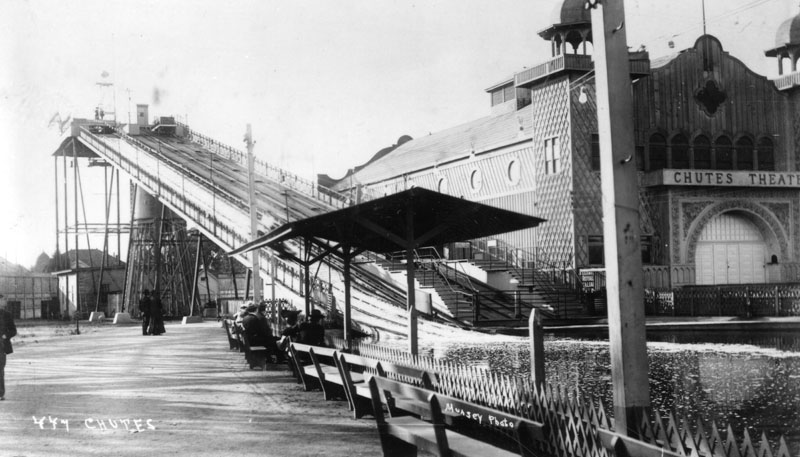 |
|
| (Early 1900s)* - Closeup view of the Chutes Water Slide and Chutes Theater. Several people are seen sitting on the bench waiting for the next boat to come splashing down into the lake. |
Historical Notes The park featured such rides as a roller coaster, a chutes water slide that dropped riders in boats from a 75-foot tower into a manmade lake (as seen above), and a miniature railroad. The park's merry-go-round was electrically powered, as was the engine that pulled the boats back up from the lake to the tower.* |
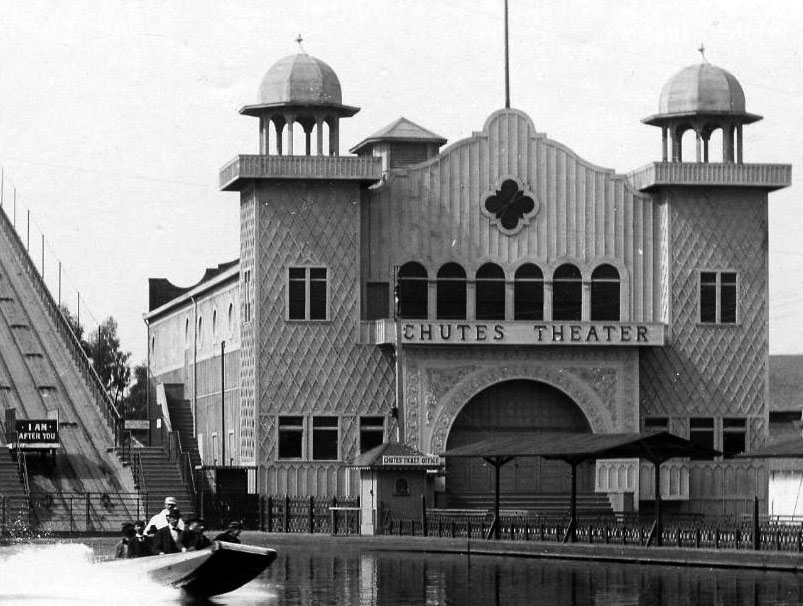 |
|
| (ca. 1901)^#^ - View of a water slide splashing down into the Chutes' lake. The beautiful ornate Chutes Theater stands on the right. |
Historical Notes The site also included, at various times, such exotic diversions as a seal pond, ostriches and the interestingly named House of Trouble and Cave of the Winds. By 1901, it also had a 4,000-seat theater and a baseball park that seated 10,000.* |
.jpg) |
|
| (1901)* - A birdseye view of the Washington Gardens Amusement Park from the top of the Chutes water ride. |
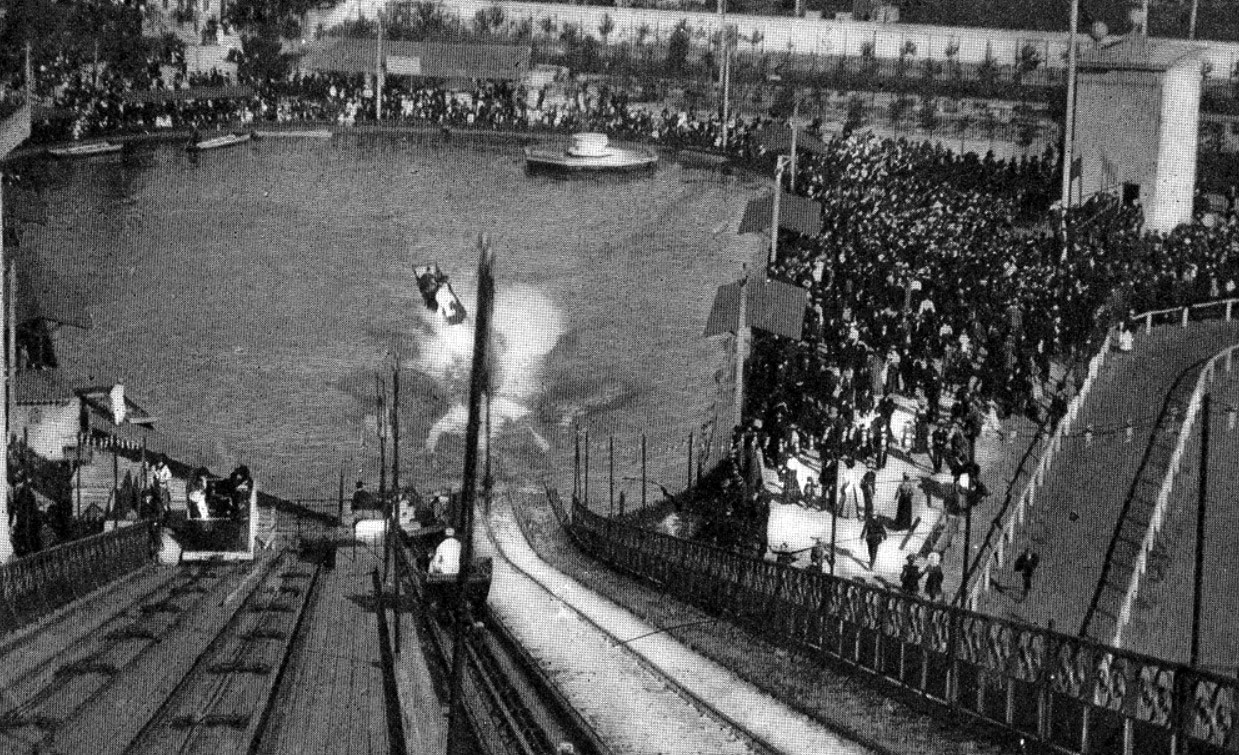 |
|
| (ca. 1905)^#^ – "Shooting the Chutes" - View looking down from the top of the Chutes water slide just as the boat hits the water and bounces up into the air. Note the large crowd below. |
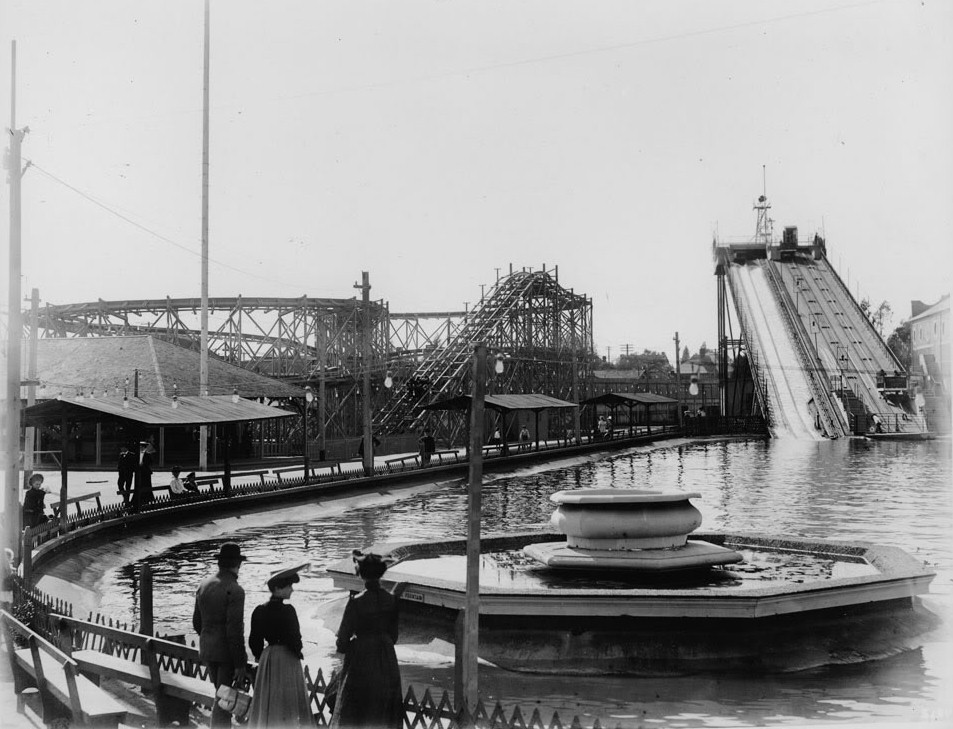 |
|
| (ca. 1906)^^ - A man and two women stand in the foreground near a fountain situated near the edge of a pool. On the other end of the pool is the main attraction, the tall Chutes Slide with water trickling down. Next to the slide is a mechanical lift, which is used to carry thrill-seekers to the top of the slide. On the outer edges of the pool are benches where people can be seen seated or walking by. At left are the circular and winding tracks of a roller coaster. The sign at the ticket booth reads: "Tickets 10¢, children 5¢". There are several signs on the roller coaster tracks that read: "danger, don't stand up". |
Historical Notes The steel-framed figure-eight roller coaster seen adjacent to Chutes Slide was built in 1903.* |
.jpg) |
|
| (1905)^#^– Postcard view showing both the Chutes Slide and the Chutes Theatre as seen from behind the “Electric Fountain”. |
Historical Notes In 1910 the park was sold to new owners (including Frederick Ingersoll) and reopened as Luna Park. The amusement park closed in 1914. Frederick Ingersoll was an inventor, designer, and builder who created the world's first chain of amusement parks (known collectively as "Luna Parks" regardless of their actual name) and whose manufacturing company built 277 roller coasters, fueling the popularity of trolley parks in the first third of the Twentieth Century.* |
 |
|
| (ca. 1911)^#^ - Panoramic view of the Chutes Park (also known as Washington Park). It was located on the north end of Chutes Park on Washington Blvd. and Main Street. This was the first home of the Los Angeles Angels. The Chutes Park water slide is visible beyond right field. |
Historical Notes: In 1900, a baseball diamond was completed on the northern end of the Chutes Park, with a team to play in the new California League. It would be the first team to be called the Los Angeles Angels. It was also home of the Vernon Tigers. Following games, a gate in the center field fence was opened and fans were allowed to enter the theme park.^ Click HERE to see more on the Chutes Baseball Park (also, known as Washington Park) in Baseball in Early L.A. |
* * * * * |
Lincoln Park (Eastlake Park)
 |
|
| (ca. 1910)^*^# – Postcard view showing a couple in a boat on Eastlake Park (previously Lincoln Park). On back of the postcard is a marketing slogan for Los Angeles that reads "On the Road of a Thousand Wonders." |
Historical Notes Lincoln Park was originally created by the City of Los Angeles in 1881, from land donated by John Strother Griffin. It was one of Los Angeles' first parks. It was originally called East Los Angeles Park. By 1901 it had become a major amusement center for the people of Los Angeles, and it was at this time that the name was changed to Eastlake Park. On May 19, 1917, the park was renamed Lincoln Park after Lincoln High School.* |
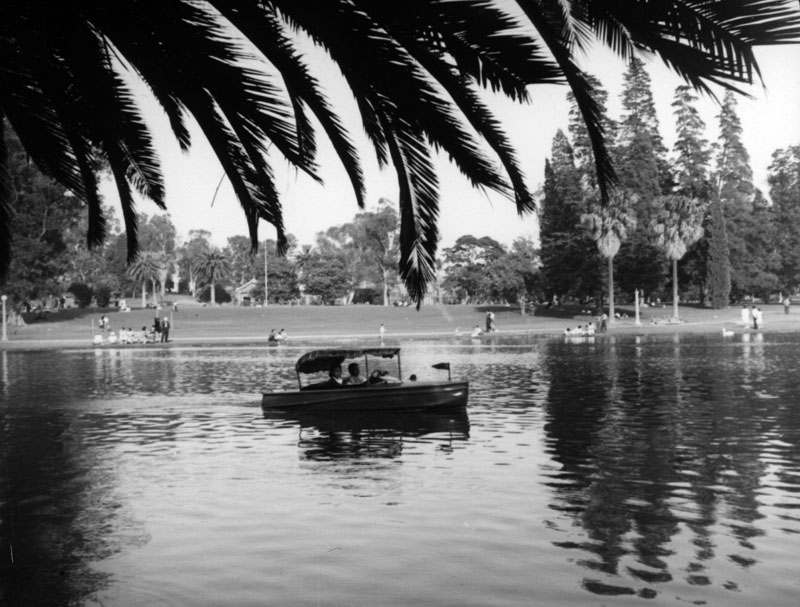 |
|
| (Early 1900s)* - A couple can be seen relaxing and enjoying a nice sunny day as their canopied boat floats across Lincoln Park (Eastlake Park) lake, its surface giving a lovely reflection of the trees in the surrounding area. Several people can be seen on shore at the other end of the lake. |
* * * * * |
Los Angeles Alligator Farm (later California Alligator Farm)
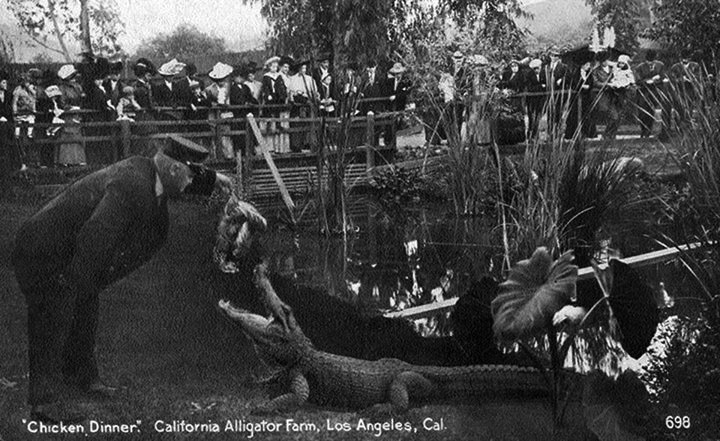 |
|
| (ca. 1907)^#* - Postcard view showing a park employee feeding a whole chicken to an alligator at the Los Angeles Alligator Farm across from Eastlake Park. |
Historical Notes The Los Angeles Alligator Farm was a major city tourist attraction from 1907 until 1953. Originally situated across from Eastlake Park (later Lincoln Park), at 3627 Mission Road. In 1953 the farm moved to Buena Park, across from Knott's Berry Farm, where it was renamed the California Alligator Farm. It closed shortly thereafter.* |
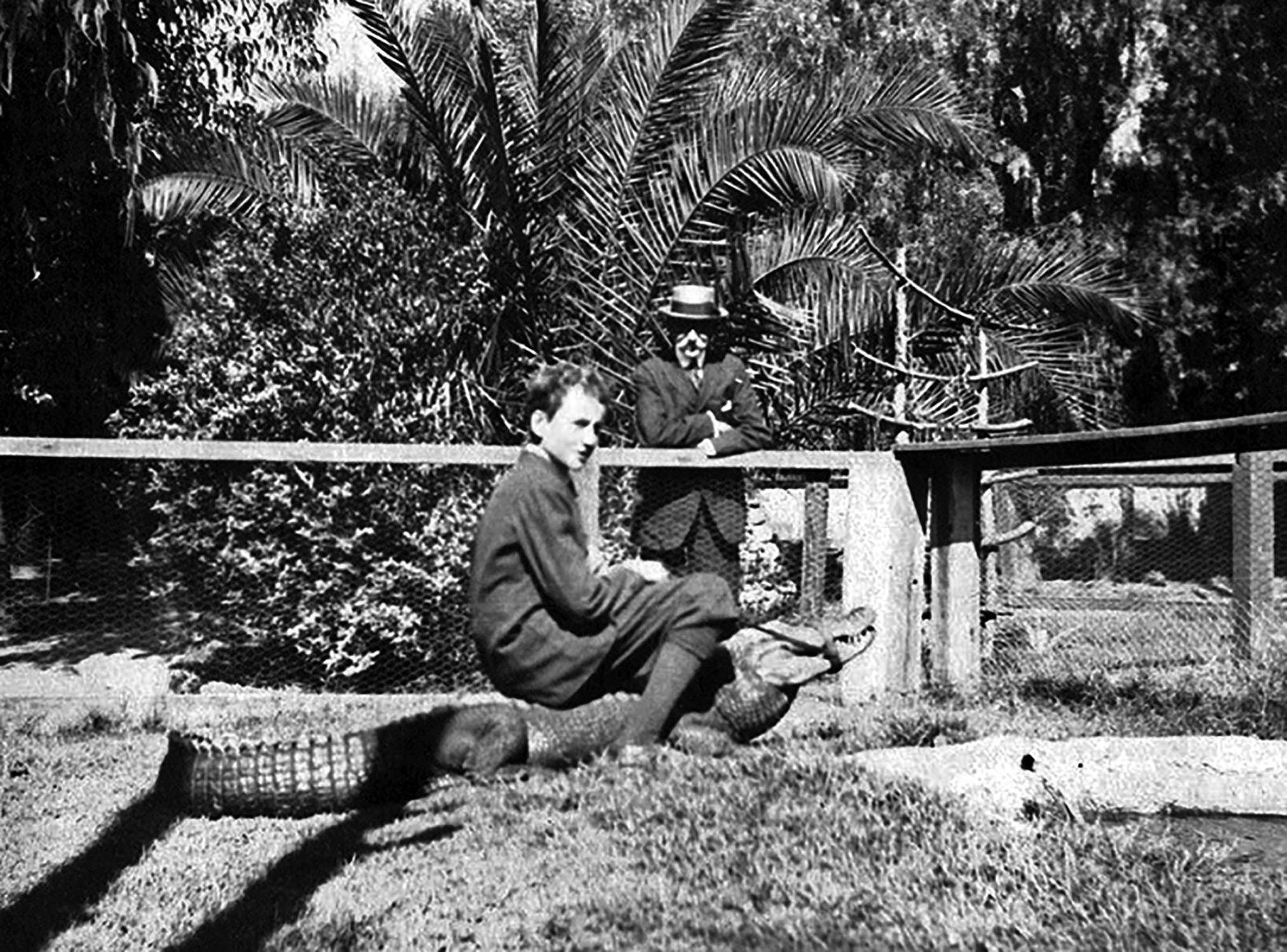 |
|
| (ca. 1919)^*^# – View showing a young man sitting on top of an alligator at the Los Angeles Alligator Farm near Lincoln Park (previously Eastlake Park). |
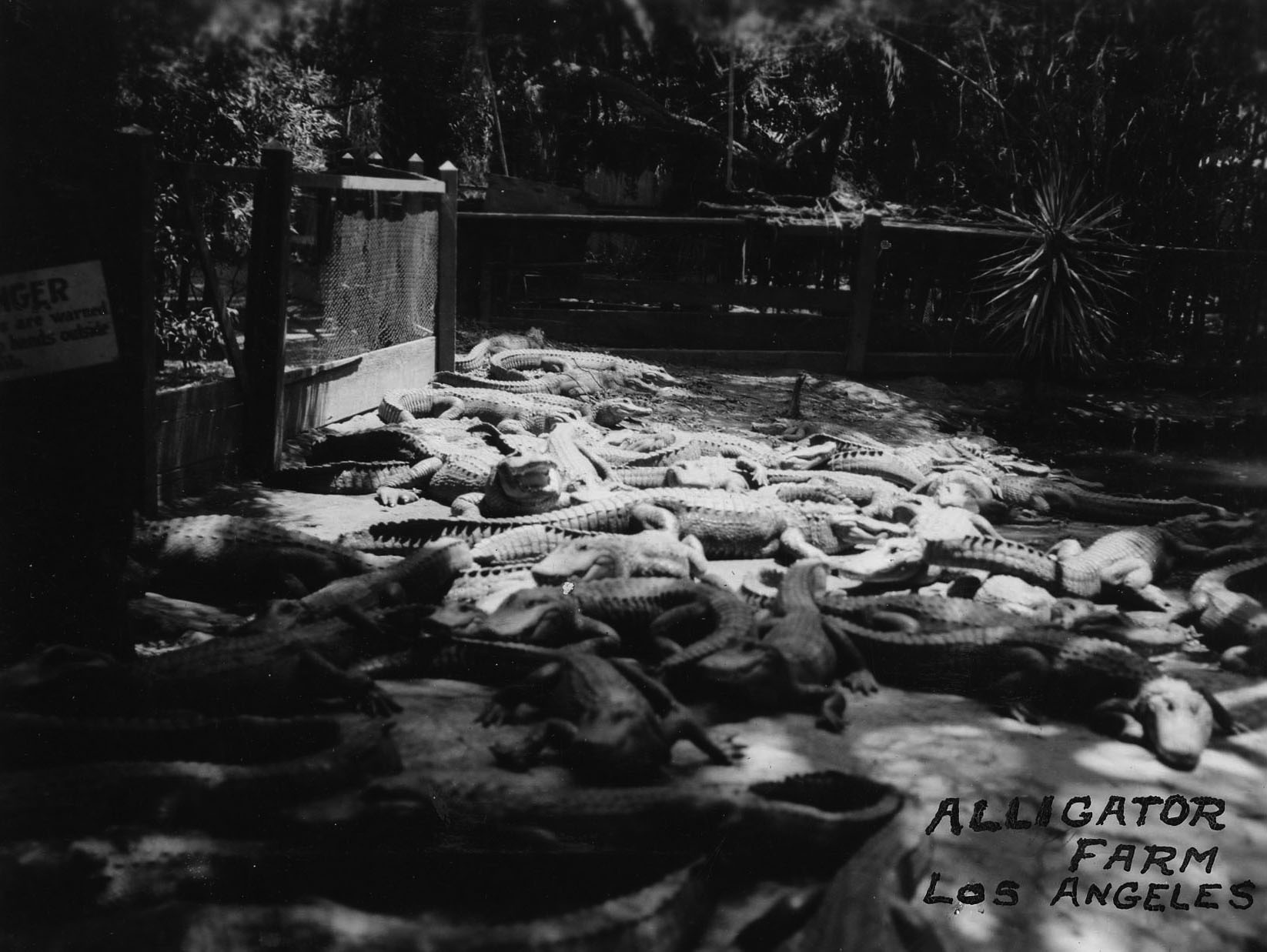 |
|
| (ca. 1935)^*# – A large group of alligators are seen in a pen at Alligator Farm in Los Angeles. |
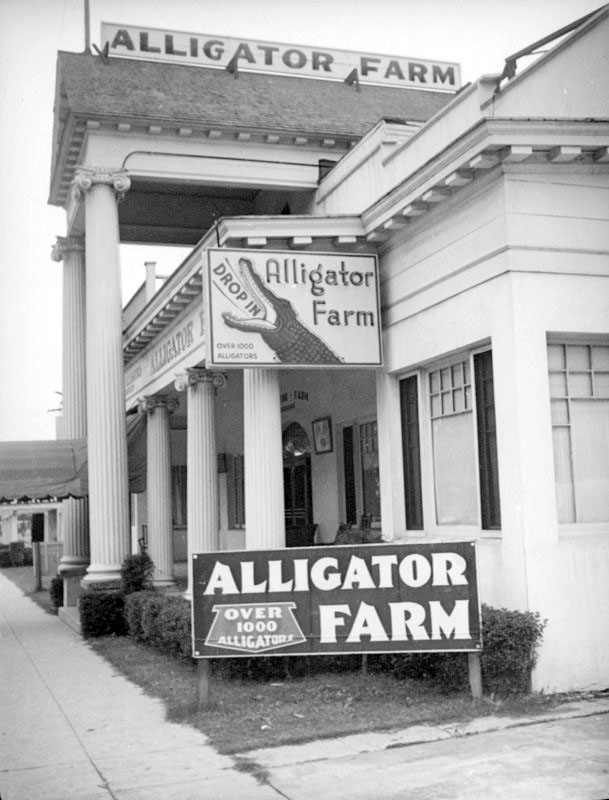 |
|
| (ca. 1939)* – Four different signs grace the Colonial Revival architecture of the Los Angeles Alligator Farm: a rooftop sign so large it needs its own towering columns, two neon signs including one of a snapping alligator, and a temporary looking yard sign that promises over 1000 alligators. |
* * * * * |
Selig Zoo
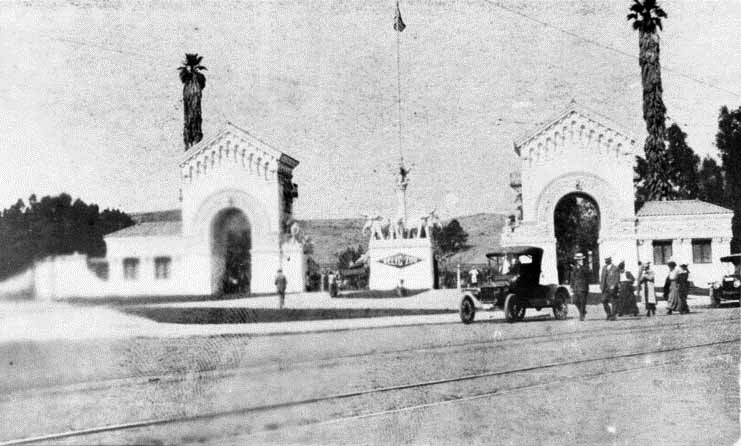 |
|
| (ca. 1916)* - The grand entrance to the privately owned Selig Zoo, located at 3800 North Mission Road in Eastlake Park (later Lincoln Park). |
Historical Notes In 1913 William Selig had gathered a large collection of animals for his films and spent substantial funds acquiring and developing 32 acres of land in Lincoln Heights northeast of downtown Los Angeles, where he opened a large public zoo. In 1914 a carousel was added, which drew 150,000 riders a year; and a short while later, an arboretum was erected on the premises that housed a large greenhouse (hothouse) with rare and exotic plants. The Selig Zoo, also served as a film production studio for the Selig Polyscope Company, and briefly the Louis B. Mayer Pictures Corporation. Dramatic entrance gates featuring statues of elephants and lions were designed by Italian sculptor Carlo Romanelli, with interior structures by Arthur Burnett Benton.* |
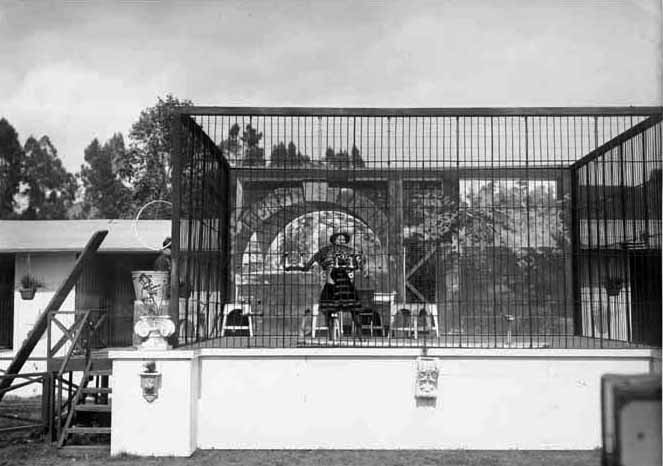 |
|
| (ca. 1915)^*# - A woman in a cage is seen holding a leopord in her arms at the Selig Zoo and Wild Animal Farm. |
Historical Notes The first Tarzan movie was filmed at Selig Zoo. It was the only zoo south of San Francisco. In time, it became the largest collection of wild animals in the world. |
 |
|
| (ca. 1915)^*# - View of the front entrance to the Selig Zoo. Admission Price: 10 Cents! |
Historical Notes As well as being open to the general public, Selig Zoo provided a habitat for exotic animals used in motion pictures produced by Selig Polyscope Company. It was headquartered in the old Indian Exposition Building in Lincoln Park, off Mission Road in East Los Angeles. "Selig Place" still intersects Mission Road today. This area later became "Luna Park," a popular amusement area and zoo.^*# Selig Polyscope became insolvent in 1918, and over the years the zoo changed names and ownership. It was known as the Selig Zoo (1915-1925), Luna Park Zoo (1925-1931), L.A. Wild Animal Farms (1931-1932), the California Zoological Gardens (1932-1936), and Zoopark (1936-1940). The zoo officially closed in 1940 and many of the animals were relocated to the Los Angeles Zoo in Griffith Park.* |
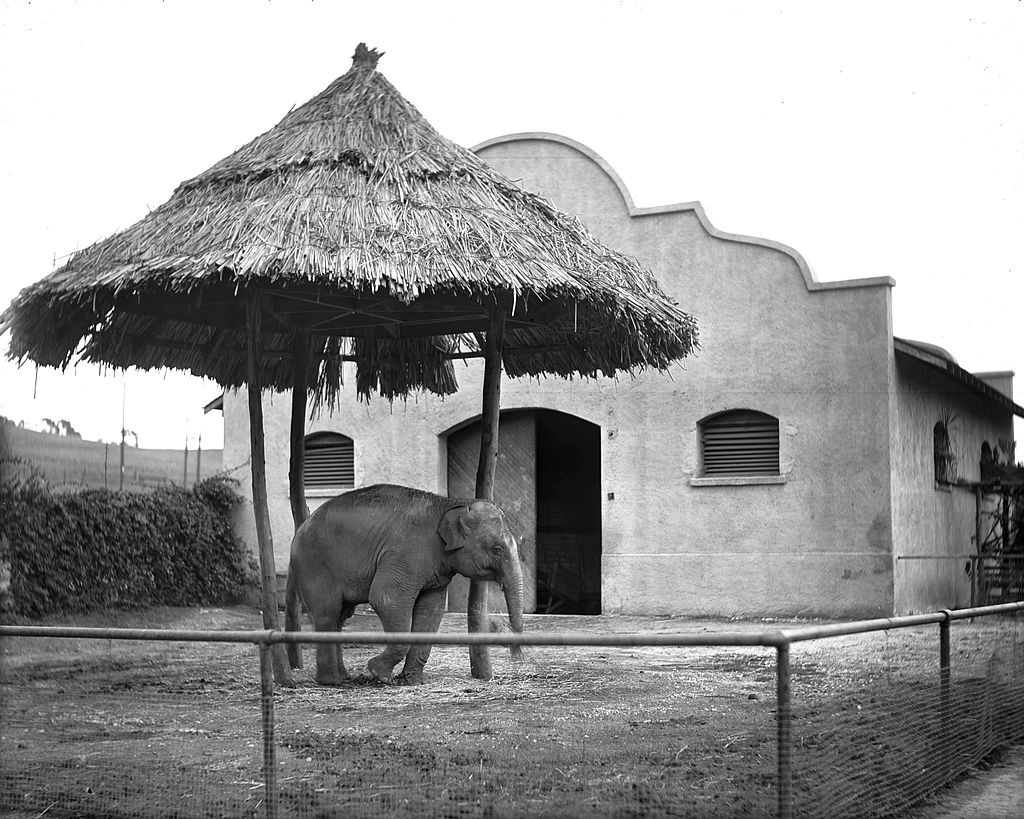 |
|
| (1920)*^ - Asian elephant standing under a conical straw shelter at the Selig Zoo. |
Historical Notes The first Tarzan movie was filmed at Selig Zoo. It was the only zoo south of San Francisco and, in time, it became the largest collection of wild animals in the world. |
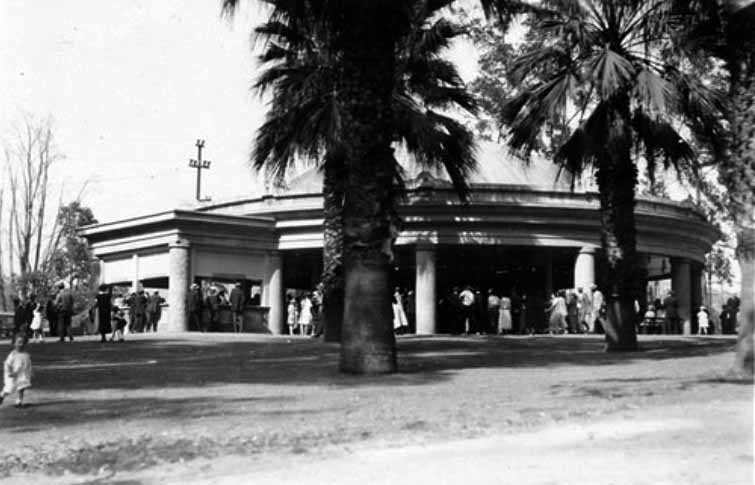 |
|
| (ca. 1924)^^** - View showing the 1924 Spillman, Lincoln Park's second carousel. |
Historical Notes On May 19, 1917, the City Council responded to a petition from nearby residents and renamed the area Lincoln Park, named after nearbyLincoln High School.* The Lincoln Park Carousel was destroyed by arsonists in August, 1976, just four months after being designated Los Angeles Cultural-Monument No. 153 (Click HERE to see complete listing).^^** |
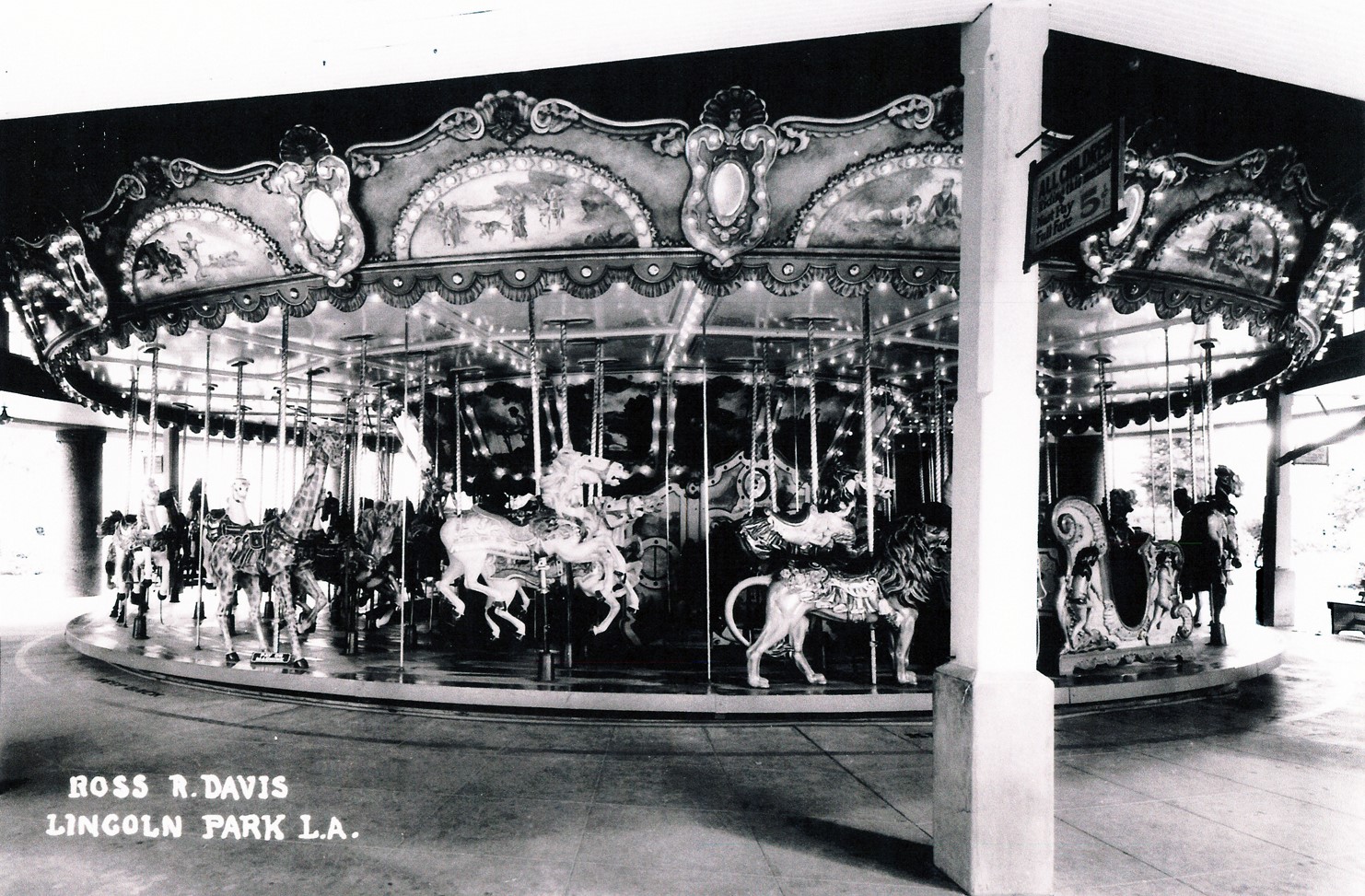 |
|
| (ca. 1924)* - Close-up view of the Lincoln Park's second carousel. It stood until 1976, when it when it burned down. |
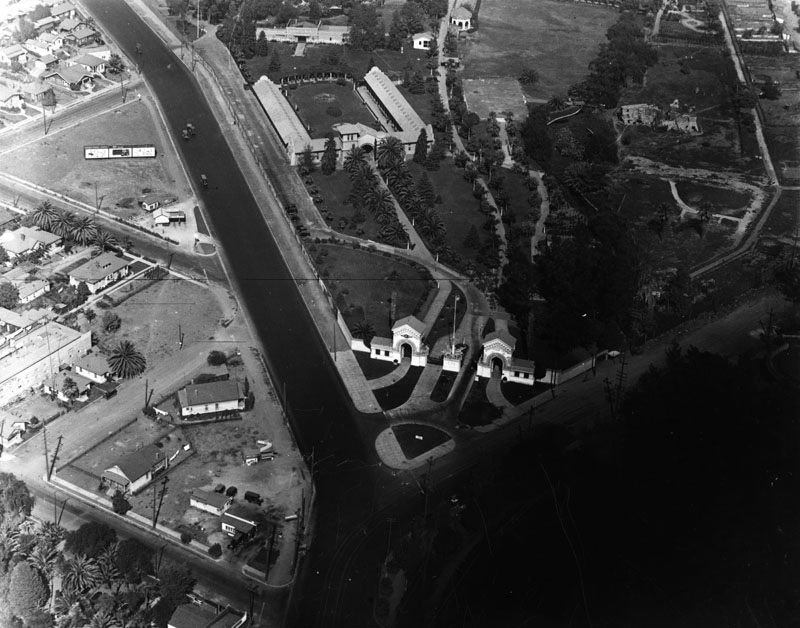 |
|
| (1924)* - Aerial view of the Selig Zoo. The zoo's entrance is marked by the two arches (right of center), where N. Mission Road (running from upper left to lower center) meets Selig Place (running right center to lower center). |
 |
|
| (1924)#^- View of the front entrance to the Selig Zoo located at Lincoln Park. An American flag flys between the two ornate archways that act as the entry point to the zoo. Elephant statues surround the base of the flagpole. |
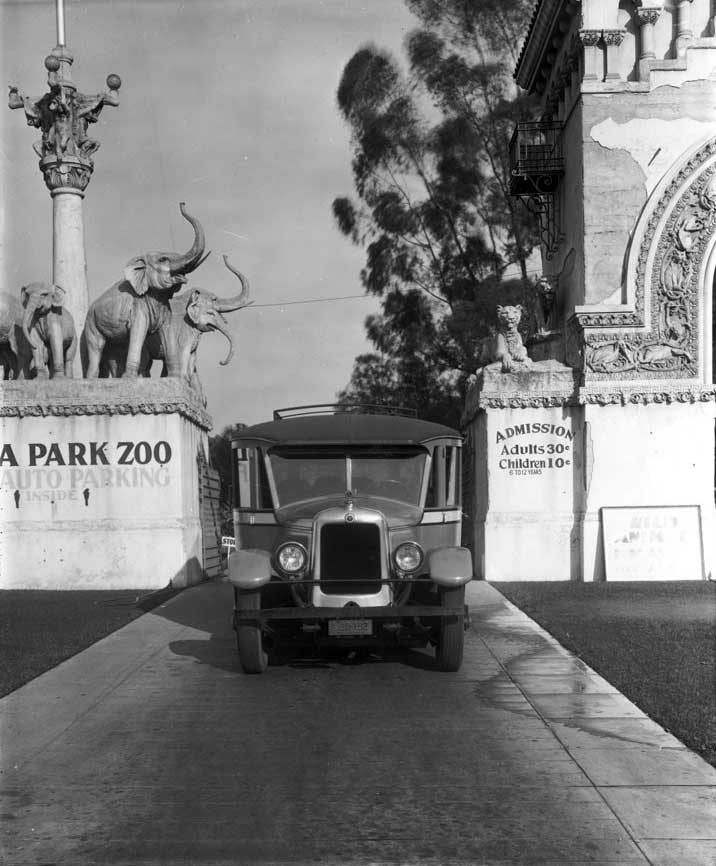 |
|
| (1928)^#^ - Bus transportation to Selig Zoo. The price of admission is posted on the wall. |
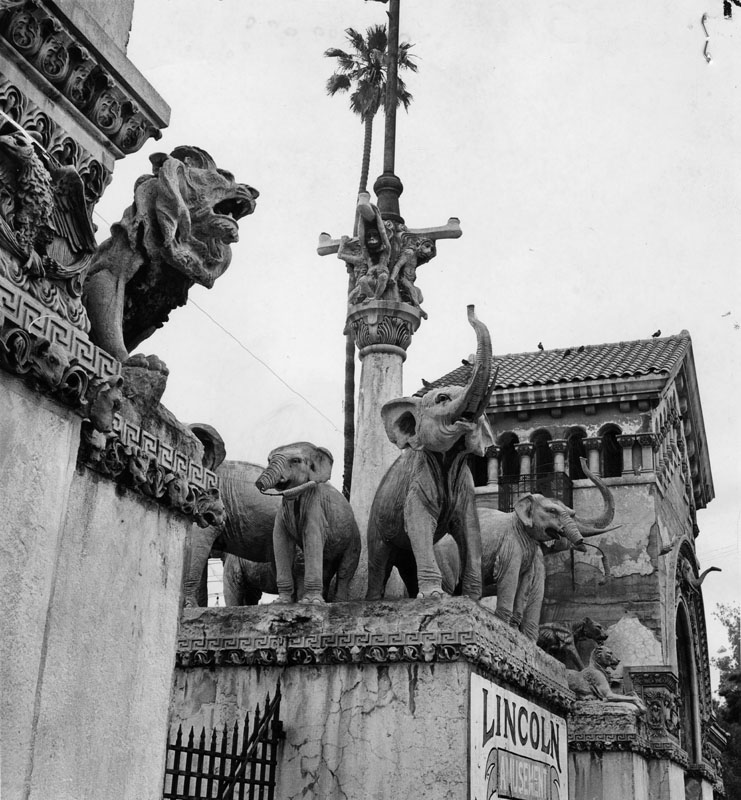 |
|
| (1962)* - The once grand entrance to the old privately owned zoo in Lincoln Park shows signs of decay and neglect. The zoo closed following a flood in the early 1930's. |
Historical Notes The Mission Road grounds of the Selig Zoo would subsequently serve as the Lincoln Speedway and the Lincoln Amusement Park, before being redeveloped in the 1950s. The entrance gates would remain standing into the 1960s, before being dismantled and moved to an Inland Empire junkyard.* |
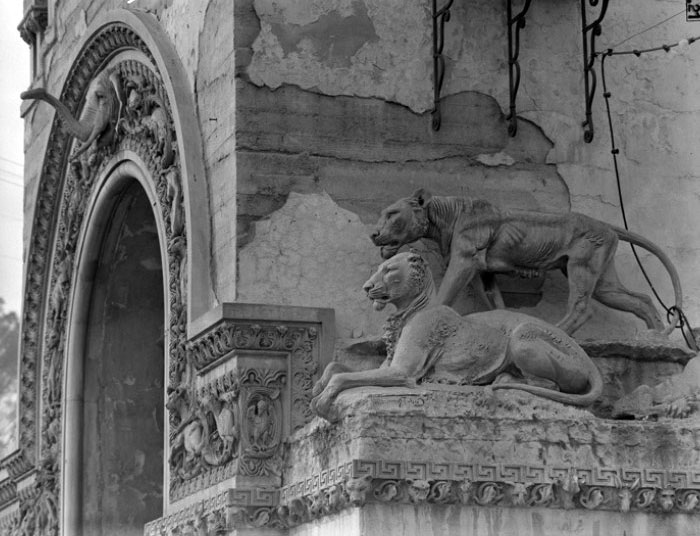 |
|
| (1955)* - Close-up view of the entrance gate to the old Selig Zoo showing two lion sculputers. Note the design details of the arch. |
Historical Notes When the structure was demolished, some of the concrete sculptures disappeared into storage until they resurfaced sometime in 2000. Seven lion sculptures (including these two beauties) were restored and now live in the Los Angeles Zoo. #^ |
* * * * * |
Mt. Lowe Railway
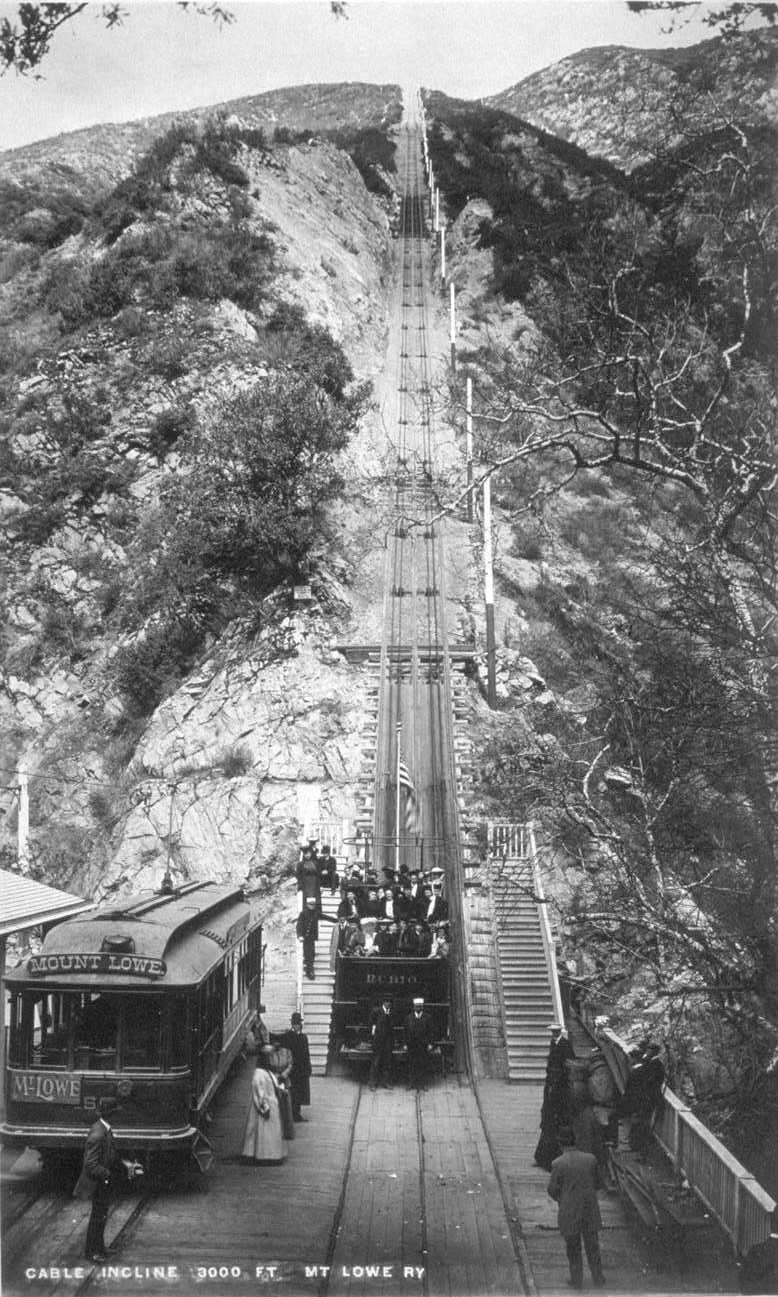 |
|
| (1893)^^ - The great Cable Incline went from Rubio Pavilion (the bottom) to Echo Mountain (at the top). In this picture one of the cable cars, named "Rubio" sits at the bottom with some passengers aboard and others waiting nearby. Also on the left is the electric car which brought customers to the station from Mountain Junction. |
Historical Notes At the turn of the century (1893 - 1938), a famous Pacific Electric excursion was the Mt. Lowe trip. From Los Angeles, sightseers took a Pasadena car to Altadena and Rubio Canyon. They then transferred to a cable car on the Incline Railway that went up a 62% grade to Echo Mountain. From there they would take a narrow-gauge trolley car winding its way up the rugged San Gabriel Mtns. and finally would arrive at Alpine Tavern on Mt. Lowe, a nearly 7 mile railway ride from the base of the mountain. The views were spectacular and on most days Catalina Island, over 60 miles away, could be clearly be seen.* |
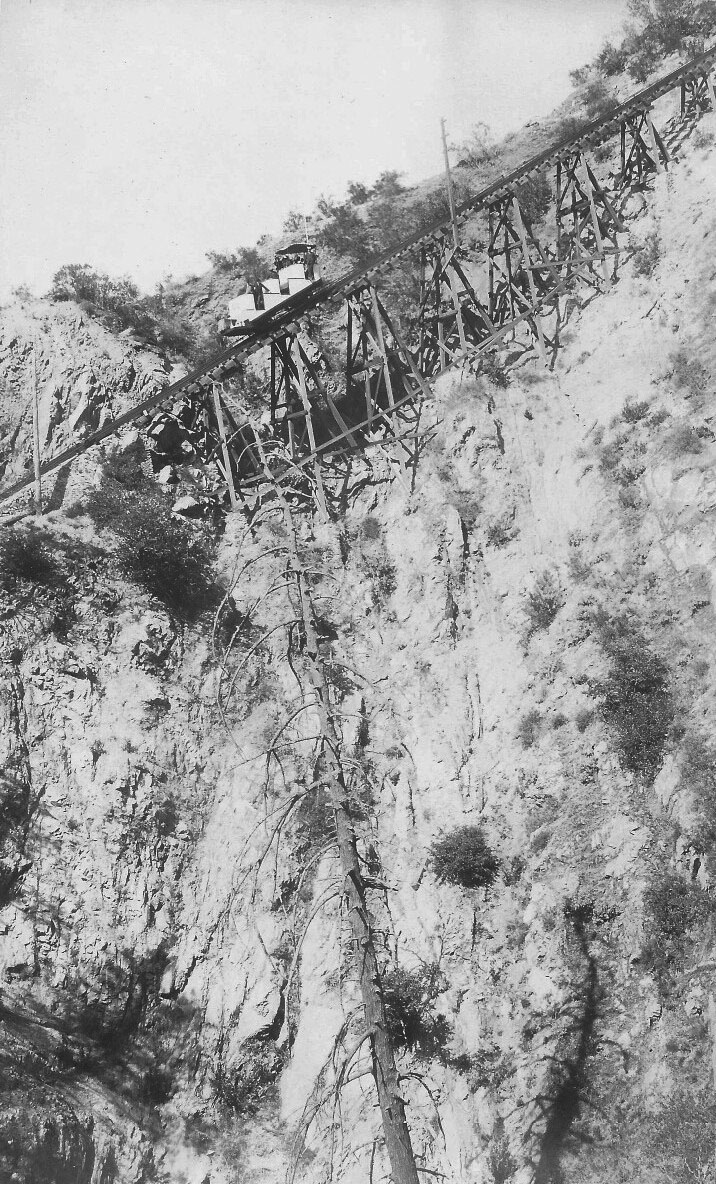 |
|
| (1890s)^#^ - Profile view of Mount Lowe's Cable Incline showing its steep 62% grade. |
Historical Notes The incline grade changed three times from a steep 62% grade at the base to a gentler 48% grade at the top, but the cars were designed to comfortably adjust to the differences in grade. The incline was also equipped with a safety cable which ran through an emergency braking mechanism under each car and provided an emergency stopping of the cars within 15 feet should a failure of the main cable occur.*^ |
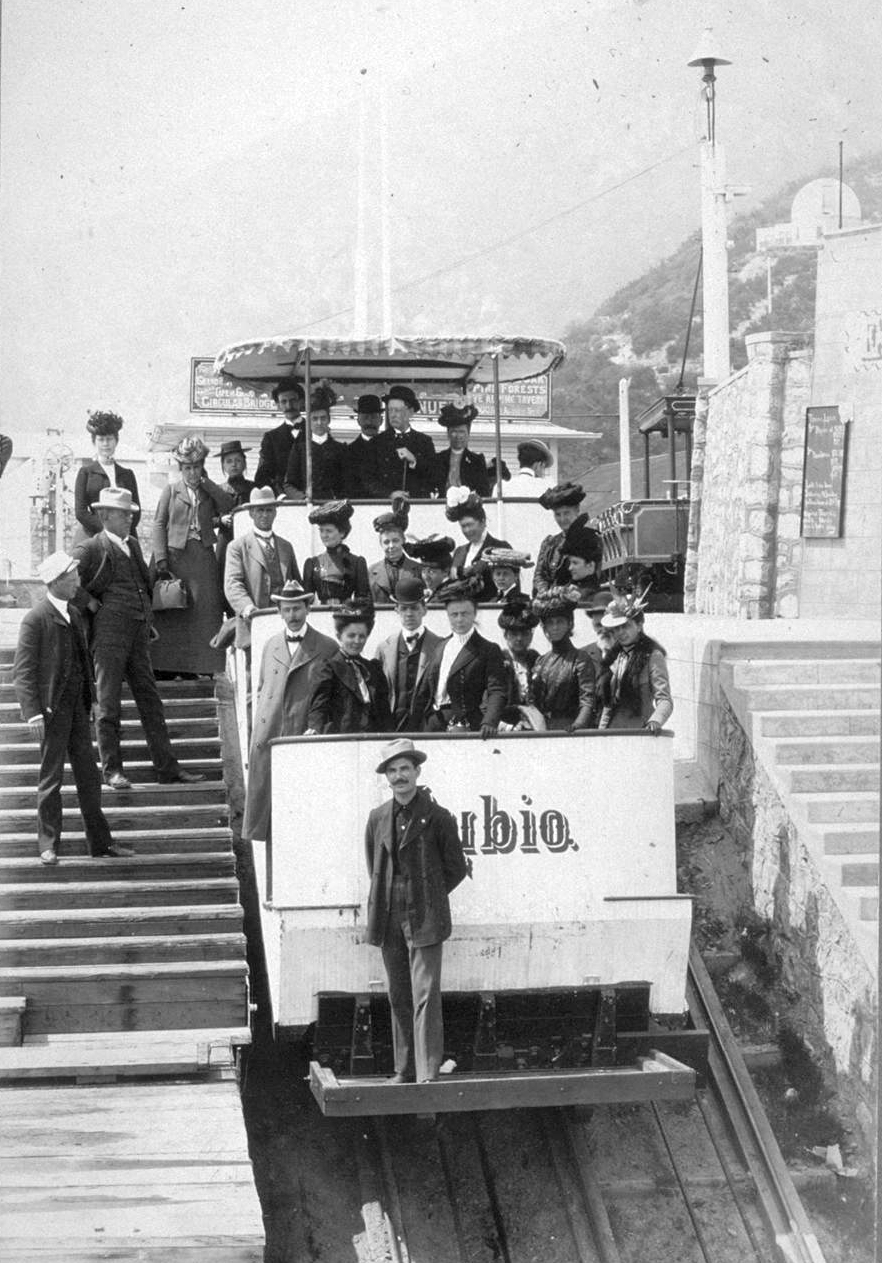 |
|
| (n.d.)* - Visitors to Echo Mountain pose on one of the Incline opera-box cable cars (called 'White Chariots') which transports them on the Mount Lowe Railway. |
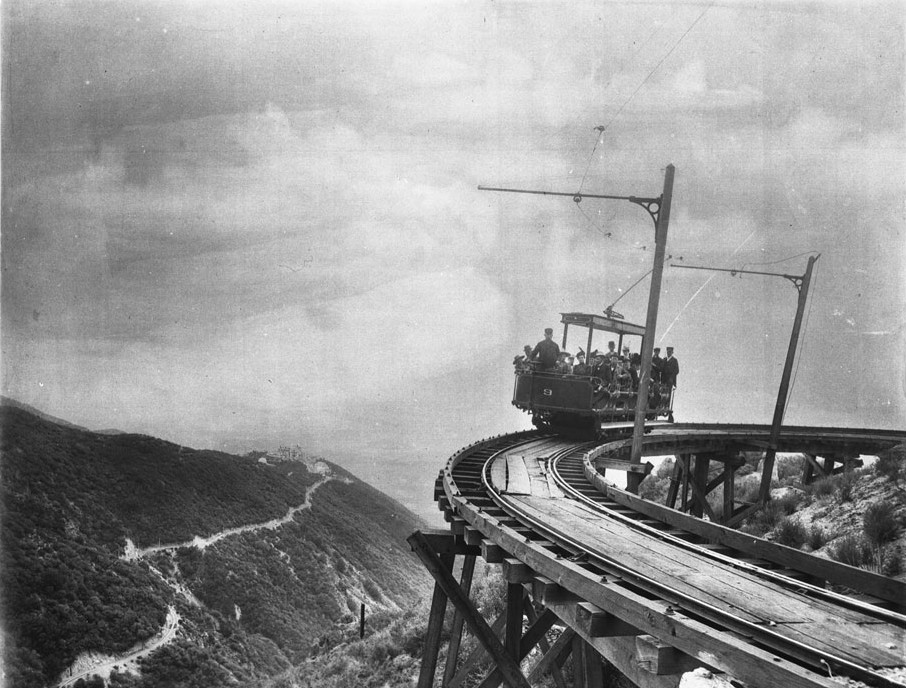 |
|
| (1893)^^ - Photograph of the first passengers of Professor S.C. Lowe's dramatic Mount Lowe Railway, July 4, 1893. There are a couple of dozen people in the rail car (number "9") which is headed toward the camera on the circular bridge. The trestle structure is visible below the rails. The hotel on the mountaintop is visible at left as is the rail approach to the hotel. |
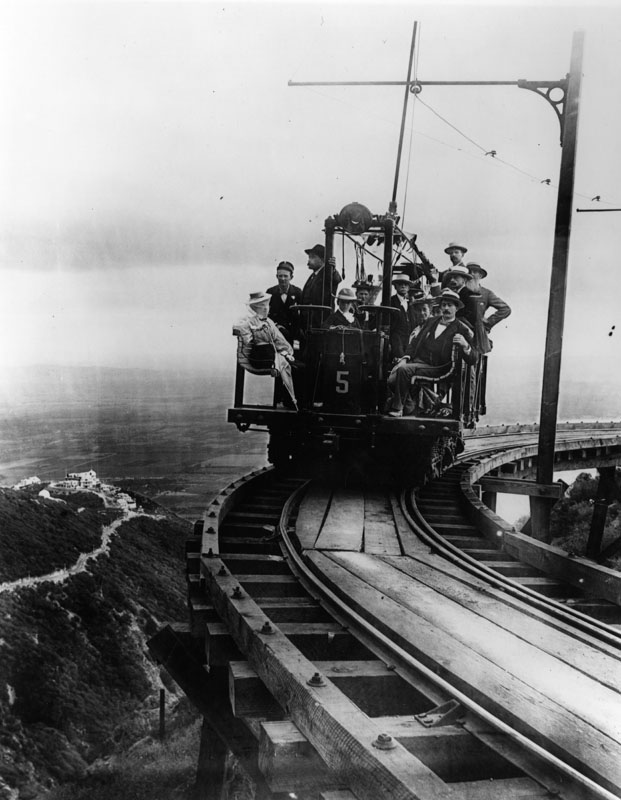 |
|
| (ca. 1894)* - A group of sightseers travels on one of the trolley cars on the Mount Lowe Railway as it rounds the area of track known as the Circular Bridge. Passengers can look out and have a spectacular view of Echo Mountain and its building complex (to the left) and the valley floor below. |
Historical Notes Over its 45 years of existence, it is estimated that some 3 million people had ridden the railway, many coming from all parts of the country and the world. In its own inimitable way, it was a Disneyland of the day. Click HERE to see more in Early Views of Mt. Lowe Railway |
* * * * * |
Arcadia Hotel and the 'Switchback Roller Coaster'
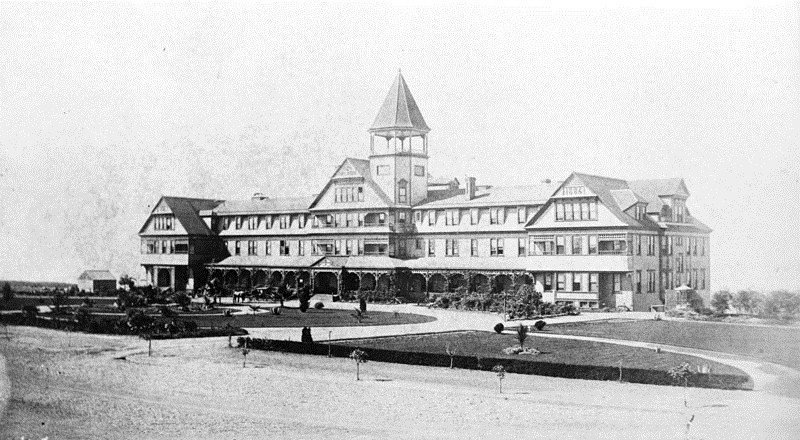 |
|
| (ca. 1887)* - Exterior view of the east front of the Arcadia Hotel in Santa Monica soon after its construction. It opened in March 1887. It was located on Ocean Avenue immediately south of the bridge over the gulch that was later occupied by Roosevelt Highway. |
Historical Notes In the mid-1880s, tourism in Santa Monica was booming. Roughly 2,000 to 3,000 tourists visited Santa Monica in the summer of 1887. The owner of the former Santa Monica Hotel, J. W. Scott, constructed a massive new hotel, the Arcadia Hotel, in 1887, located near the site of the original Santa Monica Hotel at the corner of Ocean Avenue between Colorado and Pico Boulevard. The luxurious Arcadia Hotel had 125-rooms and featured the latest amenities. |
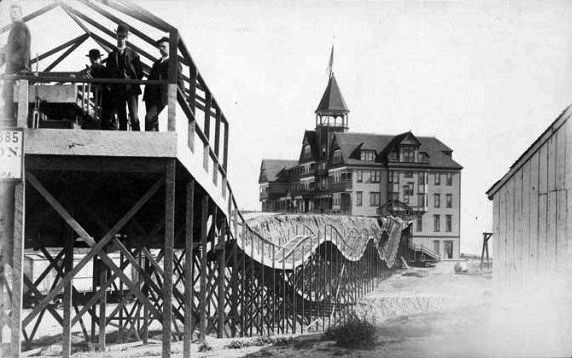 |
|
| (ca. 1887)*^* - View of the 'Switchback Roller Coaster' at the Arcadia Hotel. Four men are seen standing on the roller coaster's platform. |
Historical Notes The pinnacle of the Arcadia Hotel was an observation tower, offering breathtaking views in every direction a dizzying 136 feet above the beach level. A further delight for guests was a two-track gravity switchback roller coaster, which in a one minute journey, could whisk guests either to or from the hotel and back again, all for the price of a nickel. |
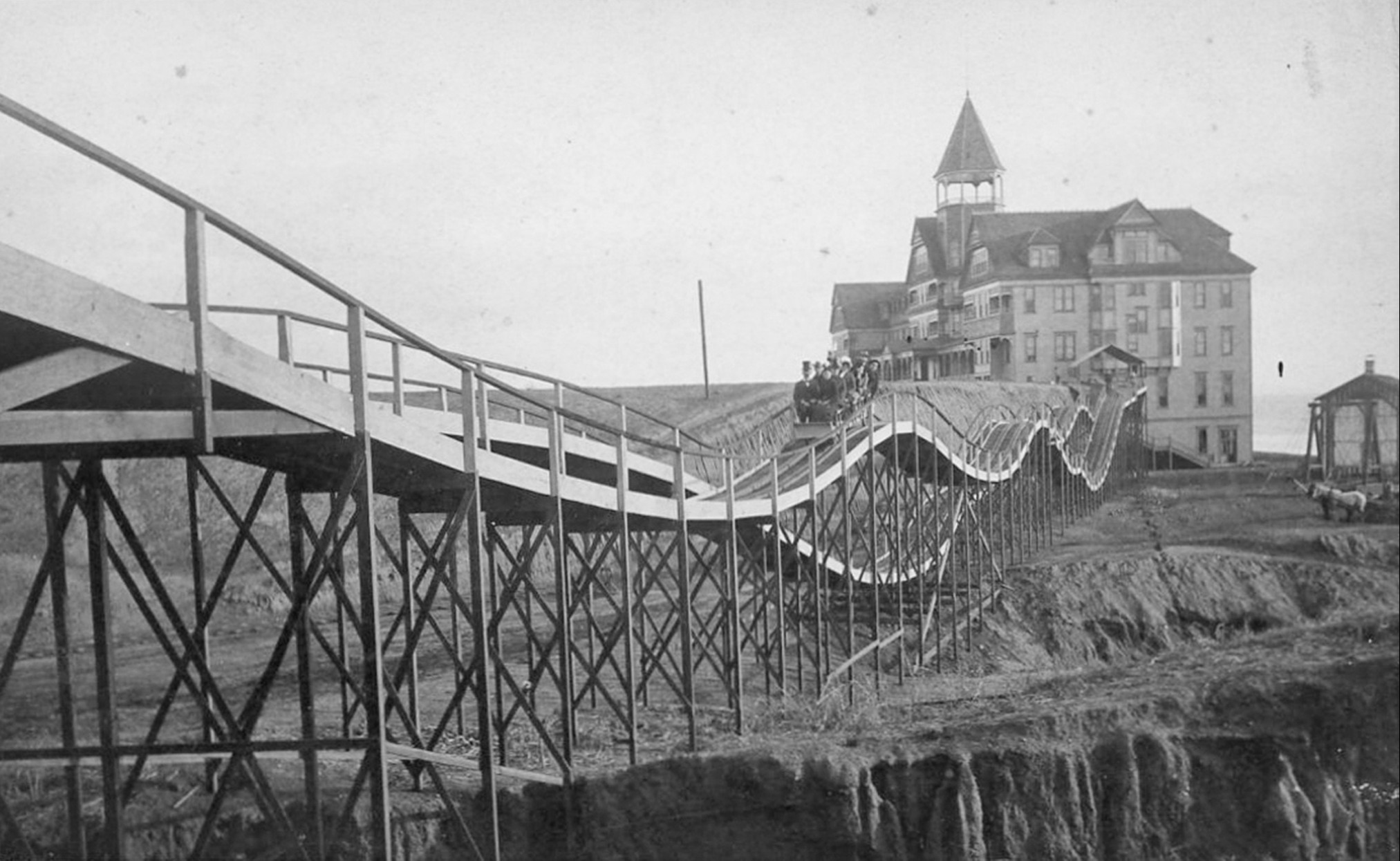 |
|
| (1880s)* - View of the switchback roller coaster in motion halfway between the Arcadia Hotel and its end point on the Santa Monica bluffs. |
Historical Notes The original Switchback Railway (Coney Island) was the first roller coaster designed as an amusement ride in America. It was designed by LaMarcus Adna Thompson in 1881 and constructed in 1884. It appears Thompson based his design, at least in part, on the Mauch Chunk Switchback Railway which was a coal-mining train that had started carrying passengers as a thrill ride in 1827. |
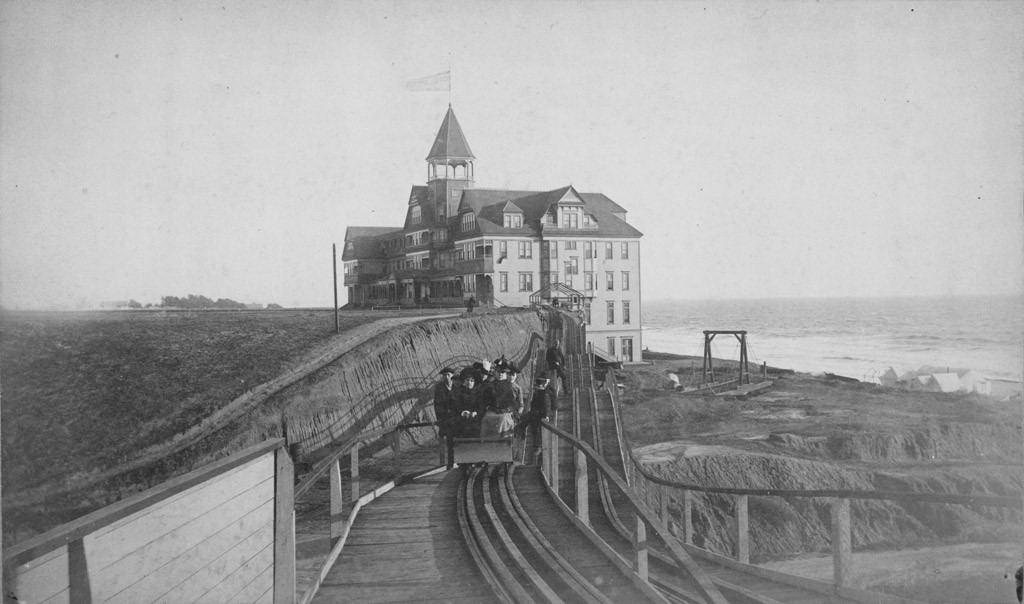 |
|
| (ca. 1887)#^^ - View showing several men and women in a roller coaster as it comes to the end of its ride across the Santa Monica bluffs. In the background is seen the Arcadia Hotel with a flag flying high from the top of its observation tower. |
Historical Notes Click HERE to see more Early Views of Santa Monica |
* * * * * |
Venice of America and Kinney Pier
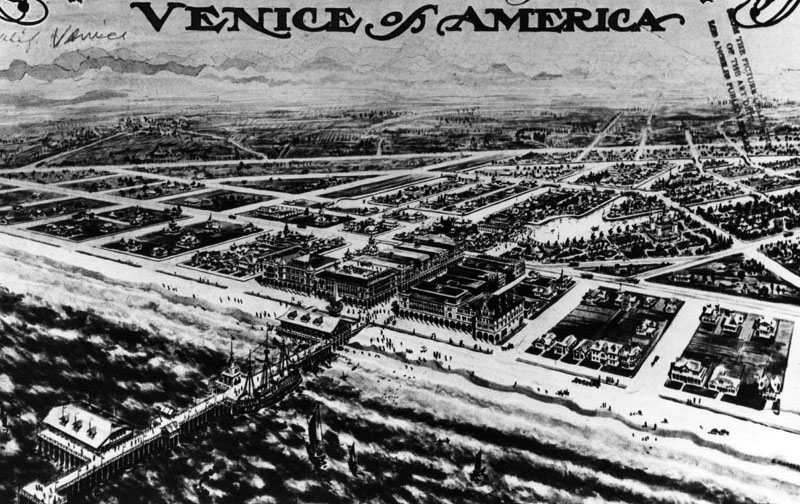 |
|
| (ca. 1905)* - A photograph of an illustrated panoramic view of Venice, revealing all of the original Venetian style buildings and businesses along the Ocean Front Promenade, such as the Ship Café on the Pier, the Venice Bath House, and the Pavilion. Various styles of residences have also been captured in this rendering. |
Historical Notes Venice of America, the precursor to today's Venice Beach, was founded in 1905 by visionary developer Abbot Kinney as a seaside resort town in Southern California. Inspired by the Italian city of Venice, Kinney transformed miles of marshland into a whimsical wonderland featuring an intricate network of canals, Venetian-style architecture, and a grand amusement pier. |
 |
|
| (ca. 1905)* - There are wall to wall people filling Windward Avenue in Venice of America, all looking and moving toward the ocean. "VENICE" is strung above their heads over the street in large letters. A Pacific Electric Railway (Red Car) is seen on the right. |
Historical Notes When Venice of America opened on July 4, 1905, Kinney had dug several miles of canals to drain the marshes for his residential area, built a 1,200-foot long pleasure pier with an auditorium, ship restaurant, and dance hall, constructed a hot salt-water plunge, and built a block-long arcaded business street with Venetian architecture. Tourists, mostly arriving on the "Red Cars" of the Pacific Electric Railway from Los Angeles and Santa Monica, then rode Venice's miniature railroad and gondolas to tour the town. |
 |
|
| (1905)* - Windward Avenue is filled with people strolling, and the air with banners strung from the Hunt Hotel on the left. A banner on the building to the near left declares that "St. Marks Hotel will open in early July". This was the grand opening celebration for Venice of America, July 4, 1905. |
Historical Notes The town's grand opening on July 4, 1905, drew large crowds eager to experience its unique attractions, including gondola rides, a hot salt-water plunge, and a miniature railway. Despite facing early challenges such as destructive winter storms that delayed its opening, Venice quickly became a popular destination, attracting between 50,000 to 150,000 weekend visitors by 1910. Click HERE to see more Early Views of Windward Avenue. Click HERE to see more Early Views of the Venice Canals. |
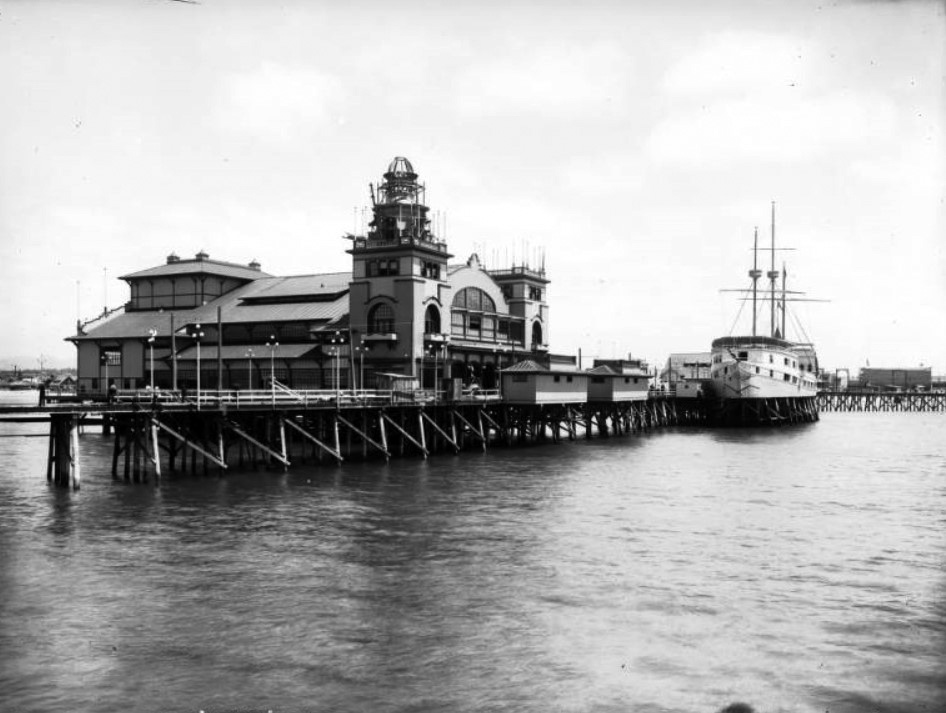 |
|
| (1905)* - View showing the Venice Pier, Venice Pavilion (with tower still under construction) and Ship Café |
Historical Notes The Ship Café and Dance Pavilion were iconic attractions on the Abbot Kinney Pier in Venice. The Ship Café, which began operating around 1905 and continued until 1946, was a unique restaurant designed to resemble the Spanish galleon San Salvador, built on concrete pilings over the water. It could seat up to 475 people and was known for its fresh seafood and nautical atmosphere. Adjacent to the Ship Café was the Dance Pavilion. The Dance Pavilion was a prominent attraction that opened in 1906, although it was not fully completed by the July 4th opening of the pier in 1905. The pavilion was constructed rapidly, with a workforce of 125 carpenters and electricians tasked with completing it in just 17 days. While the walls, roof, and a large hardwood dance floor measuring 14,560 square feet were finished in time for the July 4th dedication, the overall structure was not fully completed until the end of July. |
 |
|
| (1905)* - Ship Café and Dance Pavilion at Abbot Kinney Pier in Venice. |
Historical Notes The Dance Pavilion was notable for being the largest dance hall on the West Coast at the time, accommodating 800 couples. It was strategically located between the Venice Auditorium and the beach, contributing to Kinney's vision of transforming the pier into a vibrant amusement destination. Unfortunately, the original pavilion was destroyed by a fire on December 20, 1920, leading to its reconstruction in 1921. |
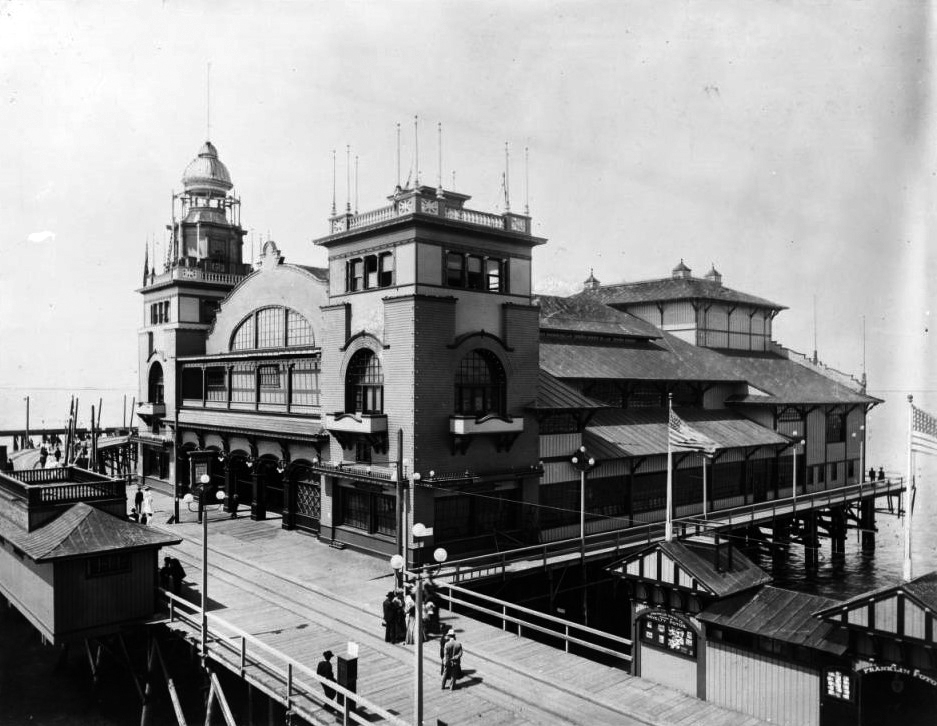 |
|
| (ca. 1905)* - View showing the Venice Pier Pavilion. The large complex of the pavilion is shown at center, stretching out from the main pier at a ninety-degree angle. Two towers flank either side of the main entrance, the farthest from the foreground bearing an ornate cupola. In the right foreground, two American flags extend from tops of what appear to be small photo booths which bear signs that read "Franklin Photo Co. Makers of Novelty Photos". |
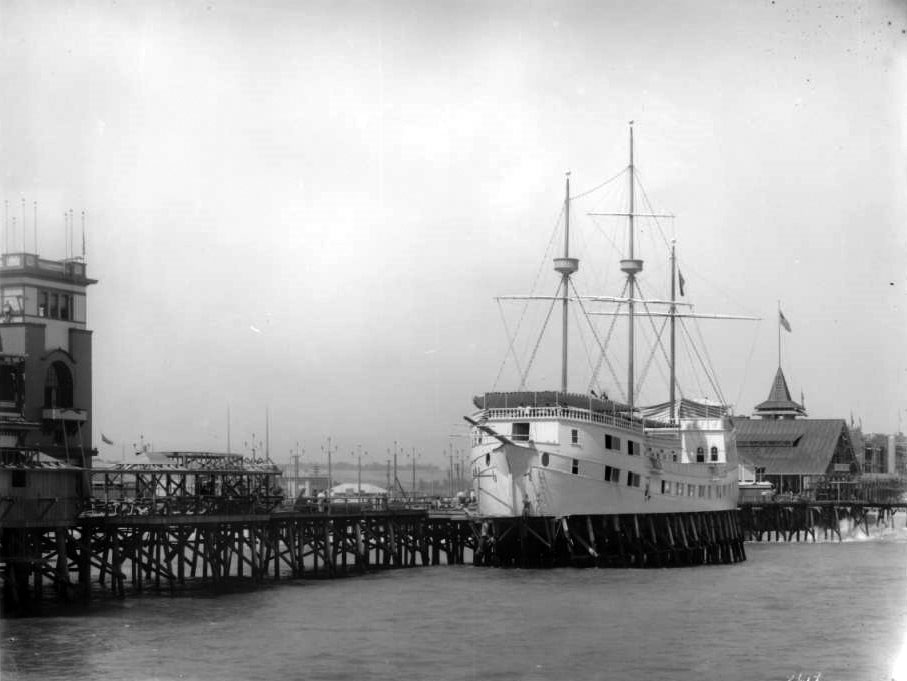 |
|
| (ca. 1905)* - View of the Wharf and Pavilion at Venice Beach with Ship Café. The Ship Café, a restaurant which resembles a large, lightly-colored ship, sits over the water along the side of the wharf at center. The corner of the large Pavilion building can be seen on the far left. |
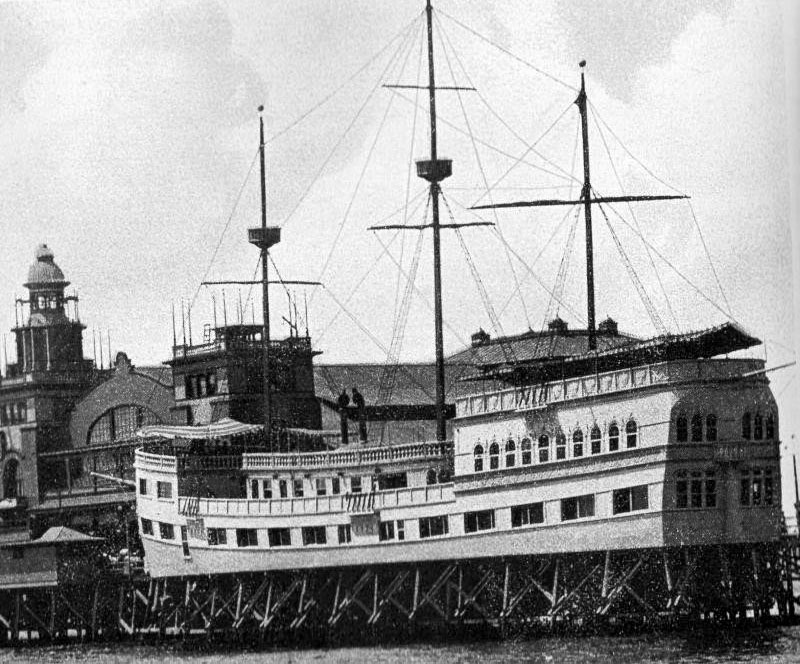 |
|
| (ca. 1905)* – Closer view showing the Baron Long’s Ship Café at the Venice Pier. |
Historical Notes It was built 1905 and fashioned after the Spanish galleon sailed by Spanish explorer Juan Cabrillo when he discovered California. It featured high-priced cuisine and booze during Prohibition for those who could afford it. Reconstructed after a 1924 fire, it was renovated several times, had a name change (to the Showboat Café), and razed in October of 1946. Baron Long owned or ran a number of Los Angeles nightclubs, including the Biltmore Bowl at the Biltmore Hotel in downtown L.A. which was, when it opened, the biggest ballroom in the world. |
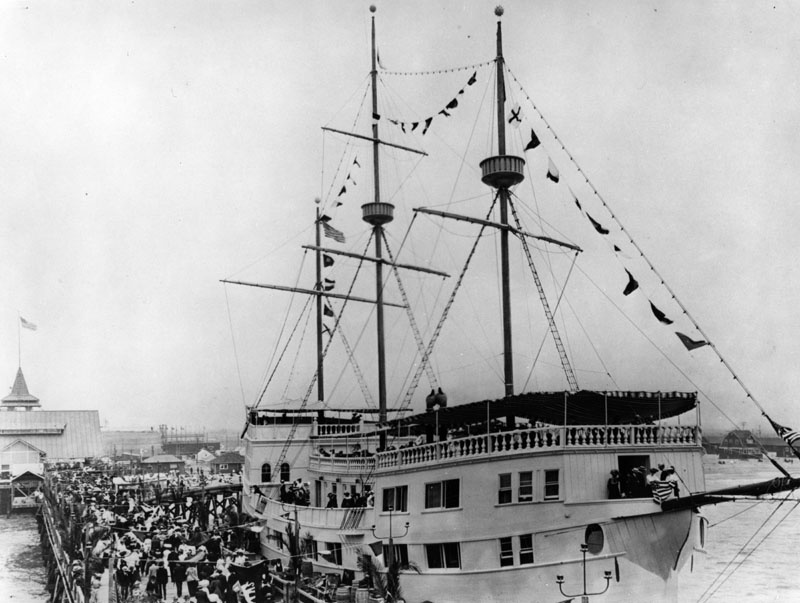 |
|
| (1905)* - A big crowd is seen behind the large restaurant ship which was a replica of Juan Cabrillo's Spanish galleon. People can also be seen aboard the ship which was located in Venice at the Abbot Kinney Pier. The pier was destroyed by fire in 1920. |
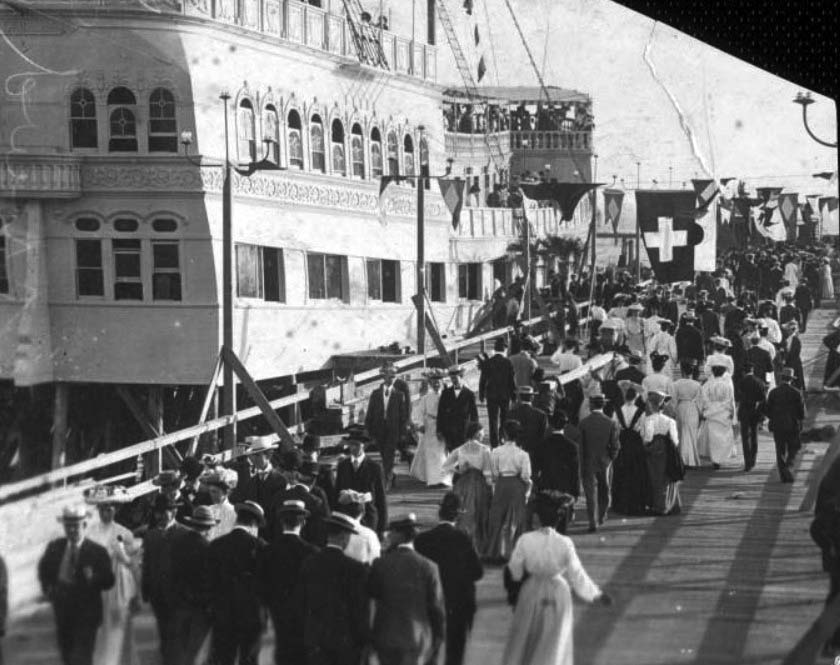 |
|
| (1906)* – Closer view showing a large number of well-dressed people walking on Abbot Kinney’s Venice of America pier alongside the Ship Café. Handwritten note on verso reads: "Ship Café / Venice, Cal. / 12-16-06" |
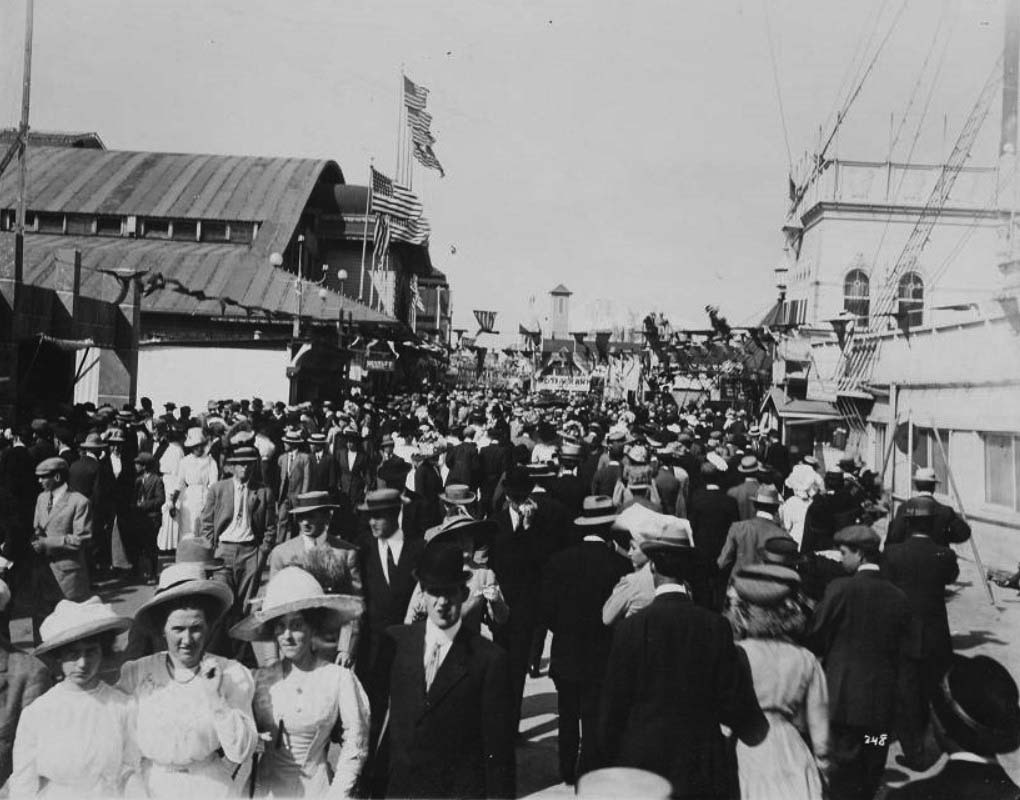 |
|
| (ca. 1910)* – View showing a crowd on Venice Amusement Pier with the Ship Café seen on the right. |
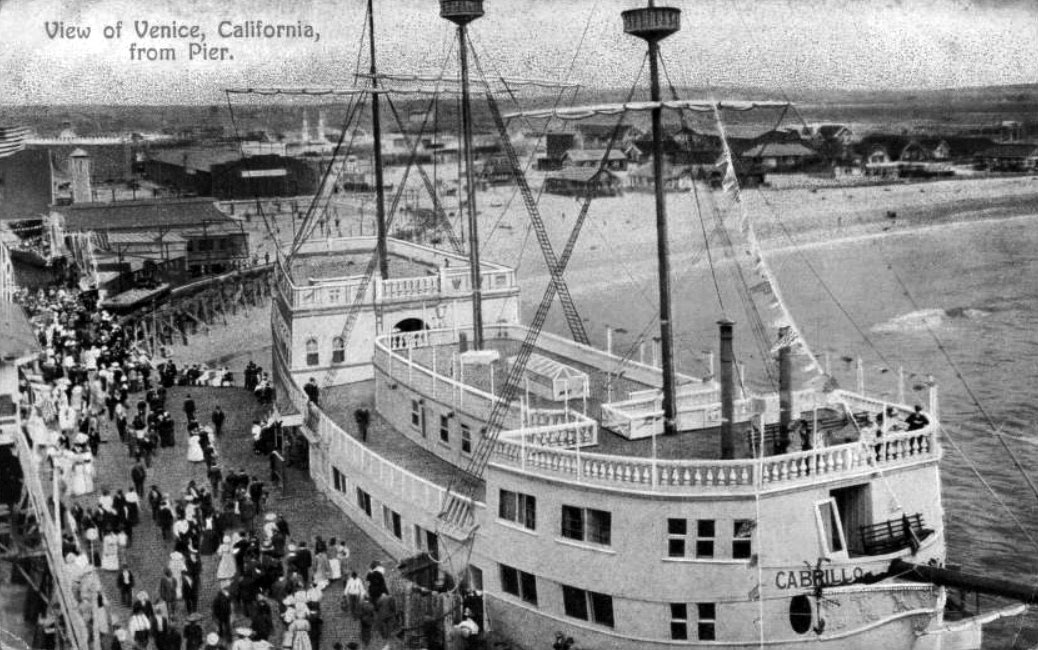 |
|
| (1909)* - Postcard view of the Venice of America pier showing the large white resaurant ship, “Cabrillo”. People stroll on the pier and in the backgound is the city of Venice. |
 |
|
| (ca. 1908)* - Ship Café on Abbot Kinney Pier during Fleet Week, Venice, California. Photo from the Ernest Marquez Collection. |
 |
|
| (1908)* – View of the 'Great White Fleet' sailing toward Los Angeles Harbor, as seen from the deck of the Ship Café on the Abbot Kinney Pier in Venice, California. Photo from the Ernest Marquez Collection. |
Historical Notes The "Great White Fleet" was a nickname for the United States Navy battle fleet that completed a circumnavigation of the globe from 1907-1909. |
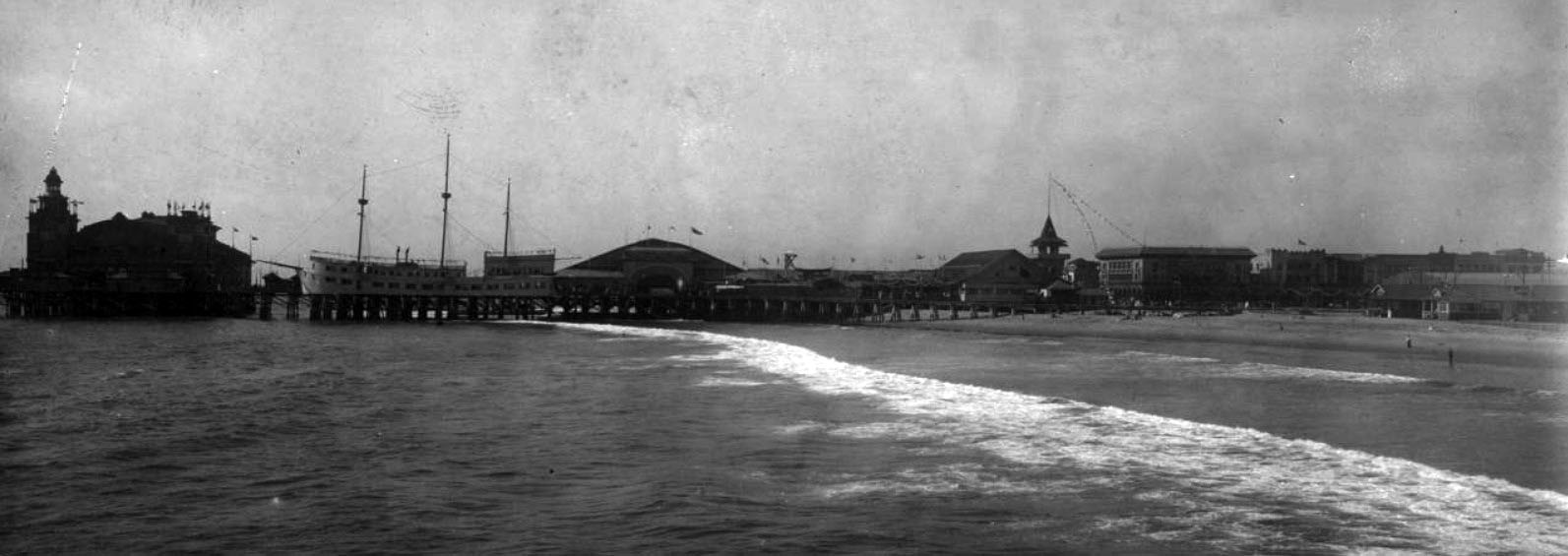 |
|
| (ca. 1905)* - Panoramic view looking north at the Pier at Venice Beach showing the amusement park and beach. The Venice Pier Pavilion with its tall tower is at left. On its right is the Ship Café. |
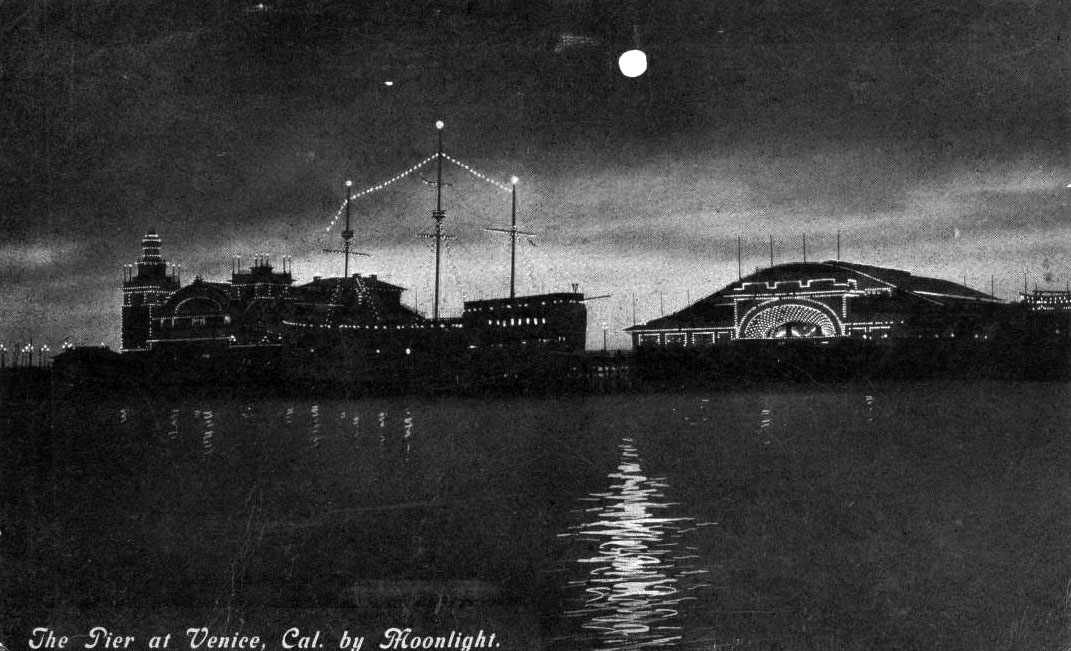 |
|
| (ca. 1905)* - Postcard view showing the Venice Pier by Moonlight. |
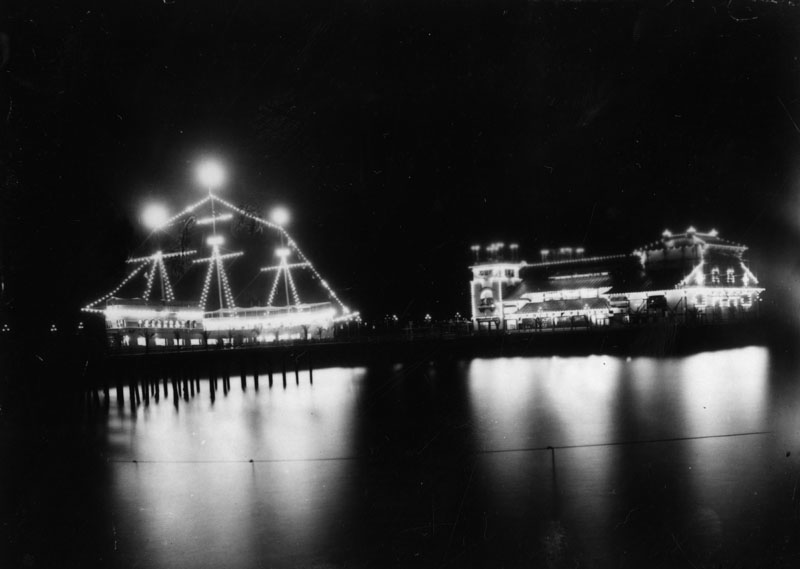 |
|
| (1905)* - With lights blazing across the water the Ship Café and beside it the Venice Auditorium are clearly visible. At one time the ship was also known as Hotel Ship Cabrillo, and it was built over the water on stilts. |
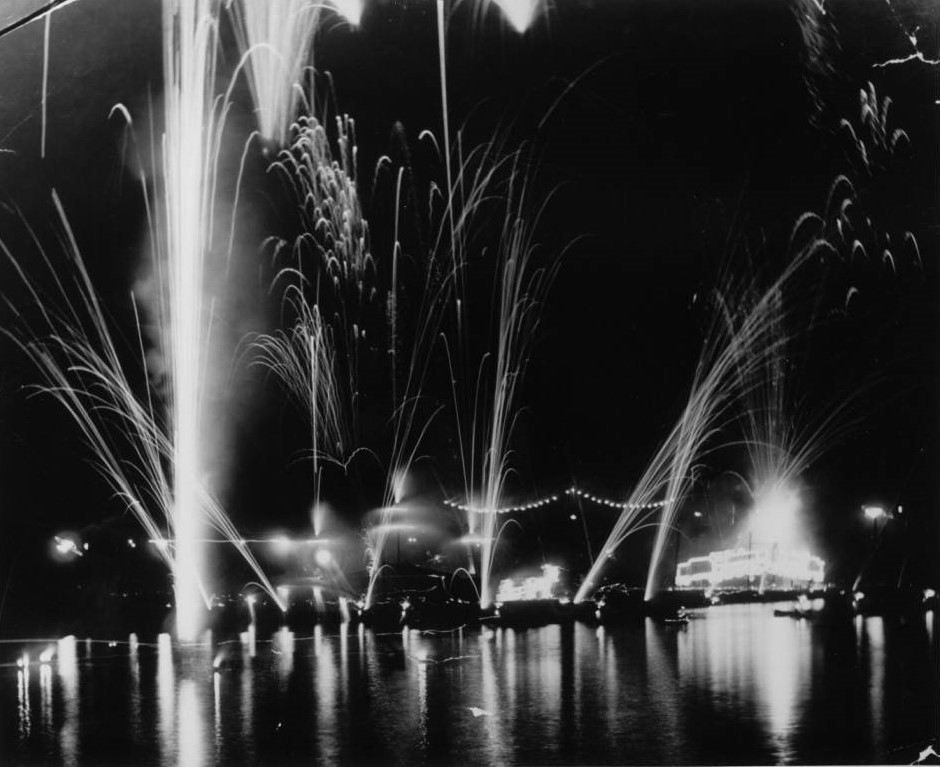 |
|
| (ca. 1905)* - Photograph of a fireworks display over the lake at Venice. Splashes of light can be seen cascading down from the sky and erupting from the shore. In the right distance, a small foot bridge appears to have been decorated with lights |
Historical Notes Despite undergoing various improvements and rebuilding efforts over the years, including the reconstruction of the Ship Café after a fire in 1920, the original structures were eventually dismantled in 1946, marking the end of an era for these beloved Venice landmarks. |
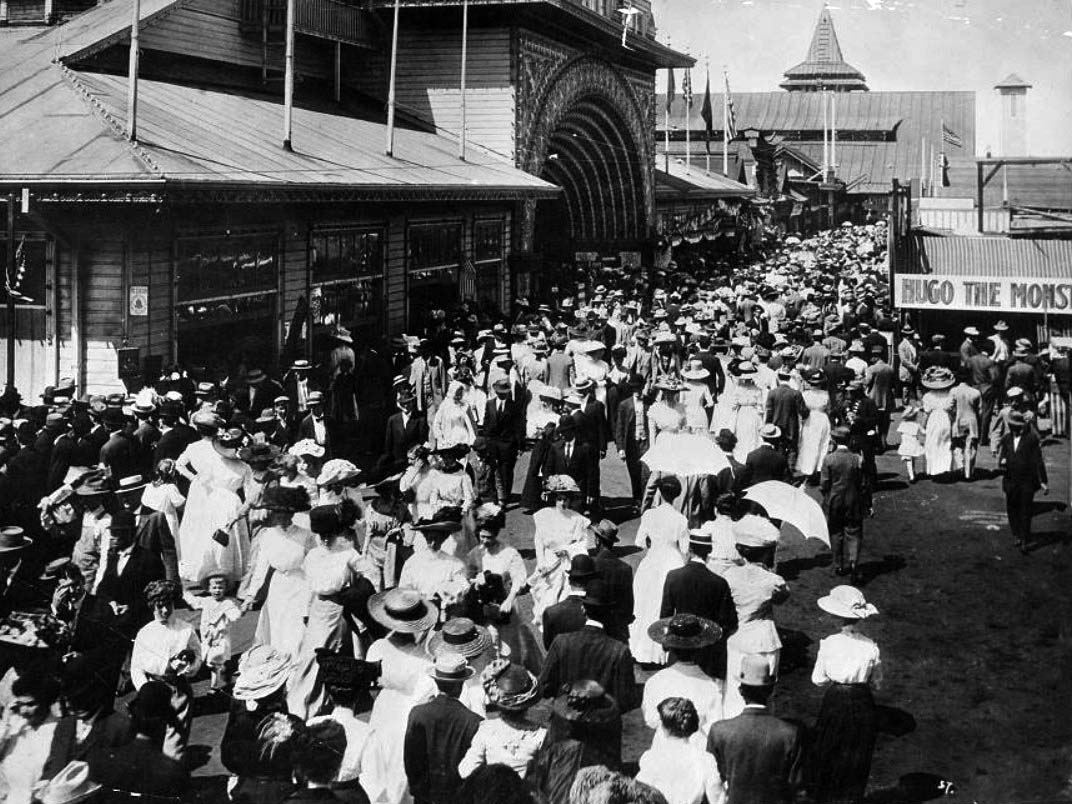 |
|
| (1908)* - Venice Pier on a crowded day with the Dance Hall seen in the background. |
Historical Notes Venice quickly became a popular destination, attracting between 50,000 to 150,000 weekend visitors by 1910. The town flourished as a cultural hotspot, drawing artists, musicians, and free spirits, while its population grew to over 3,000 residents. |
 |
|
| (ca. 1905)* - Several people stroll by the Dance Hall on the Amusement Pier at Venice Beach. "Dance Hall / Venice" -- handwritten note on verso. |
Historical Notes lThe Dance Hall on the Amusement Pier at Venice Beach, originally built in 1905, played a significant role in the area's development as a popular amusement destination. After a fire destroyed the original pier in 1920, it was rebuilt and reopened in 1921, featuring a spacious hardwood dance floor and an oval orchestra pit, all designed in a Spanish motif. The venue quickly became a social hub, hosting dances and events that were central to local culture. However, after Venice was annexed to Los Angeles in 1925, strict "Blue Laws" limited activities like dancing on Sundays, which adversely affected attendance. Today, the Dance Hall is remembered as a key part of Venice Beach's history, reflecting the vibrant entertainment culture of early 20th-century California. |
Venice Aquarium
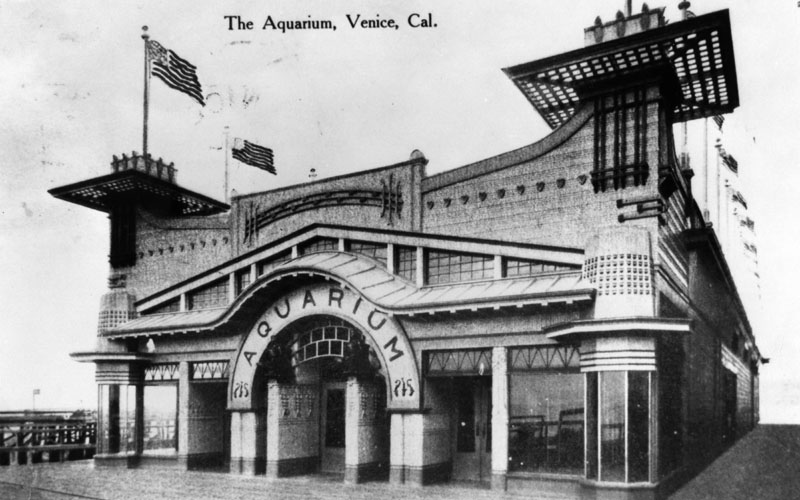 |
|
| (ca. 1908)* - A view of the front of the Aquarium, with flags flying all around the top of the building. It exhibited the finest collection of marine specimens on the Pacific coast. |
Historical Notes The Venice Beach Aquarium exhibited the finest collection of marine specimens on the Pacific coast. It later became the official marine biological station for the University of Southern California. In 1920, along with the pier, the beautiful Venice Aquarium was destroyed by fire. |
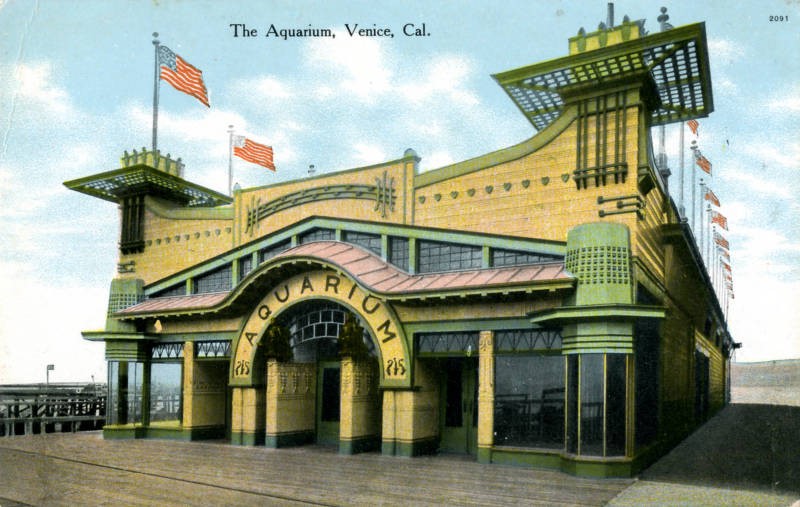 |
|
| (ca. 1908)* - Postcard view of the front of the Aquarium, with flags flying all around the top of the building. It exhibited the finest collection of marine specimens on the Pacific coast. |
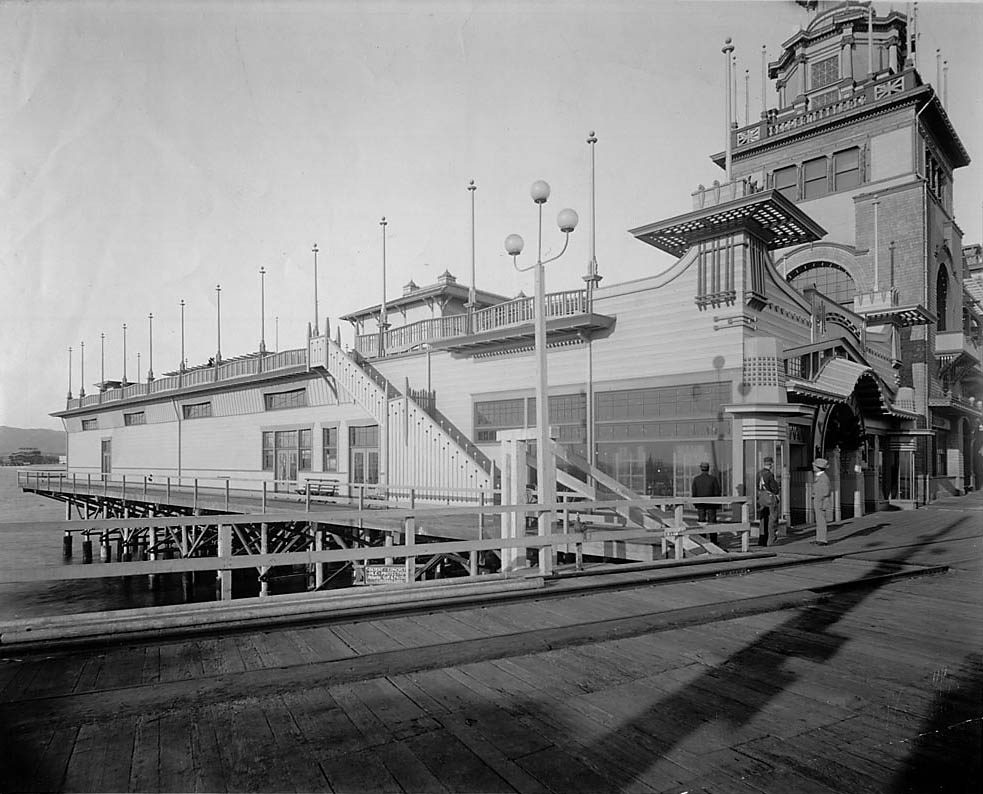 |
|
| (ca. 1909)^ - Side view of the Venice Aquarium showing three men standing by the aquarium building. Note the ornate light fixture along the boardwalk. |
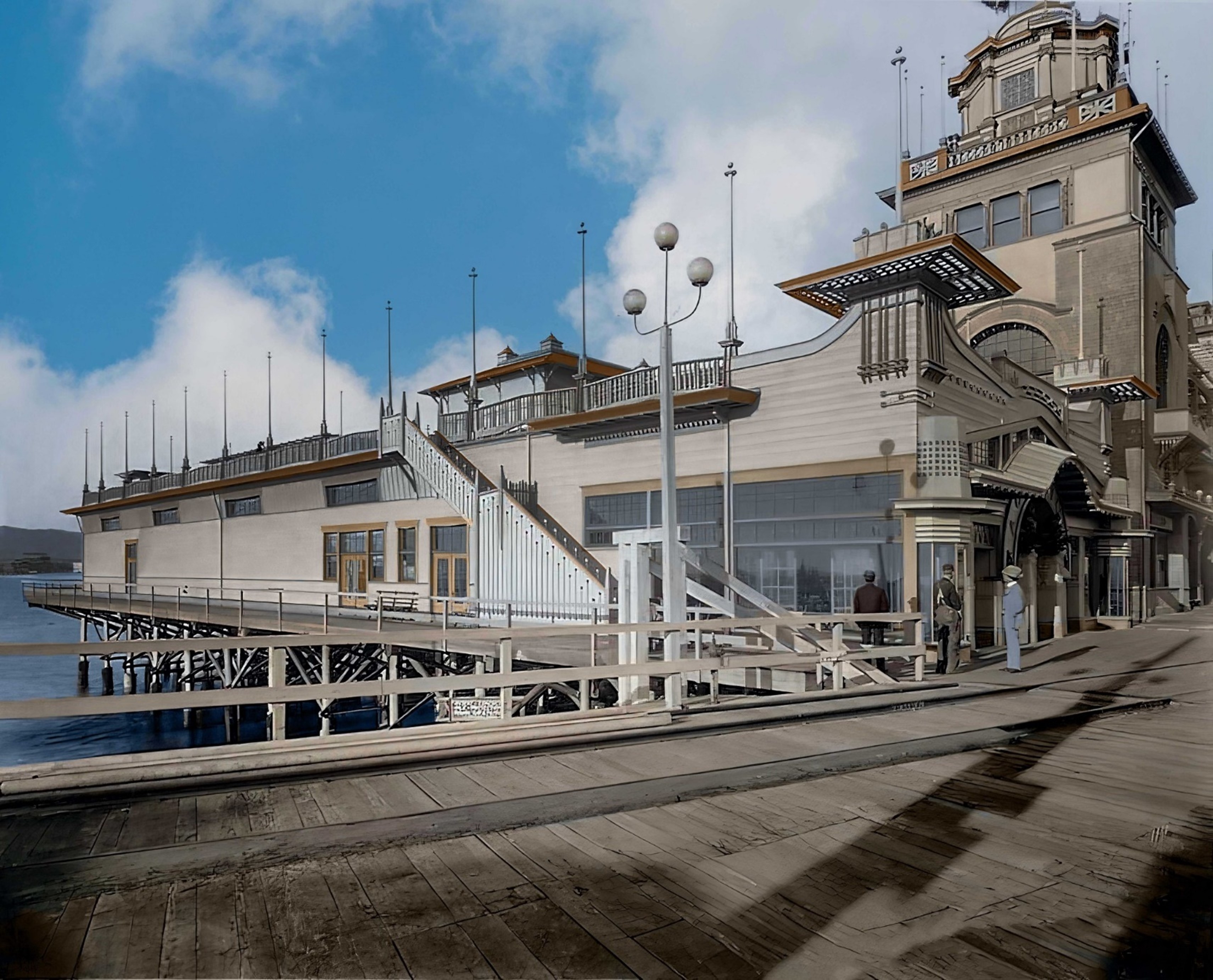 |
|
| (ca. 1909)^ - Side view of the Venice Aquarium showing three men standing by the aquarium building. Note the ornate light fixture along the boardwalk. Image enhancement and colorization by Richard Holoff |
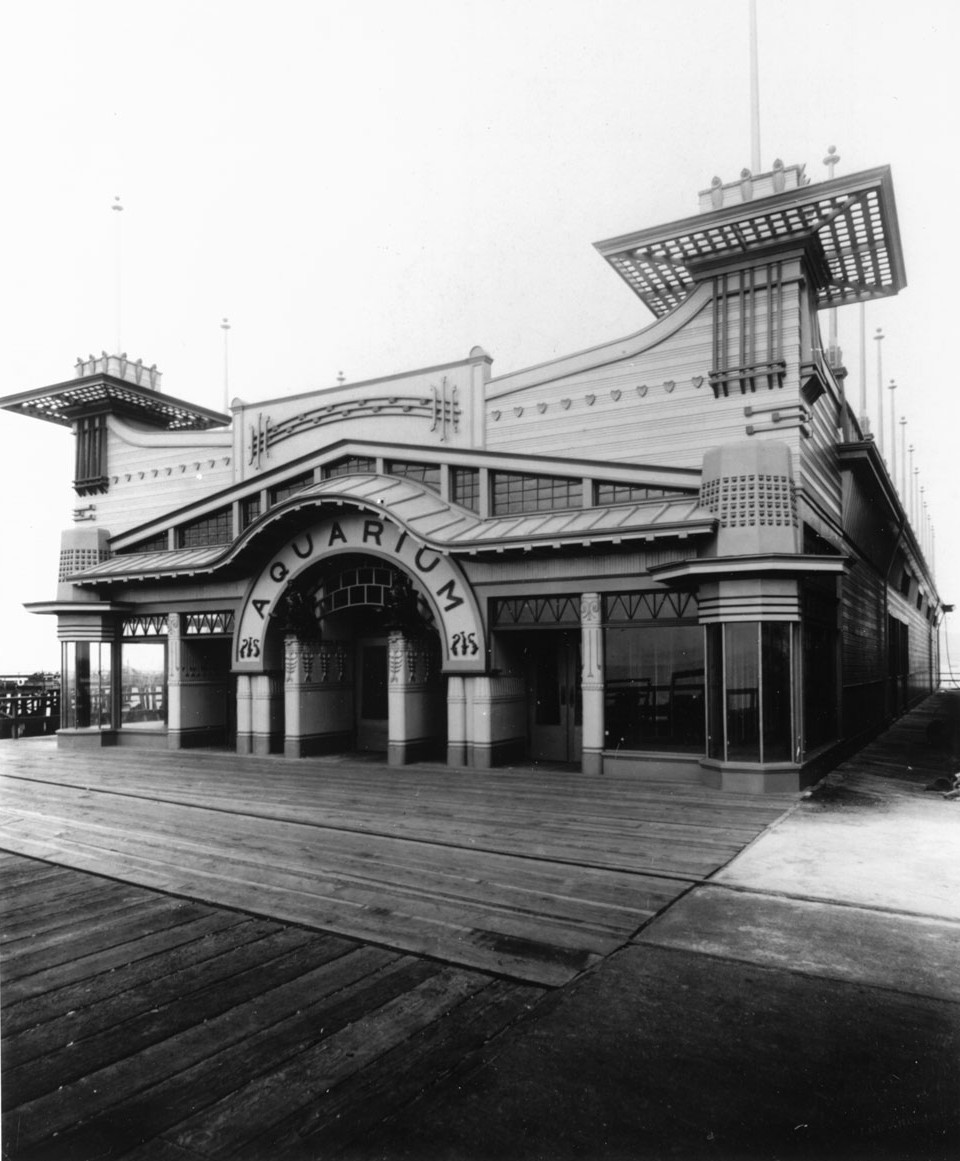 |
|
| (1909)^ - The Venice Aquarium on the boardwalk at Venice Beach without the flags flying. |
Historical Notes In 1920, along with the pier, the beautiful Venice Aquarium was destroyed by fire. |
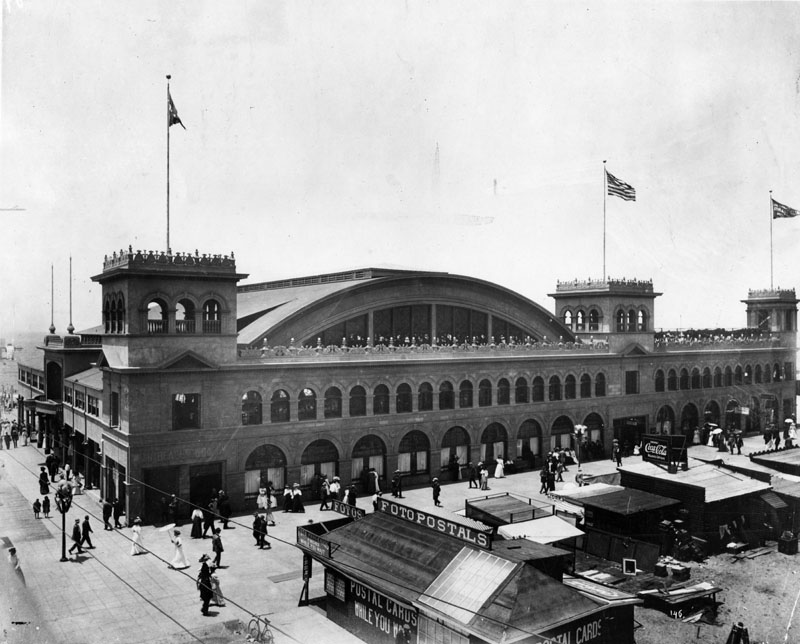 |
|
| (ca. 1908)* - The exterior of the large bath house is seen across the street from a row of much smaller buildings, including one which offers "Postal cards while you wait". The bath house (The Venice Plunge) was the largest heated salt-water pool on the west coast. |
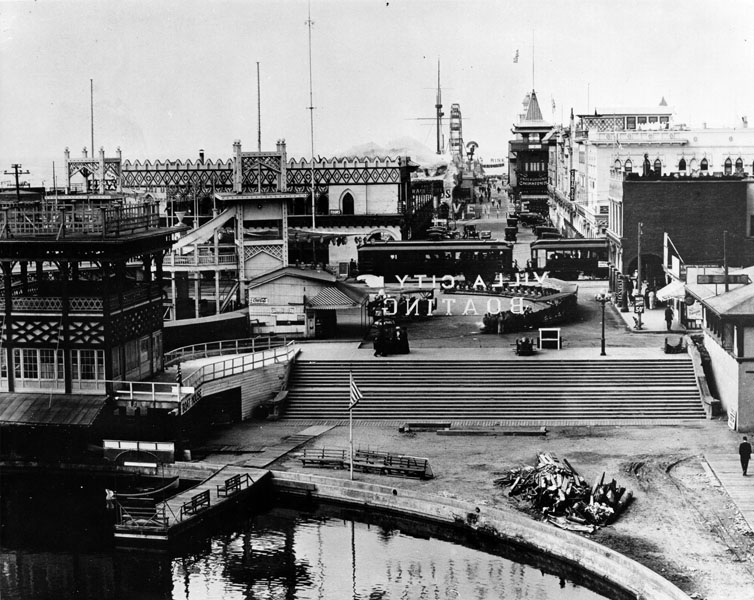 |
|
| (ca. 1908)* - An overview of an empty Venice of America amusement park is taken through the plate glass window of Villa City Boating. The lagoon is in the foreground. The Miniature Railroad Ride can be seen in center of photo. This view is looking west from Windward Avenue toward the Venice Pier. |
.jpg) |
|
| (ca. 1909)^^ - Postcard view of a street scene showing Windward Avenue from the Lagoon, Venice. Wide steps teeming with people lead up from the Lagoon to Windward Ave. |
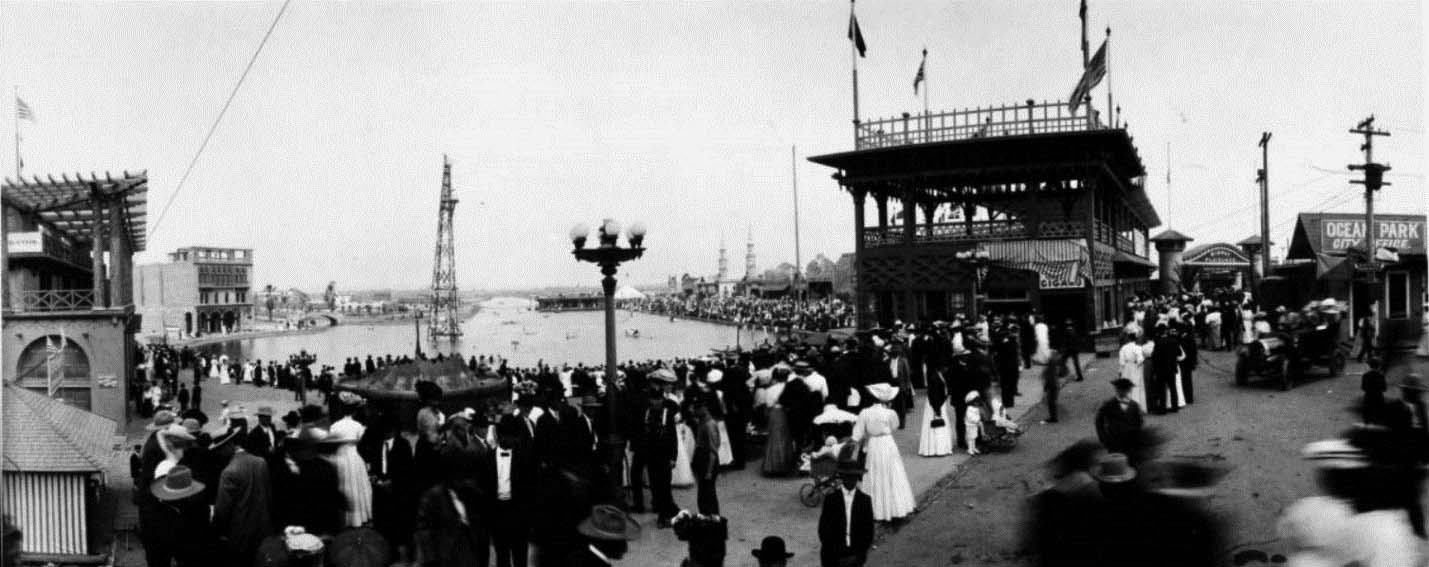 |
|
| (ca. 1910)^^ – View showing a crowd of people stretched from left to right between two pavilions at the Venice Lagoon. The three story building in the distance (left) is the Antler Hotel. Next to it is a small bridge extending over a canal. At center, the Venice Lagoon can be seen with a number of row-boats in it. What appears to be a watch tower stands in the middle of the lagoon. In the background, at center, another canal can be seen extending towards an extreme background. |
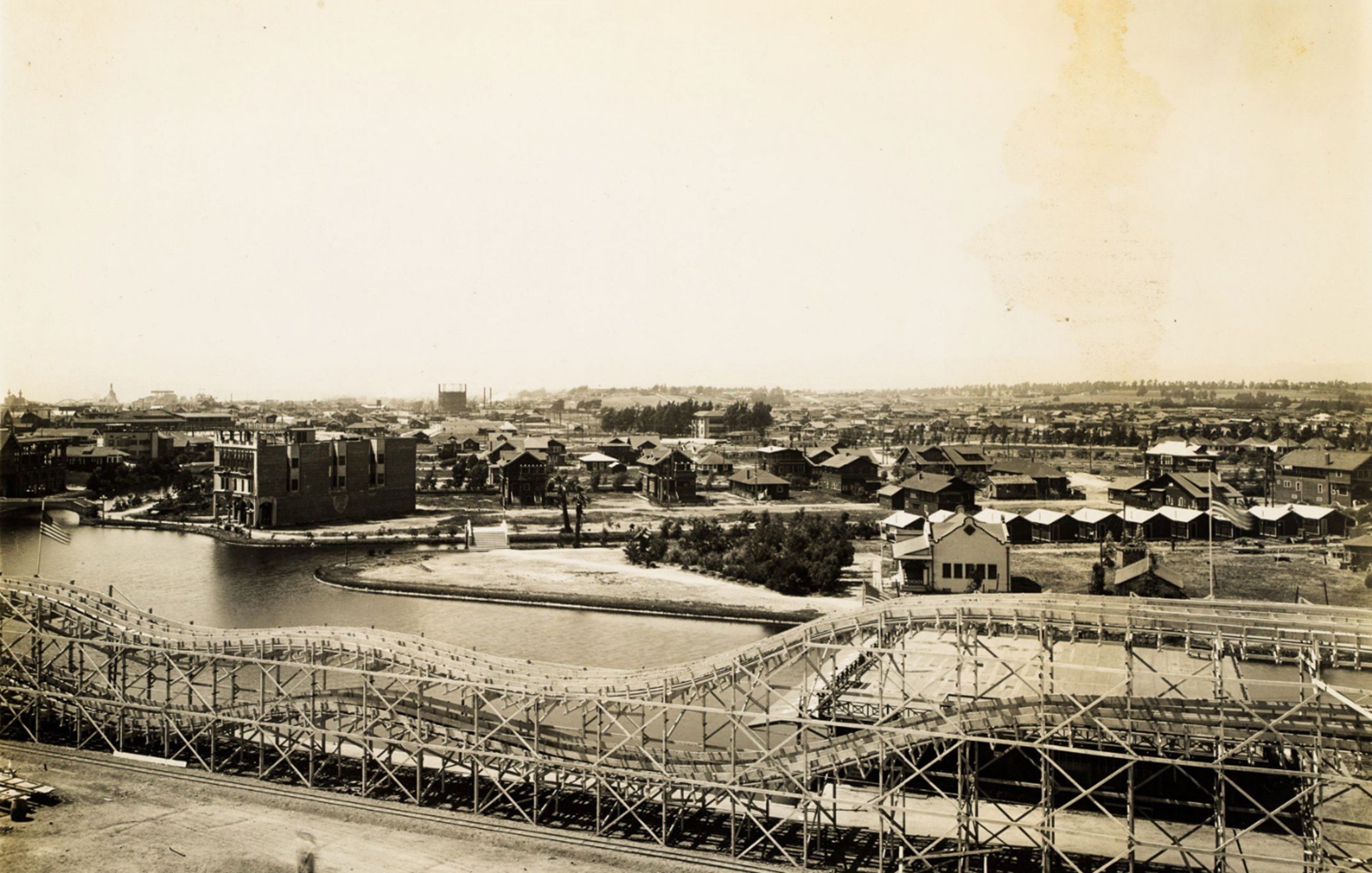 |
|
| (1910s)* - View of the Race Thru the Clouds racing roller coaster next to the Venice Lagoon in Venice, California. The Antler Hotel is visible on the left at the edge of the lagoon, with beach cottages, houses, and other buildings in the distance. Photo from the Ernest Marquez Collection. |
Historical Notes The "Race Thru the Clouds" was a prominent wooden roller coaster located at Venice Pier in Venice, California, during the 1910s. It was notable for being the first racing roller coaster on the West Coast and opened on July 4, 1911. The coaster was designed by John Miller, a renowned roller coaster designer, and was constructed by the Ingersoll Construction Company, with Thomas Prior and Frederick Church responsible for its operation and maintenance. The "Race Thru the Clouds" featured a twin-track design, allowing two coaster cars to race each other along parallel tracks. Each track was 4,000 feet long, and the coaster reached a height of 90 feet. This design provided a thrilling experience with numerous twists and turns, making it a popular attraction for visitors to Venice Beach. |
 |
|
| (ca. 1905)* – View showing the Venice Wharf and Pavilion as seen from the beach. About a dozen bathers frolic in the waves near shore. A rope is strung from shore to the wharf suspended above the water allowing swimmers to grab hold of it. |
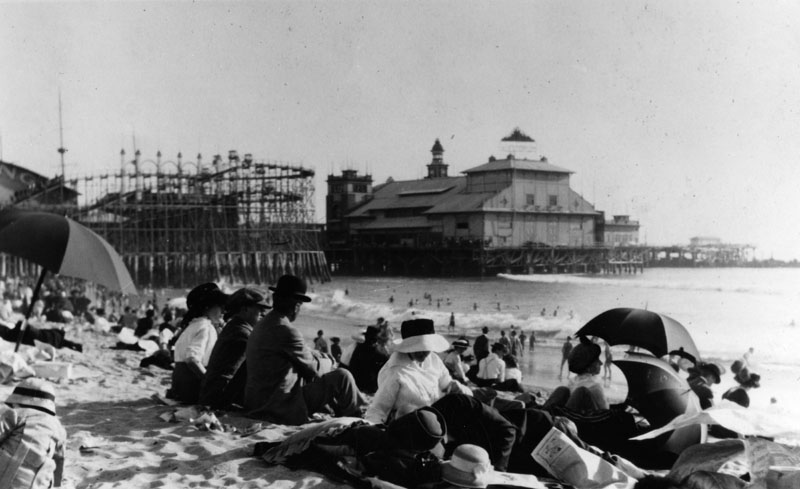 |
|
| (Early 1900s)* - View of Venice Pier from the beach showing people both in and out of water. |
Historical Notes Attractions on the Kinney Pier became more amusement-oriented by 1909, when a Venice Scenic Railway, Aquarium, Virginia Reel, Whip, Racing Derby, and other rides and game booths were added. |
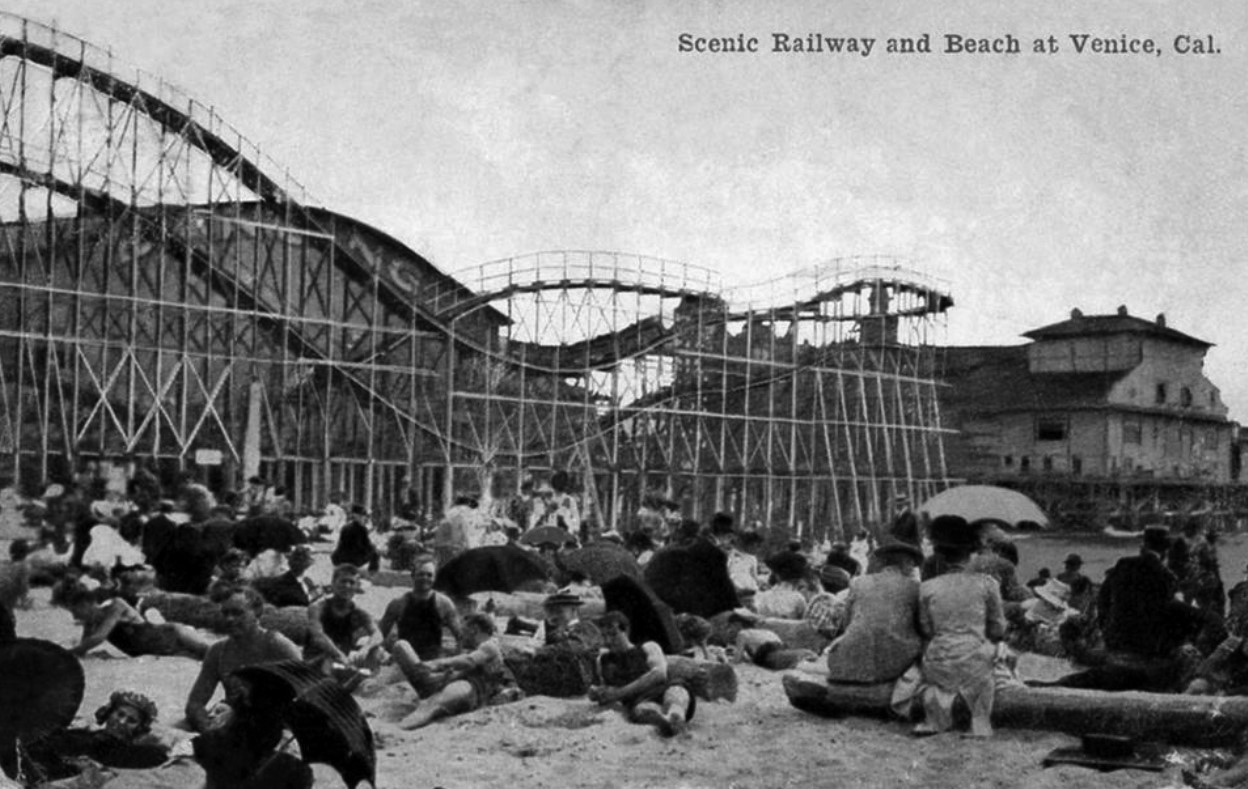 |
|
| (ca. 1912)* - Postcard view showing a crowded Venice Beach with roller coaster and pier in the background. |
* * * * * |
L. A. Thompson Scenic Railway - Venice
 |
|
| (ca. 1910)* – Postcard view showing the L. A. Thompson Scenic Railway in Venice. |
Historical Notes Opened in 1910, the L.A. Thompson Scenic Railway in Venice was a pioneering attraction that ran among artificial hills, lights, and replicas of temples, offering a visual experience that foreshadowed the themed environments later popularized by Disney. LaMarcus Adna Thompson, though not credited as the inventor of the roller coaster, was instrumental in bringing it to the masses. His designs inspired others to create their own, ultimately making the roller coaster the centerpiece of amusement parks. Thompson’s scenic railways combined entertainment with elaborate visuals, providing a slower-paced ride with immersive themes rather than the thrills of modern coasters. |
 |
|
| (ca. 1910)* – View of the Ocean Front Walk in Venice, with the colonnades of the St. Mark's Hotel building on the left and a sign for "Dr. Fuller." On the right is the entrance to "The L.A. Thompson Scenic Railway Co." roller coaster, located on the Abbot Kinney Pier. Photo from the Ernest Marquez Collection. |
Historical Notes Thompson’s first success came in 1888, leading him to form a company dedicated to building scenic railways across the globe. Each new installation became more elaborate, and the Venice Scenic Railway was one of the most notable. This ride, blending elements of his earlier creations with stunning visuals, became a major attraction. At its peak in the early 1900s, scenic railways like this one were immensely popular, but their appeal faded by the 1920s as faster, more exciting coasters emerged. Today, only one L.A. Thompson Scenic Railway remains operational, at Tivoli Gardens in Copenhagen. |
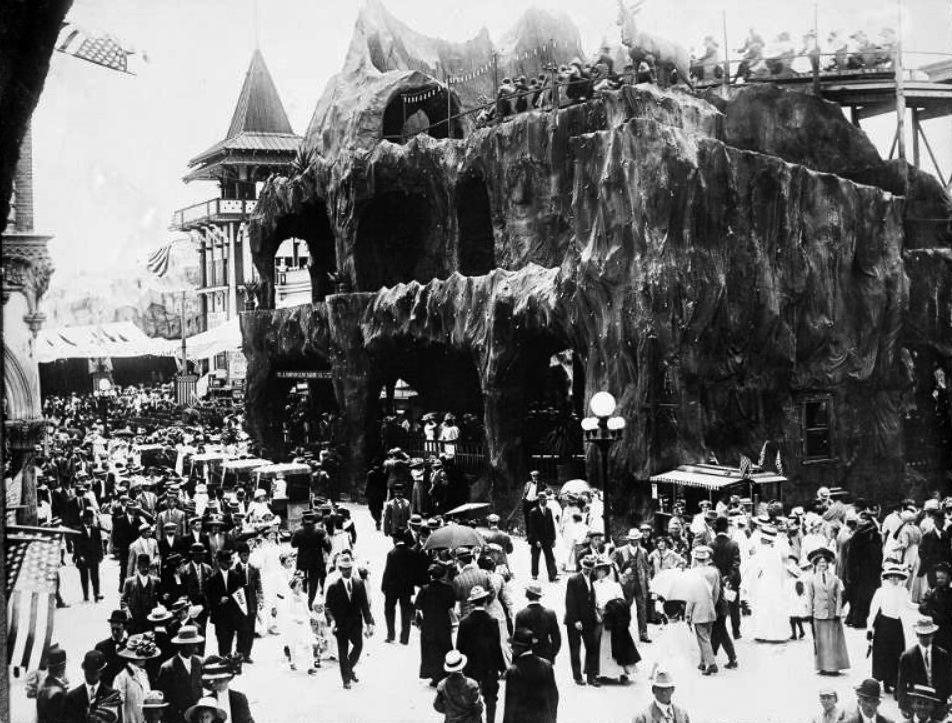 |
|
| (ca. 1910)* - View showing throngs of people in front of the L. A. Thompson Scenic Railway attraction at Venice Amusement Pier. |
Historical Notes The Scenic Railroad had mountainous terrain and a tunnel which depicted scenery. The ride gave couples a chance for a quick kiss and an embrace. |
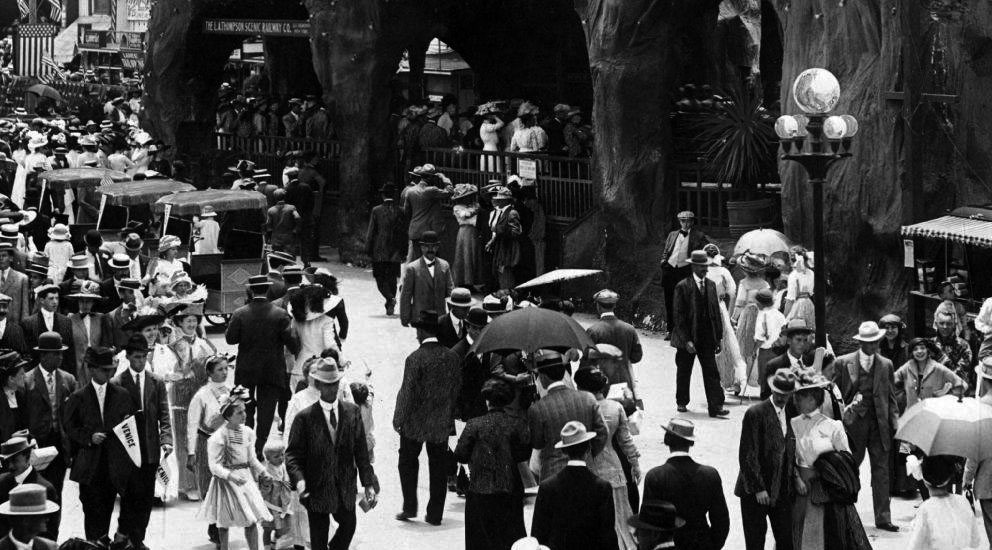 |
|
| (ca. 1910)*- Close-up detail view showing the crowds in front of the entrance to Thompson Scenic Railway at Venice Amusement Pier. |
Historical Notes L.A. Thompson Scenic Railway in Venice was built in 1910 and dismantled in 1919. |
* * * * * |
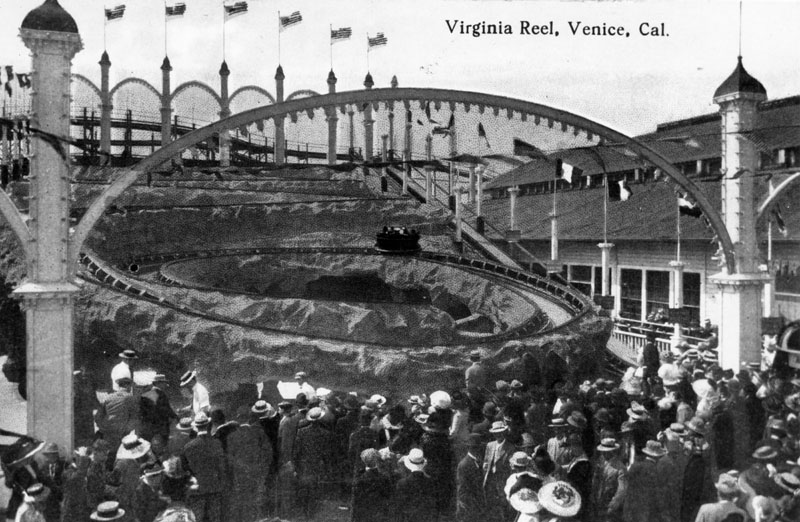 |
|
| (ca. 1912)* - Spectators lined up below watch a car as it goes up the track on the Virginia Reel amusement park ride. |
Historical Notes The Virginia Reel ride opened on Kinney’s Pier in 1912. |
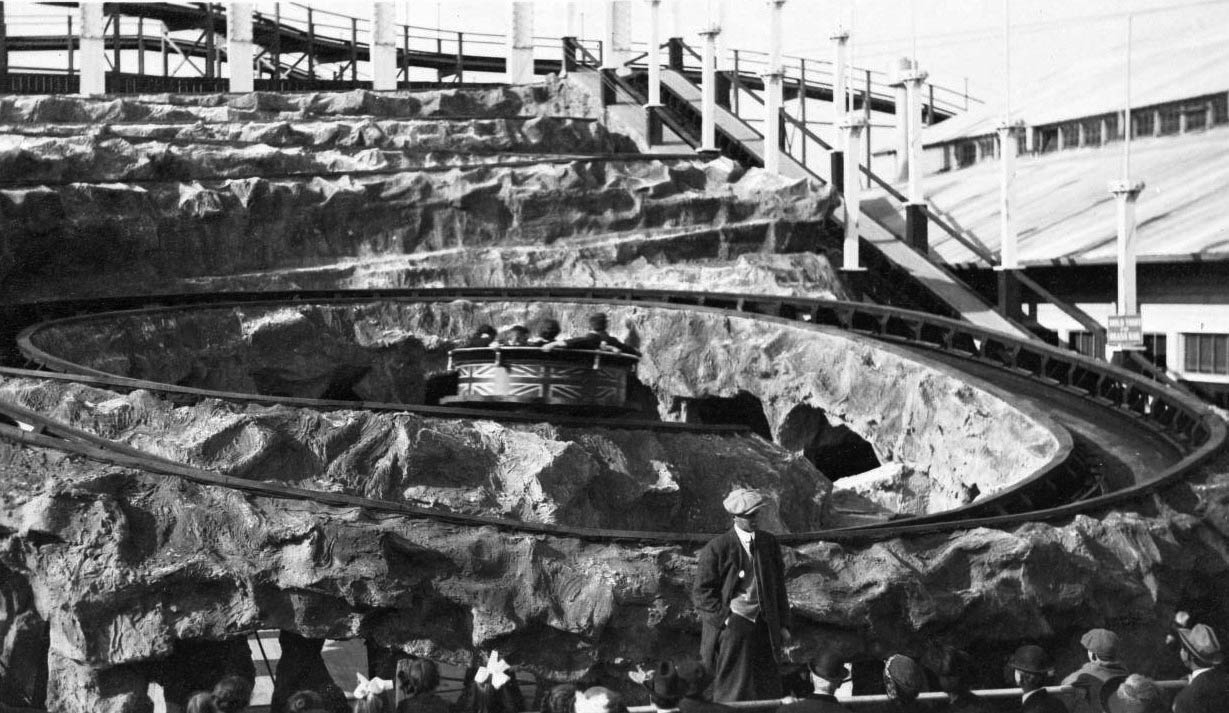 |
|
| (ca. 1912)* - View showing the Virginia Reel at the Venice Amusement Park. A wooden track meanders down what appears to be a stone hill side. At center, a round car full of people is making its way down the track. The car is decorated with images of the Union Jack. A ramp to pull the car to the top of the track can be seen at right. In the foreground, a man is standing on a platform and facing a large crowd of onlookers. |
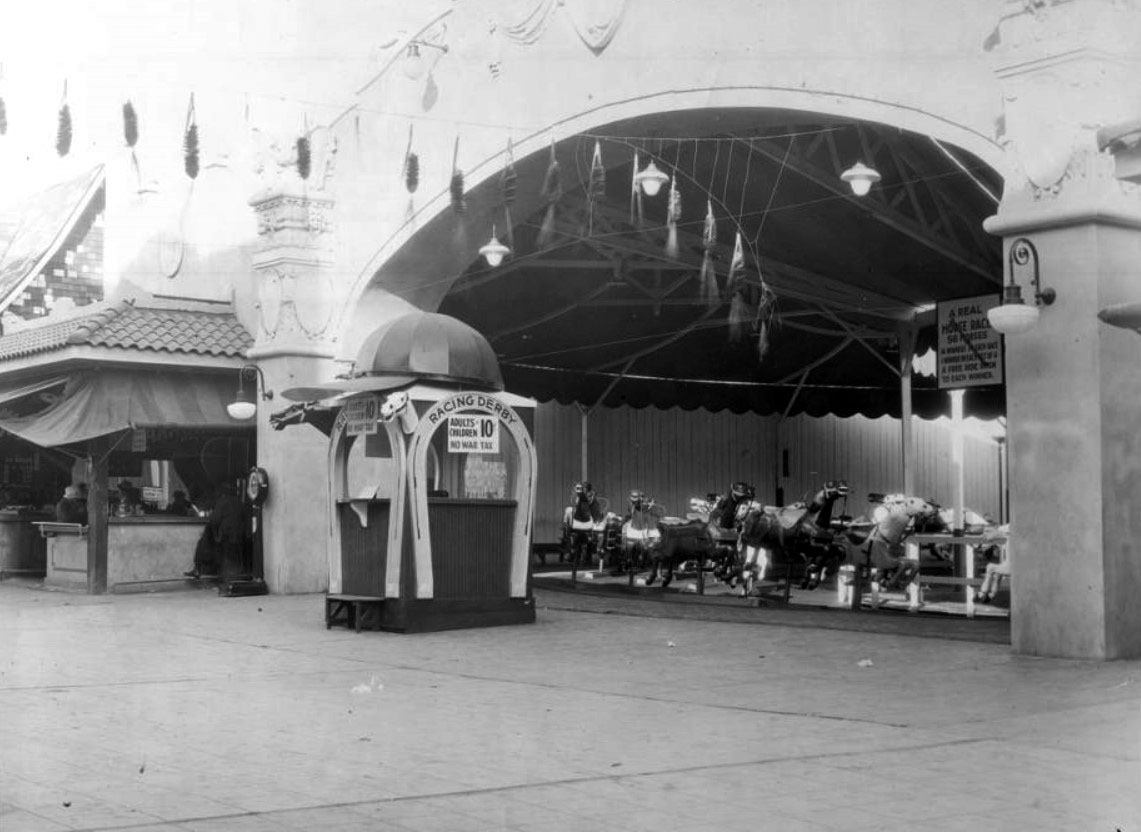 |
|
| (ca. 1917)* - View showing a vacant carousel ride called the "Racing Derby" located in the amusement park on Venice Pier. |
Historical Notes Carousels were generic rides, bought and sold to other operators like any business. Sometimes they were moved from one amusement pier to another. While there was little innovation in the business, wood carving became an art form and many of the area's carousels showcased a variety of menagerie animals. Prior and Church in 1917 patented the Great American Racing Derby, a horse racing carousel. First they increased the ride's diameter to 72 feet, then grouped the horses four abreast in ten distinct races. The horses, which were set in six foot long tracks, would move back and forth as the ride rotated. The ride accelerated until it reached nearly 30 MPH, then the bell would ring and the winner of each group would receive free repeat rides. |
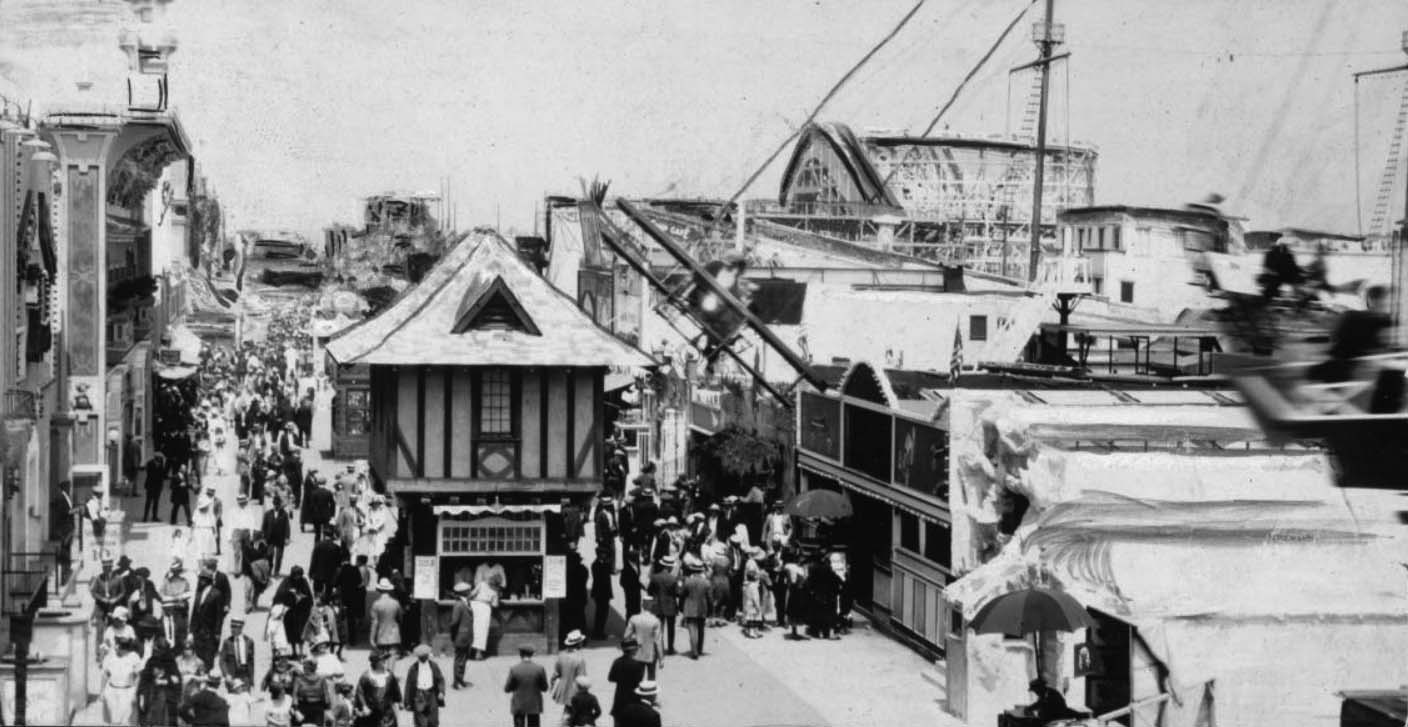 |
|
| (ca. 1920)* – Panoramic view showing crowds outside the Venice Beach Amusement Park, located between Seventeenth Street and Thirty-fourth Street along the ocean front. The rollercoaster is seen in the background. |
* * * * * |
Venice Miniature Railway
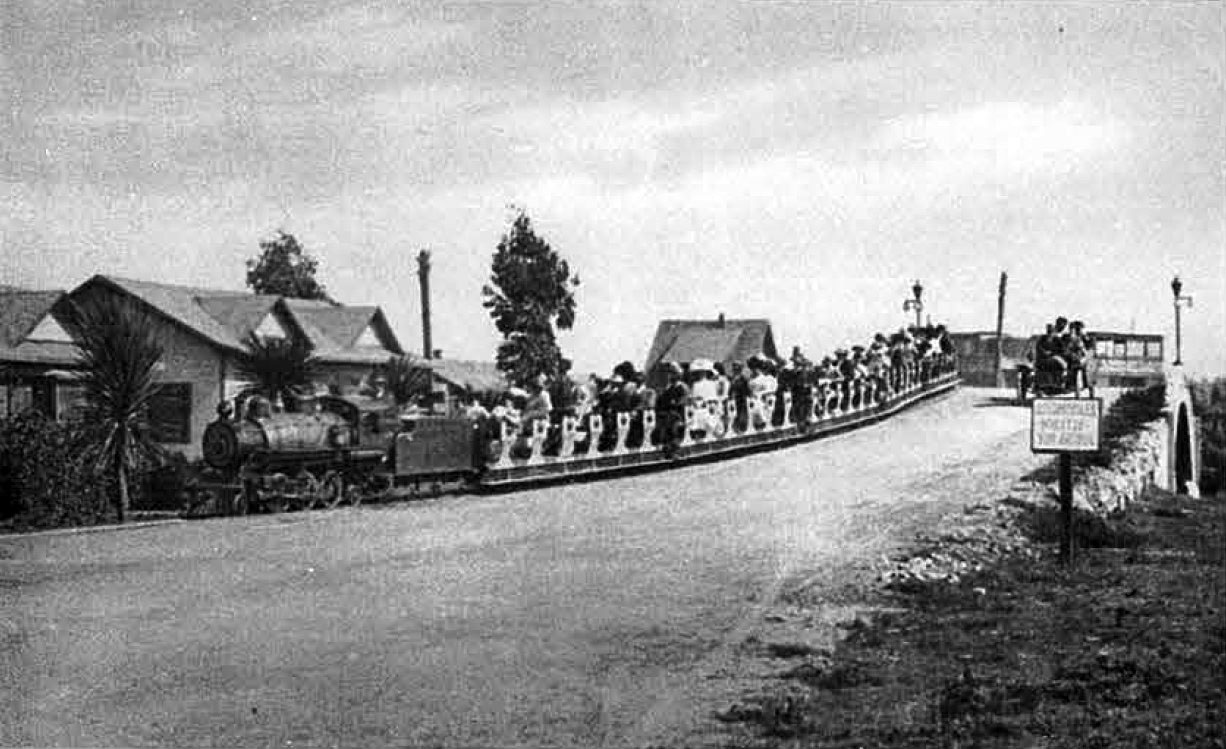 |
|
| (ca. 1905)* - View of the Venice Miniature Railway train crossing over a Venice Canal bridge on its way back to Windward Avenue at the Venice of America Amusement Park. |
Historical Notes When Abbot Kinney was building Venice in 1905, he decided that his new resort should have an internal transportation system to shuttle visitors and residents around town. He turned to John J. Coit who operated a successful eighteen inch gauge (1/3rd scale) miniature steam railroad at Eastlake Park (now Lincoln Park) in Los Angeles. He persuaded him to oversee the construction and management of a mile and three quarter long railroad that would take passengers from the Windward Avenue business district on a loop across canal bridges and through the canalled residential district, then return via a loop up Washington Boulevard, past its Lake Avenue maintenance yard and back to the Windward station along Mildred Avenue.* |
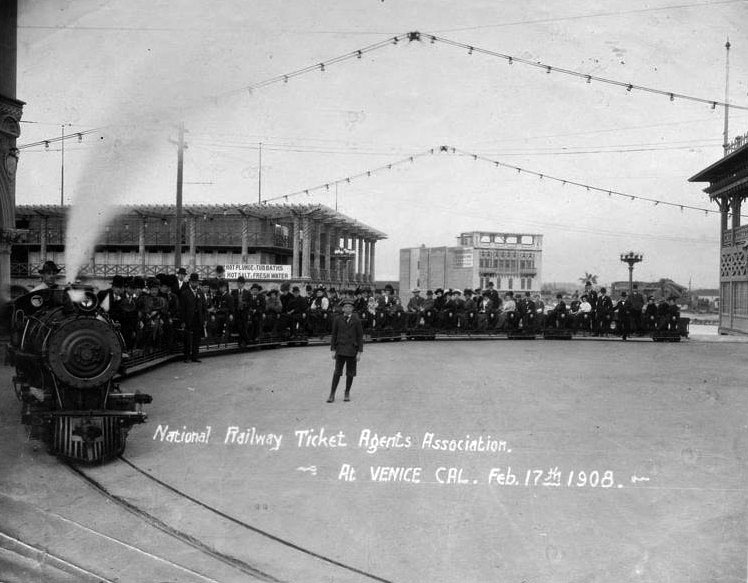 |
|
| (1908)^ - View of the Miniature Railroad Ride filled to capacity at the Venice Amusement Park. |
Historical Notes The cost of a trip around Venice was five cents, although residents could buy a book of tickets for $1.00 which made the run only two cents. At that time, it cost 15 cents to ride from Los Angeles to Venice on the Los Angeles Pacific Railway.* |
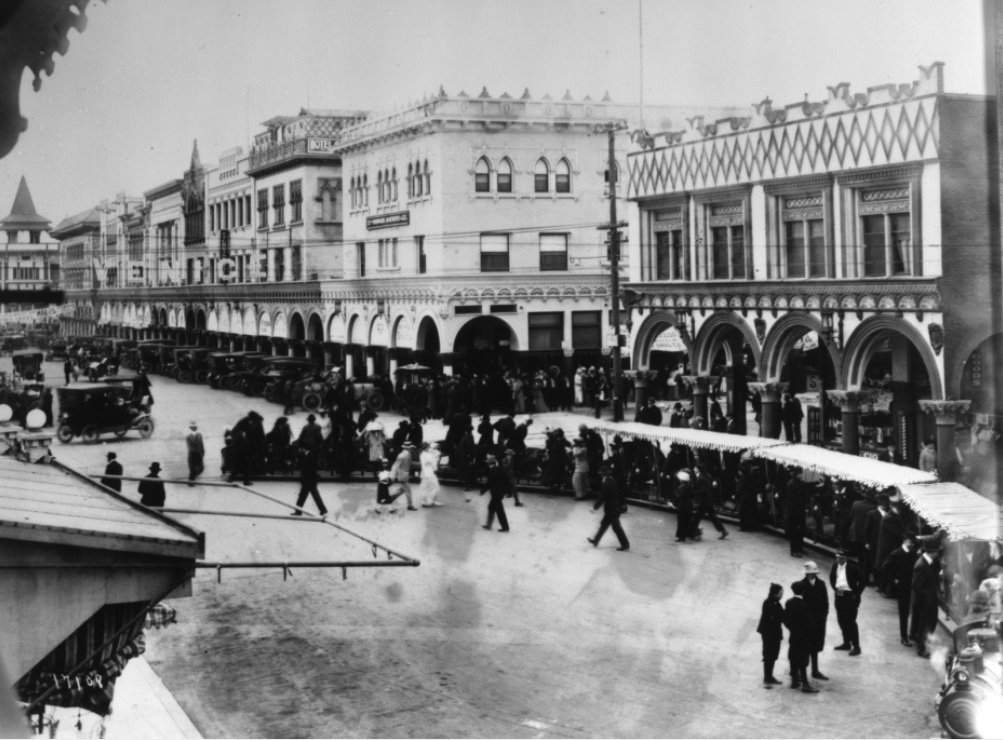 |
|
| (1910s)* – View looking west down Windward Avenue towards the ocean showing the Venice Miniature Railroad. |
Historical Notes Kinney installed the Venice Miniature Rail Road (V.M.R.R.) as both a tourist attraction and as a means to escort potential home builders and buyers to look at the subdivided parcels he was promoting. The train was very popular for its time, but it interfered with traffic.* |
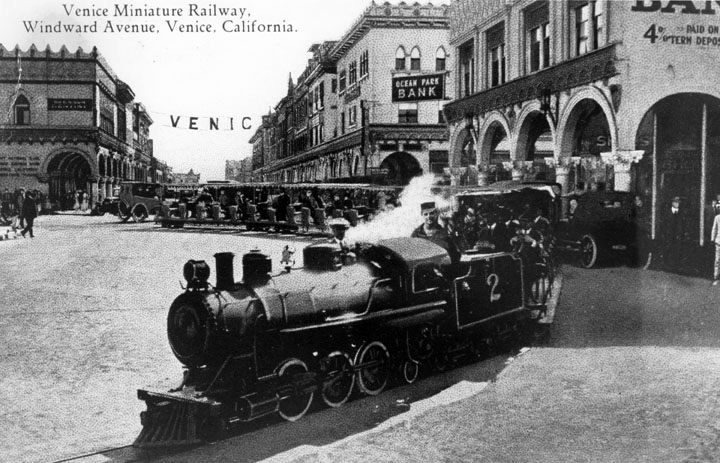 |
|
| (1912)* - Postcard view of the Miniature Railway on Windward Avenue in Venice. The miniature railroad would carry passengers for trips around the Venice streets, including Windward Ave. as shown here, and around the canal area. |
Historical Notes The Venice Miniature Railroad remained a popular ride and had run on weekends for twenty years. However, the train was opposed by merchants along its route on Washington Boulevard. In 1925, the city of Venice passed an ordinance that would prohibit miniature railroads from operating on streets, thus leading to the demise of the long running Venice Miniature Railroad.* |
* * * * * |
The Midway Plaisance in Venice
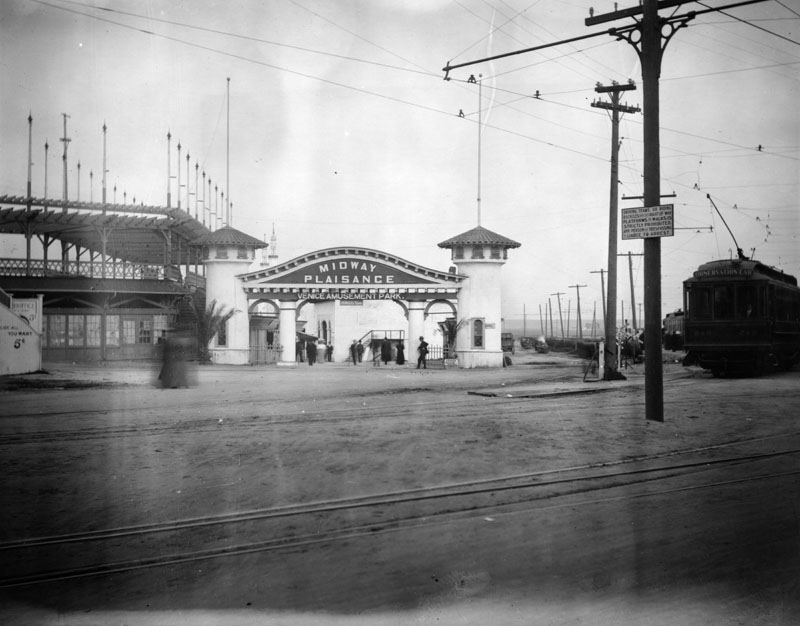 |
|
| (ca. 1906)* - Entrance to the Midway Plaisance Amusement Park in Venice with PE streetcar service near entry. |
Historical Notes Kinney's Midway Plaisance was built on the south bank of the lagoon which later became the Venice traffic circle. It opened in January of 1906 and operated until 1908. It consisted of eleven buildings including Darkness and Dawn, which replicated a visit to hell based on Dante's inferno.**^ |
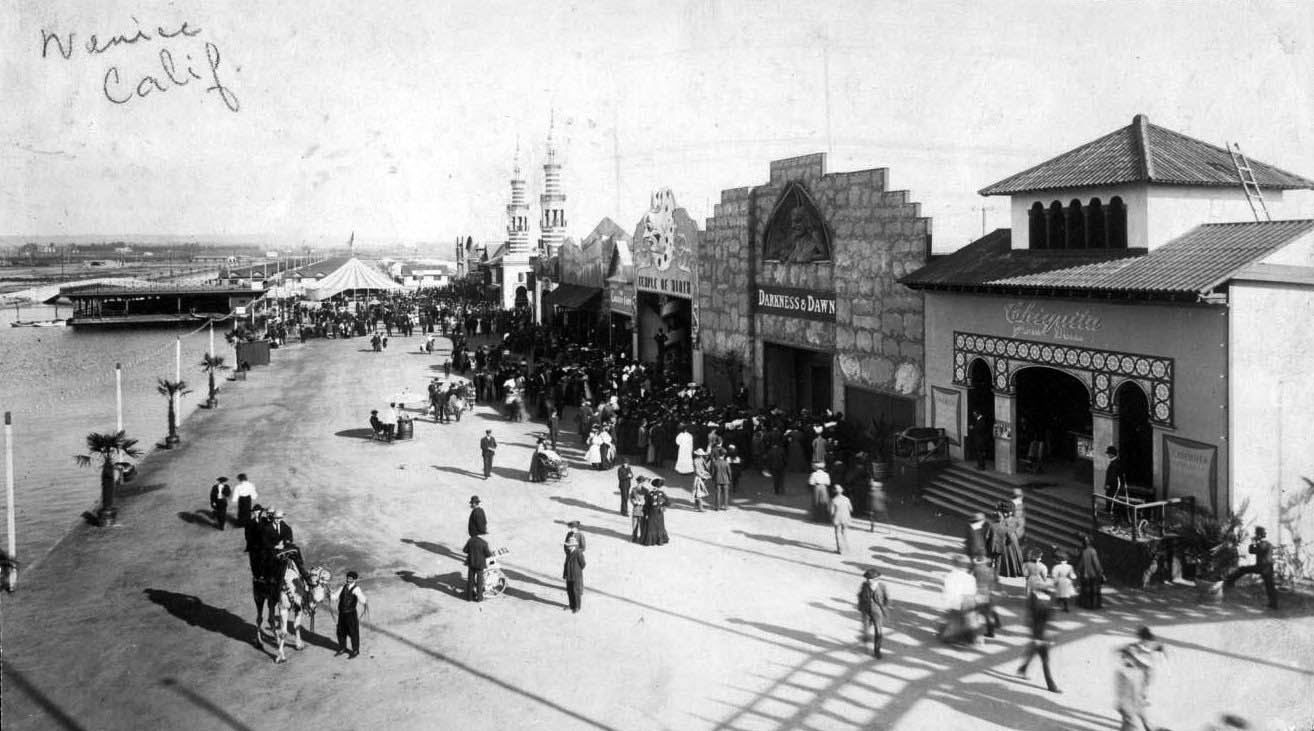 |
|
| (ca. 1906)^^ - Panoramic view of the Midway Plaisance Amusement Park in Venice showing crowds gathered in front of "Temple of Mirth," "Darkness and Dawn" and "Chiquita”. Note the camel right at lower left. |
Historical Notes The Midway Plaisance name was taken from an amusement area in the 1893 Chicago Worlds Fair. It was torn down in 1911 and replaced with the Races thru the Clouds roller coaster.**^ |
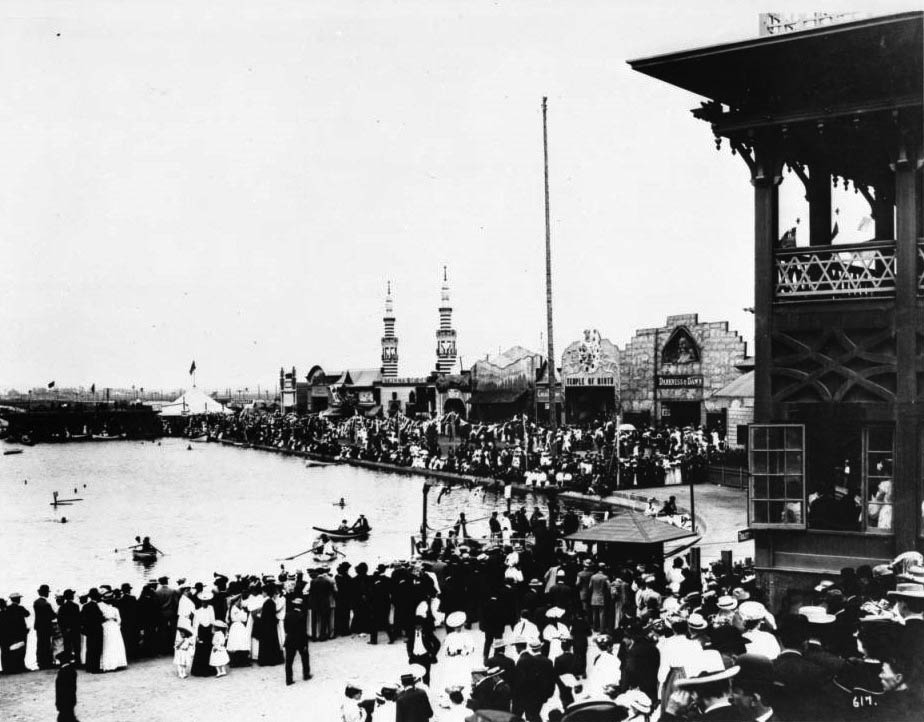 |
|
| (ca. 1906)^^ - View of the Venice Lagoon and the Midway Plaisance, showing a crowd watching boatmen on the water. A throng of pedestrians have crowded around the bank and look expectantly at the lagoon. Amusement booths surround the area just back from the water. |
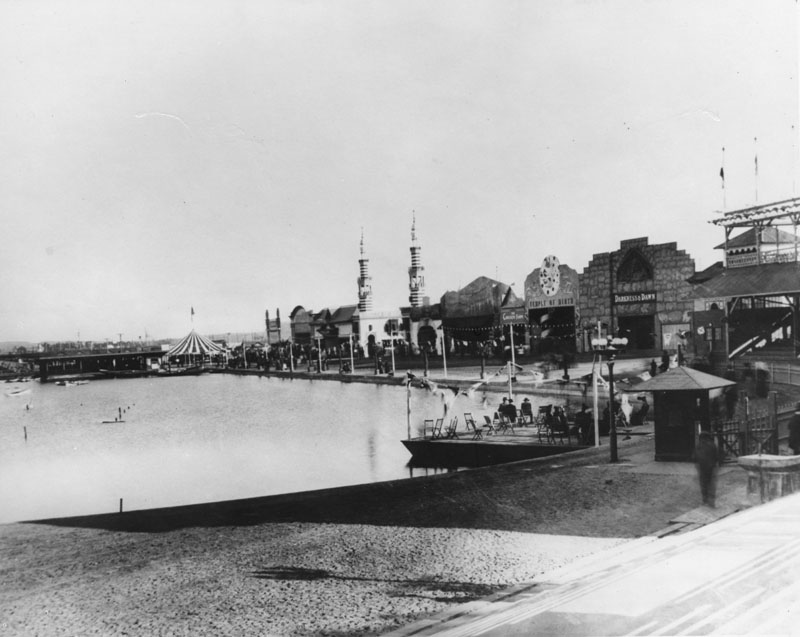 |
|
| (ca. 1906)* - The Midway Plaisance had many popular attractions such as the portable carousel in the striped tent seen on the far side of the water. It was Venice's first carnival with attractions coming from the Lewis and Clark Exposition and the St. Louis World's Fair. |
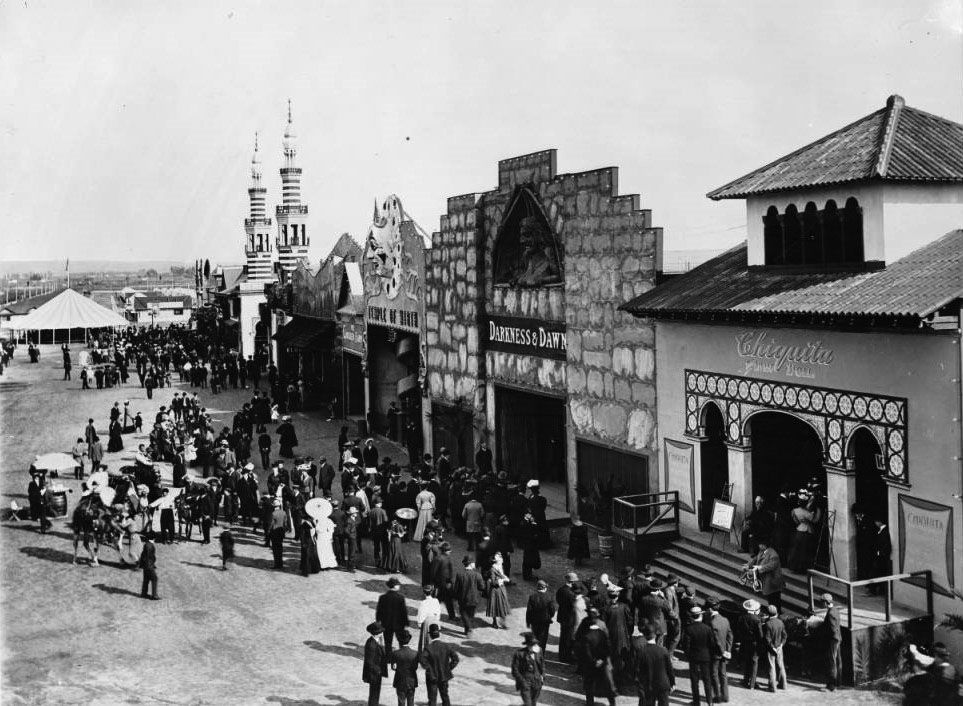 |
|
| (1910)^^ - View showing pedestrians enjoying the sideshows along the Midway by the Venice Lagoon. An assortment of amusement venues can be seen lined-up edge to edge to the right of the image. Pedestrians at center are shown walking along at sand road, some of them enjoying camel rides. Legible signs from left to right include: "Temple of Mirth", "Darkness & Dawn", and "Chiquita". |
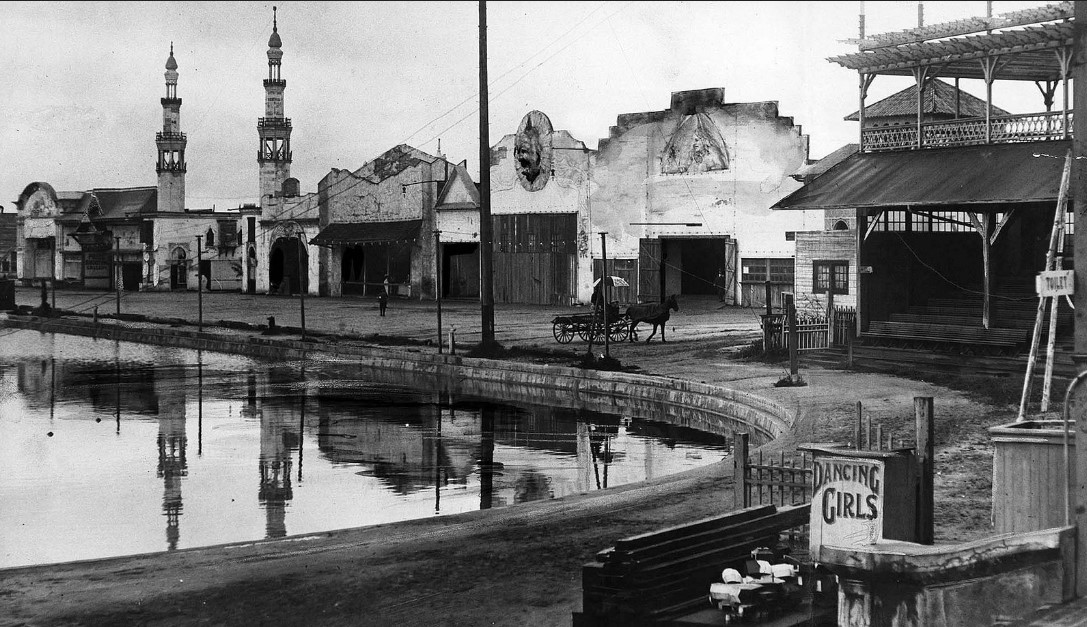 |
|
| (1911)*^# – Photo caption reads: The closed Midway Plaisance at Venice awaits the wrecking crew to make way for a roller coaster. LA Times Photo - April 1911 |
Historical Notes On July 1, 1911, the Los Angeles Times reported that the Giant Safety Racing Coaster was opening. It was named “Race Thru the Clouds” and was the ride sensation of the season.*^# |
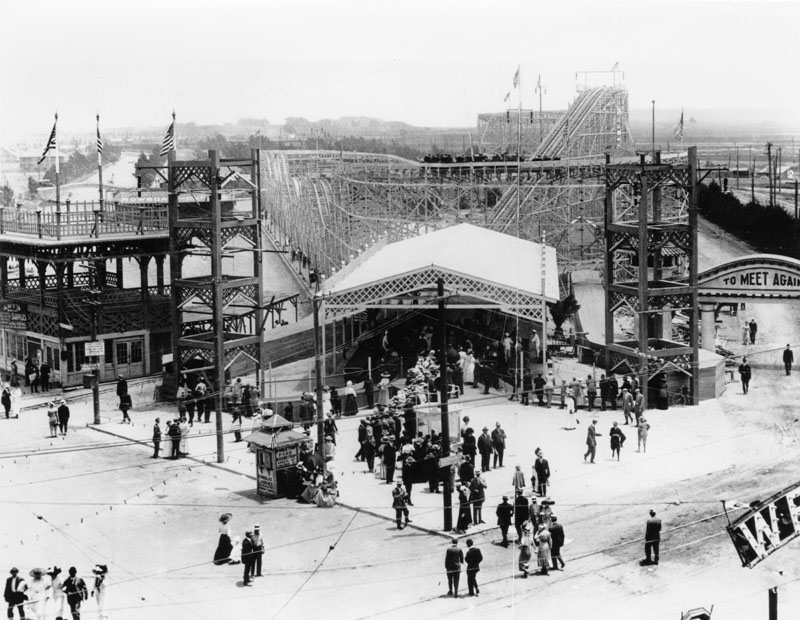 |
|
| (ca. 1911)* - As viewed from the roof across the street, people are lined up and waiting to get on the Race Thru the Clouds roller coaster which stretches out behind the entrance. |
Historical Notes Once roller coaster designer John Miller incorporated an extra set of under-wheels on each car to prevent them from lifting off the tracks once they reached the top of the hills and began their abrupt descents, the dips became deeper and the cars went faster. His Race Thru the Clouds, a racing roller coaster, built beside Venice's inland canalled lagoon by Prior and Church in 1911, was so popular that on opening day, with only half of its cars on line, 25,230 people rode the ride.^ |
* * * * * |
Ocean Park and Other Santa Monica Amusement Parks
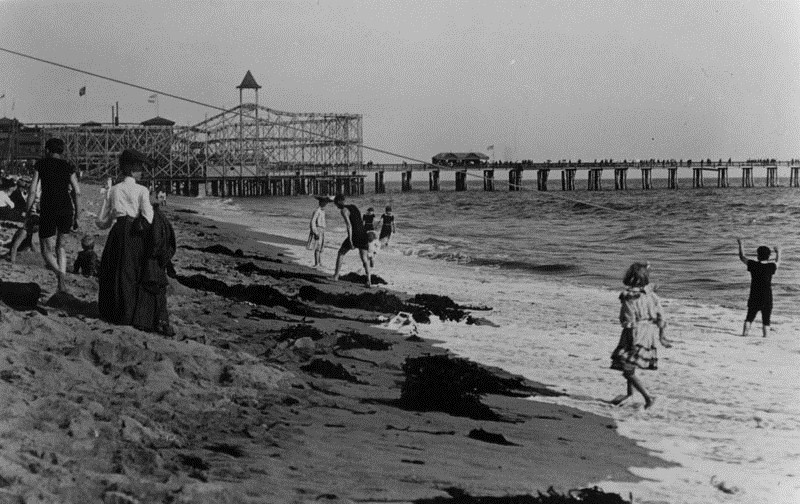 |
|
| (1912)* - View of the seashore at Ocean Park Beach in Santa Monica, 1912. The roller coaster seen on the pier was called Ingersol's Scenic Railroad. |
Historical Notes Amusement piers became enormously popular in the first decades of the 20th century. The extensive Pacific Electric Railroad easily transported to the beaches people from across the Greater Los Angeles Area. Competing pier owners commissioned ever larger roller coaster rides. Wooden piers turned out to be readily flammable, but even destroyed piers were soon replaced. There were five piers in Santa Monica alone, with several more down the coast. The earliest part of the current Santa Monica Pier, which is now the last remaining amusement pier, was built in 1909 on what was referred to as the North Bay. The second half, an amusement park pier, was built later and the two rival piers were merged.^ |
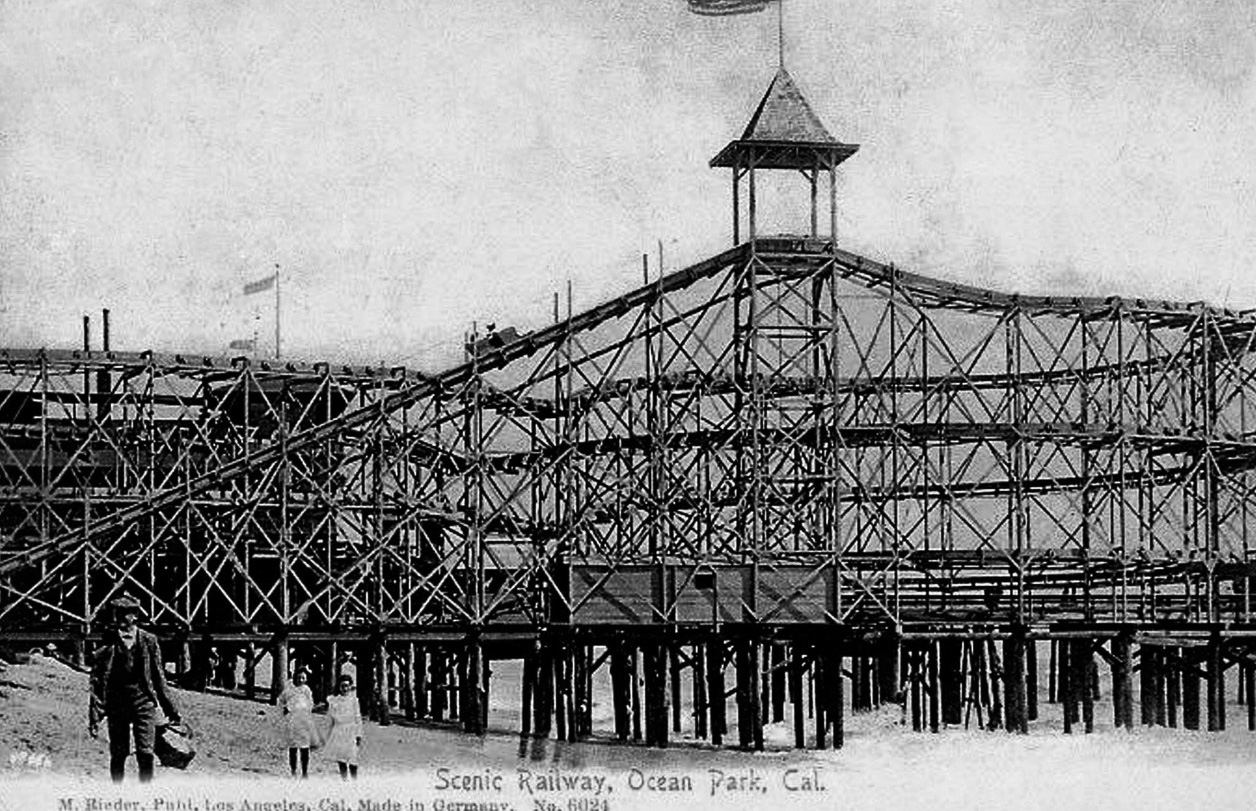 |
|
| (ca. 1912)^*^# – Postcard view showing a man and two young girls walking along the beach with the Ocean Park Scenic Railway Roller Coaster in the background. |
Historical Notes In 1904, Ingersol's Scenic Railroad was the first roller coaster to be installed in the Venice / Ocean Park area.^ |
 |
|
| (1912)* - Large crowds are gathered near a concert shell in Ocean park. There are more people than seats. Edges of buildings of several businesses can also be seen such as real estate and restaurants. An early model car and several horse-drawn wagons are parked in the foreground. |
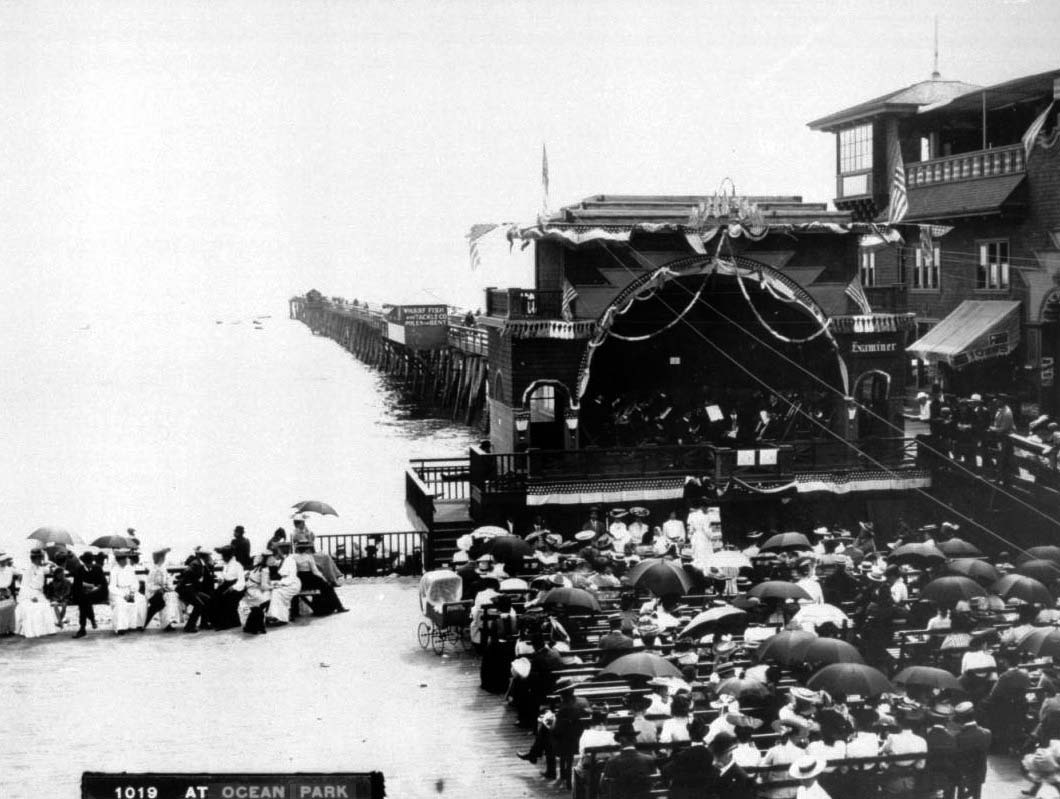 |
|
| (ca. 1910)^^ - Closer view of the Ocean Park bandstand showing Harry Moore's band playing in front of a crowd. Dozens of people, many holding umbrellas, are seated in chairs in front of the band, watching. Attached to the bandstand at right is a casino, and a pier juts into the water behind the bandstand building. More people can be seen seated on benches at left near the water's edge. A small shack on the edge of the pier is adorned with the words "Wharf Fish and Tackle Co. Poles for Rent". |
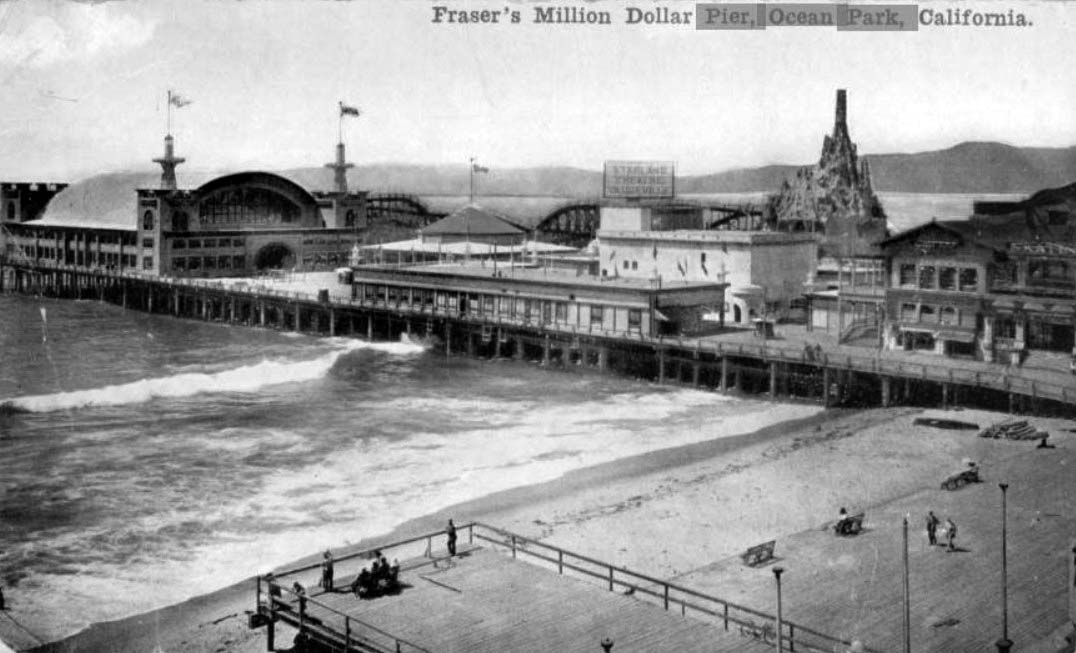 |
|
| (ca. 1911)^^ – Postcard view showing Fraser's Million Dollar Pier, Ocean Park. Fraser's Dance hall, the roller coaster, and Starland Theater can be seen on the pier, with a boardwalk and beach in the foreground. |
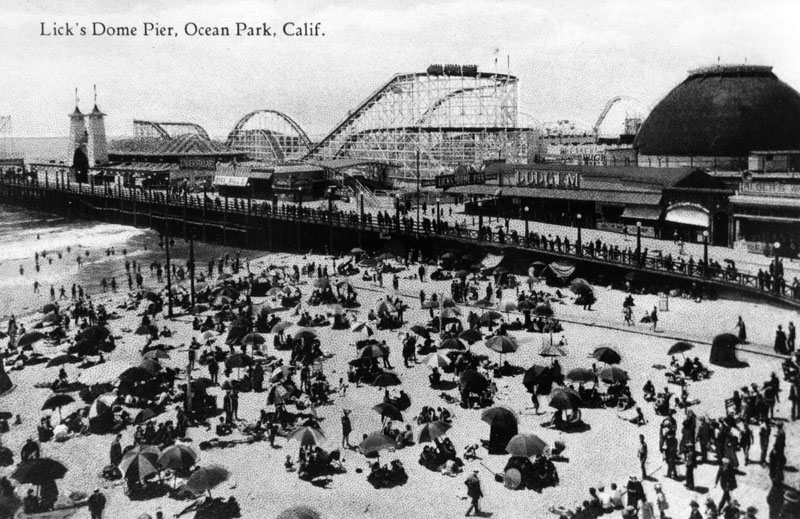 |
|
| (ca. 1911)* - View of the Lick's Dome Pier at Ocean Park. |
Historical Notes In 1911, Charles Lick added Lick Pier to the new Million Dollar Pier. They were both destroyed by fire in 1912 and again in 1924. The Lick Pier was rebuilt both times. The pier was finally done in by a fire in 1970, after which it was not rebuilt.*^*^ |
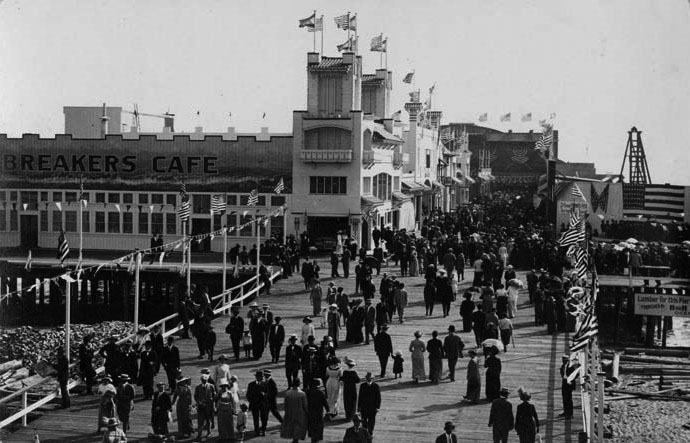 |
|
| (Early 1900s)^*# - A crowded day at the Ocean Park Pier in Santa Monica. |
Historical Notes The Ocean Park Pier, a combination of two piers: Million Dollar Pier and Lick Pier, burned down in 1912. In its place was rebuilt Fraser's Million Dollar amusement pier, which claimed to be the largest in the world at 1250 feet long and 300 feet wide. The pier housed a spacious dance hall, two carousels, the Crooked House fun house, the Grand Electric Railroad, the Starland Vaudeville Theater, Breaker's Restaurant and a Panama Canal model exhibit. It too burned within the year.^ |
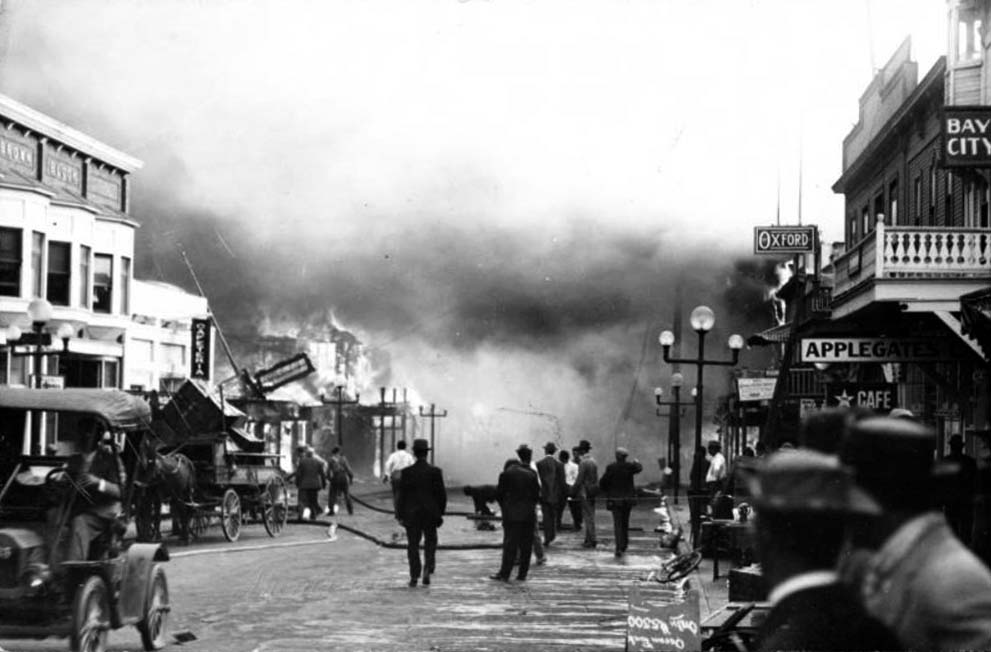 |
|
| (1912)^^ - View showing people working to extinguish the fire on the Ocean Park pier in Santa Monica, 1912. The fire is blazing in the distance at left. A group of onlookers is gathered at center as is watching as firemen drag a large hose towards the building. The dirt road at center is muddy from the water used to fight the fire. An early automobile can be seen at left, and a large horse-drawn wagon is parked near the edge of the street at left. A collection of two-story buildings lines the road.; Legible signs include, from left to right: "Brown Block", "Cafeteria", "Oxford", "Applegate's Café", and "Bay City". |
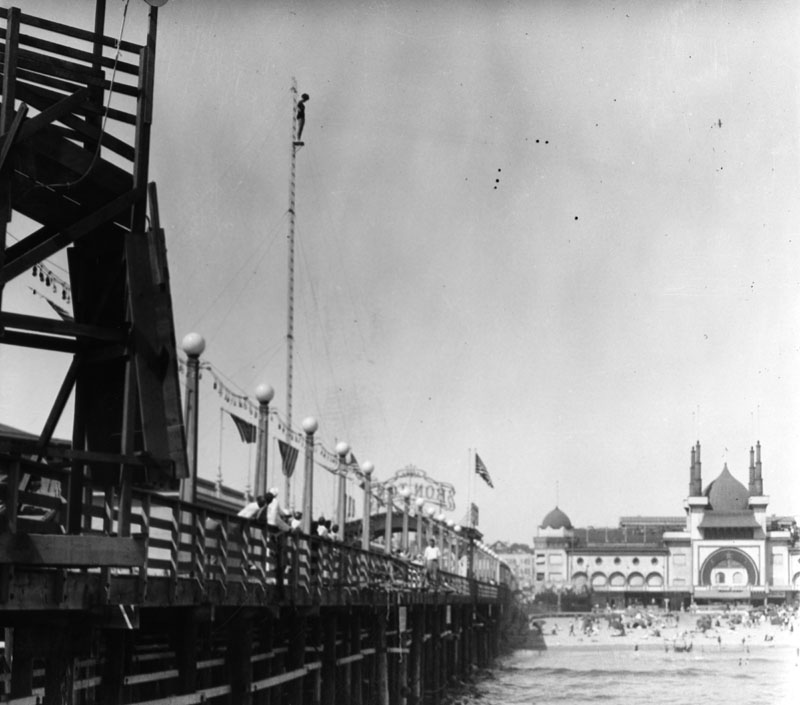 |
|
| (Early 1900s)* - Looking down the right side of the pier (a few people can be seen on it, towards the beach and the bath house behind it. |
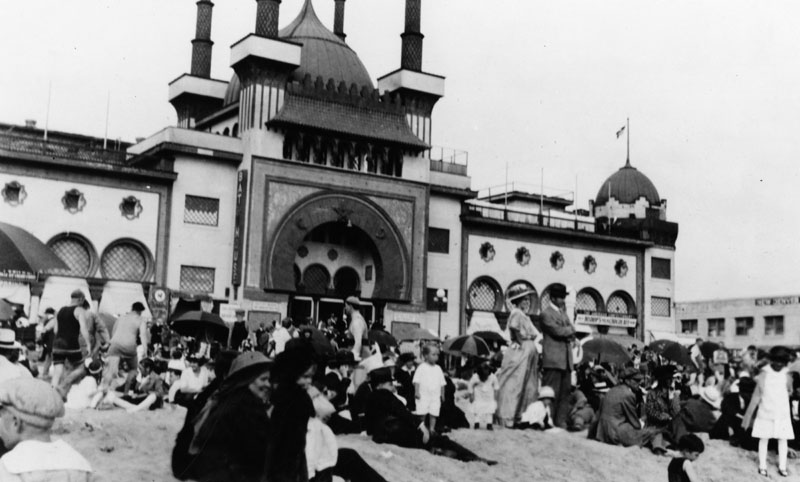 |
|
| Early 1900s)* - Crowded beach at Ocean Park in front of the Bath House. |
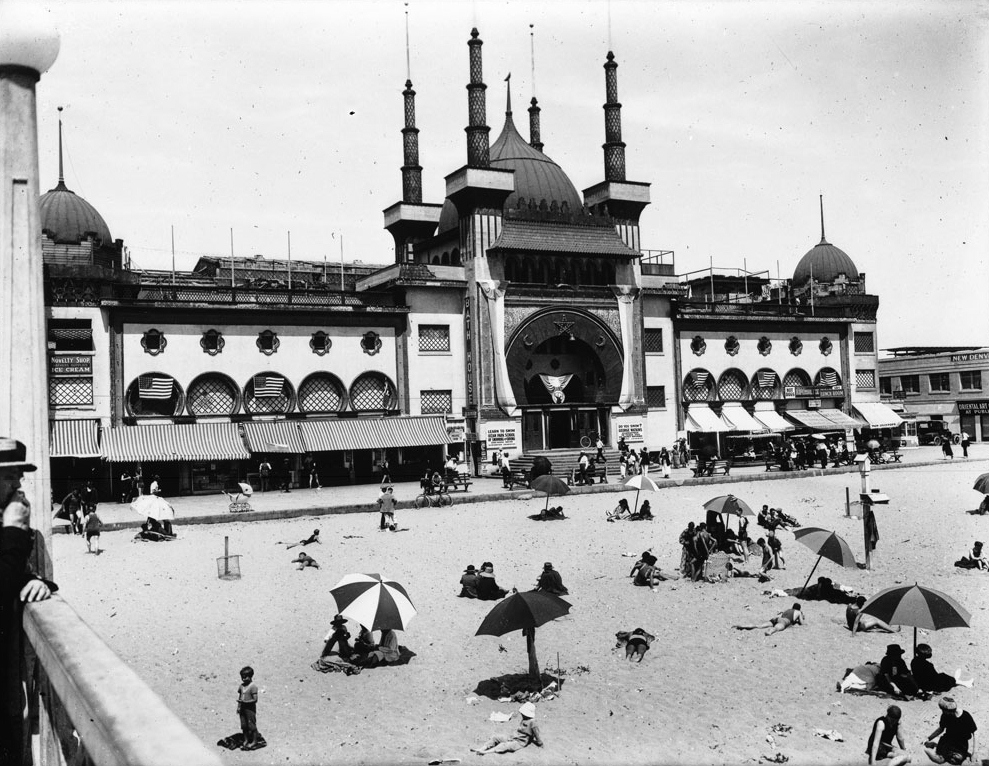 |
|
| (ca. 1920)^^ - Exterior view of the Ocean Park Bath House in Santa Monica. The bath house is at center and is a large Moorish-style building. At the center of the building is an elaborate entry way consisting of a large domed tower surrounded by four tall spires. Smaller domed towers occupy the corners of the buildings. Awnings project from the bottom story of the building, and rows of round windows occupy the second and third stories. |
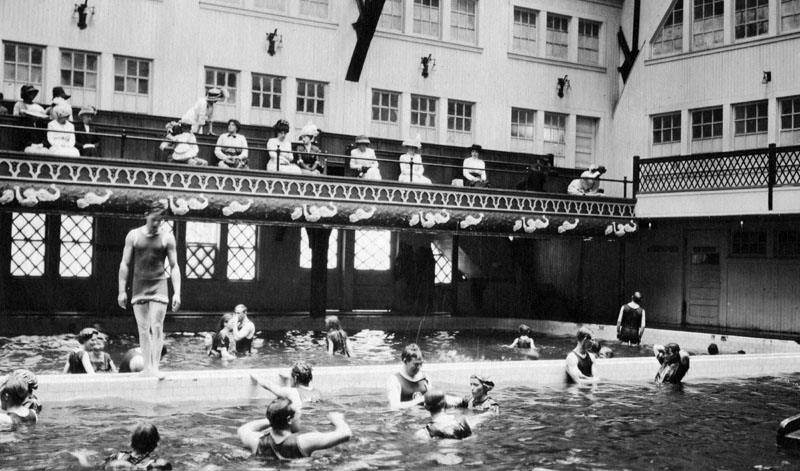 |
|
| (Early 1900s)* - View of the indoor plunge in Santa Monica-Ocean park. Several people are swimming while spectators (in street clothes) watch from the bleachers along the side. |
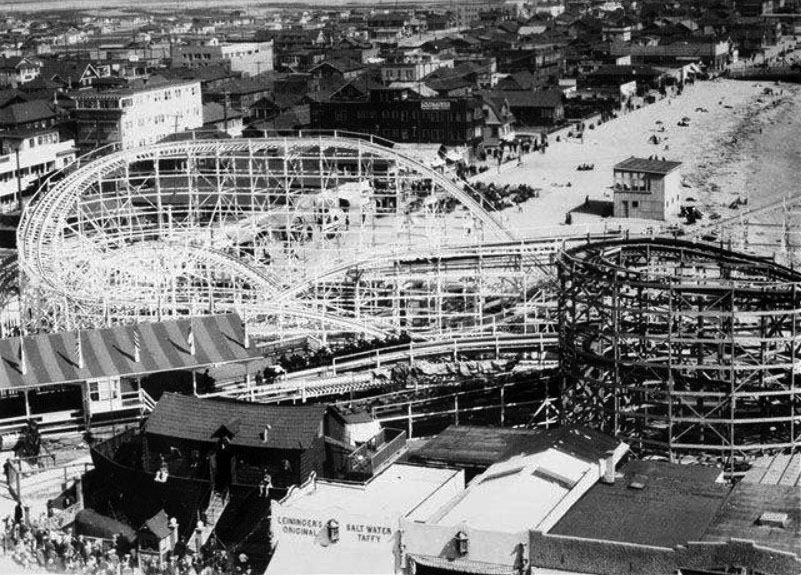 |
|
| (1916)#^^ - View of Venice Pier showing the Giant Dipper roller coaster known as "The Wicked One" and Noah's Ark. |
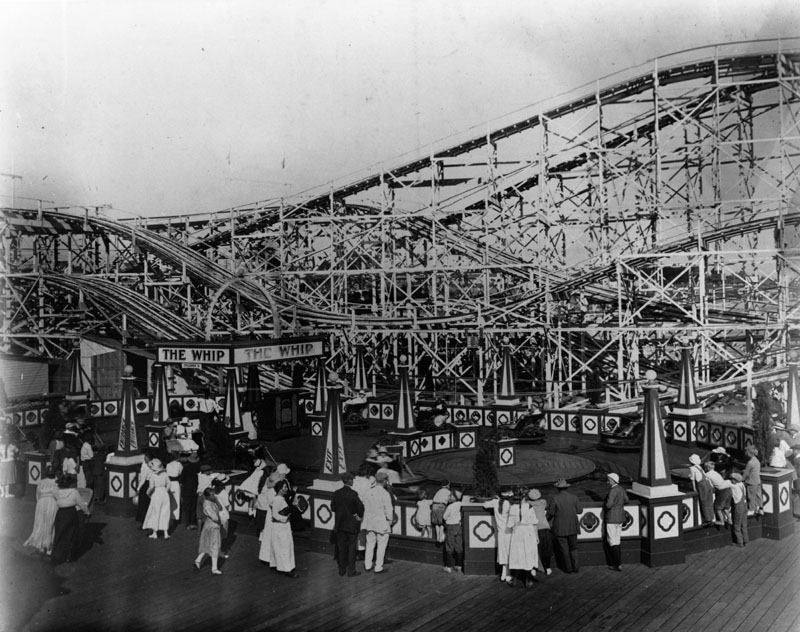 |
|
| (1917)* - The Whip, a ride consisting of 8 coasters in the shape of blue sharks, at the pier in Santa Monica. |
_1916.jpg) |
|
| (1916)#^^ - View of Venice Pier, Giant Dipper roller coaster, Noah's Ark, and the Ship Café in the background. |
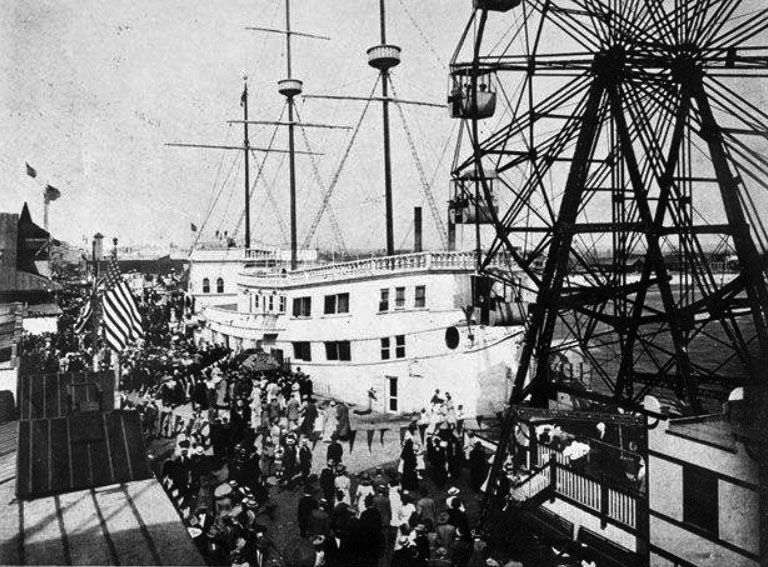 |
|
| (1918)#^^ - View of a crowded Venice Pier showing the Ship Café and ferris wheel. |
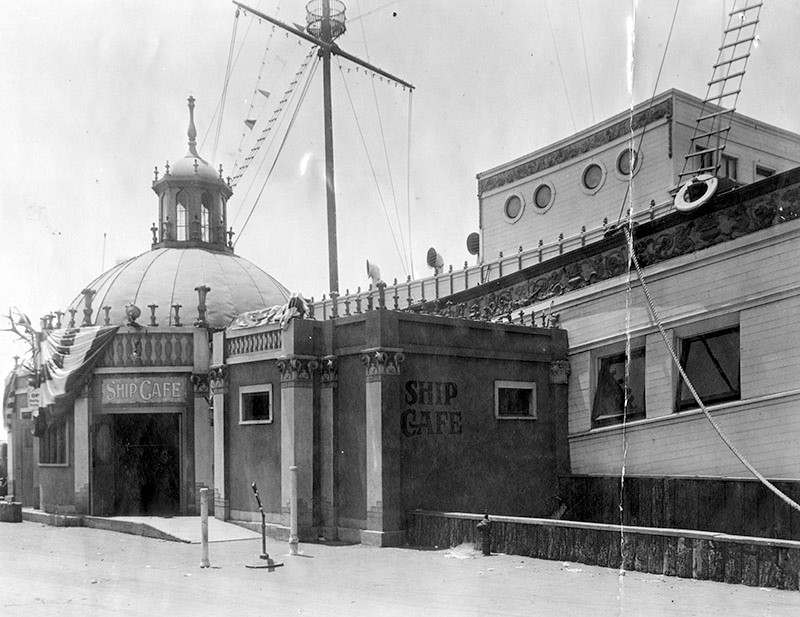 |
|
| (1920s)* - View showing the entrance to the Ship Café, built in 1905. |
Historical Notes The Ship Café, part of The Ship Hotel was the place to go in Venice, California. The restaurant was built on pilings and was designed to be a replica of Juan Cabrillo's Spanish galleon. It was one of the great attractions of the original Venice Pier. High priced cuisine was served in the main dining room as well as in private salons on the second deck. The staff was uniformed like 16th century naval officers. In 1946 the city council voted to tear down the Venice Pier, including the Ship Café.* |
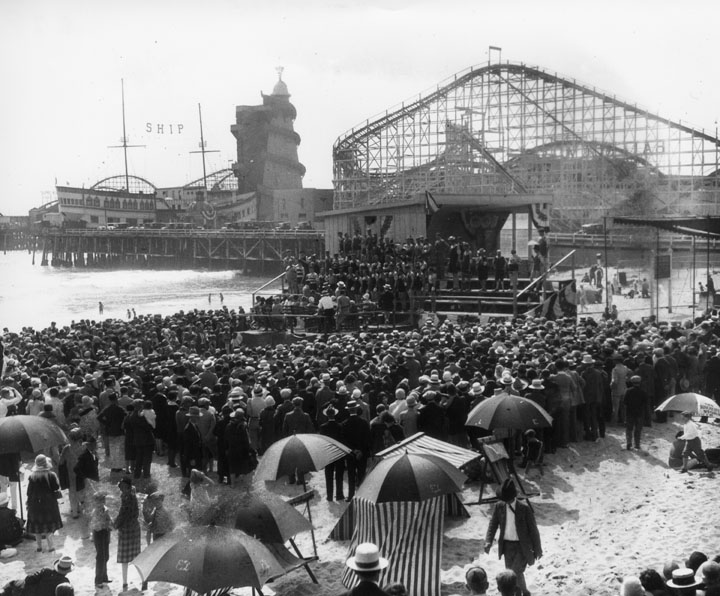 |
|
| (n.d.)* - A huge crowd fills the beach near the Venice Pier. A platform and stage can be seen at the base of the roller coaster. In the background is can be seen the Ship Café. |
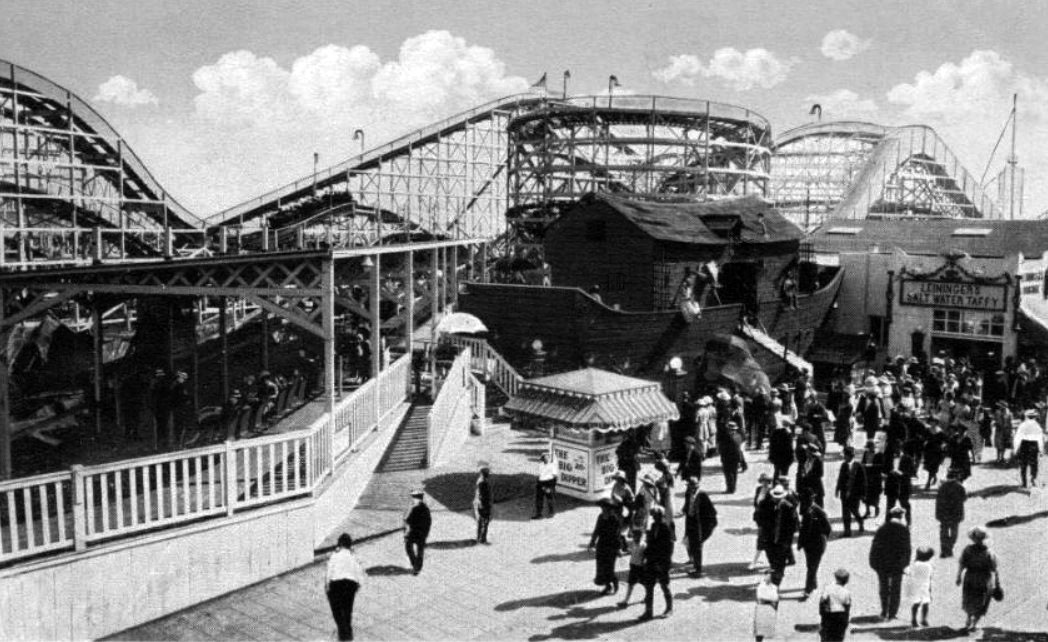 |
|
| (1922)^*## – Postcard view showing some of the amusement rides at Venice Pier. To the left is the entrance to “The Big Dipper”. At center is “Noah’s Ark”. To the right a large sign reads: “Lenninger’s Salt Water Taffy” |
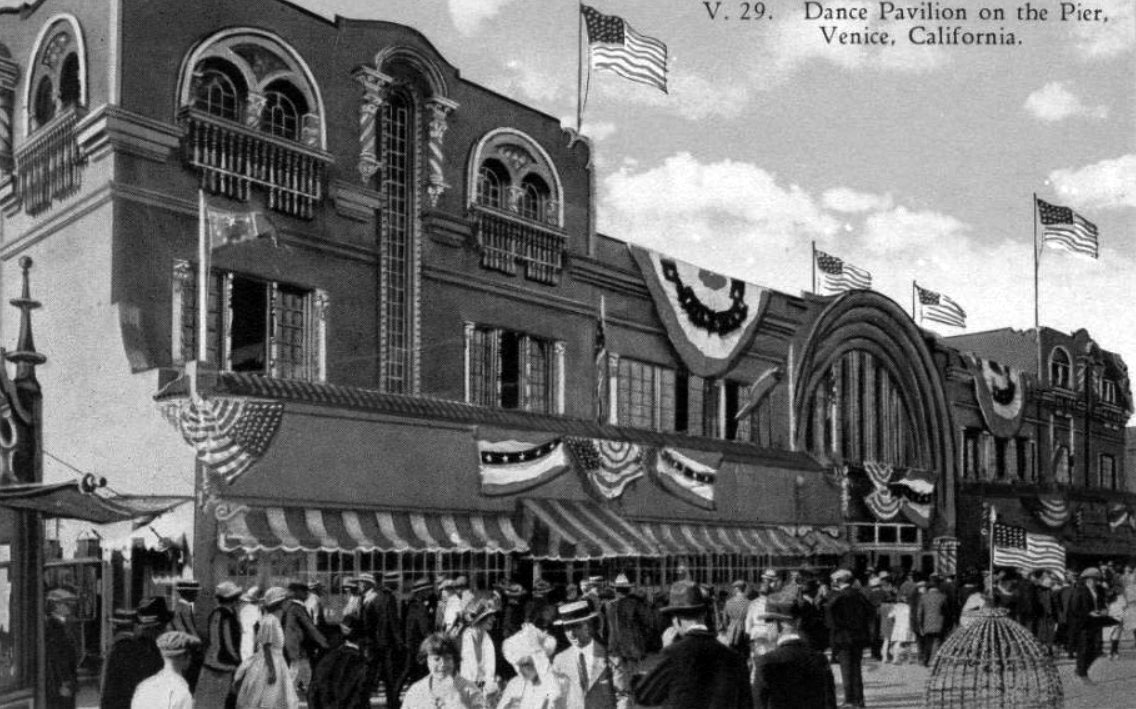 |
|
| (1922)^*## – Postcard view showing the Dance Pavilion on the Venice Pier. |
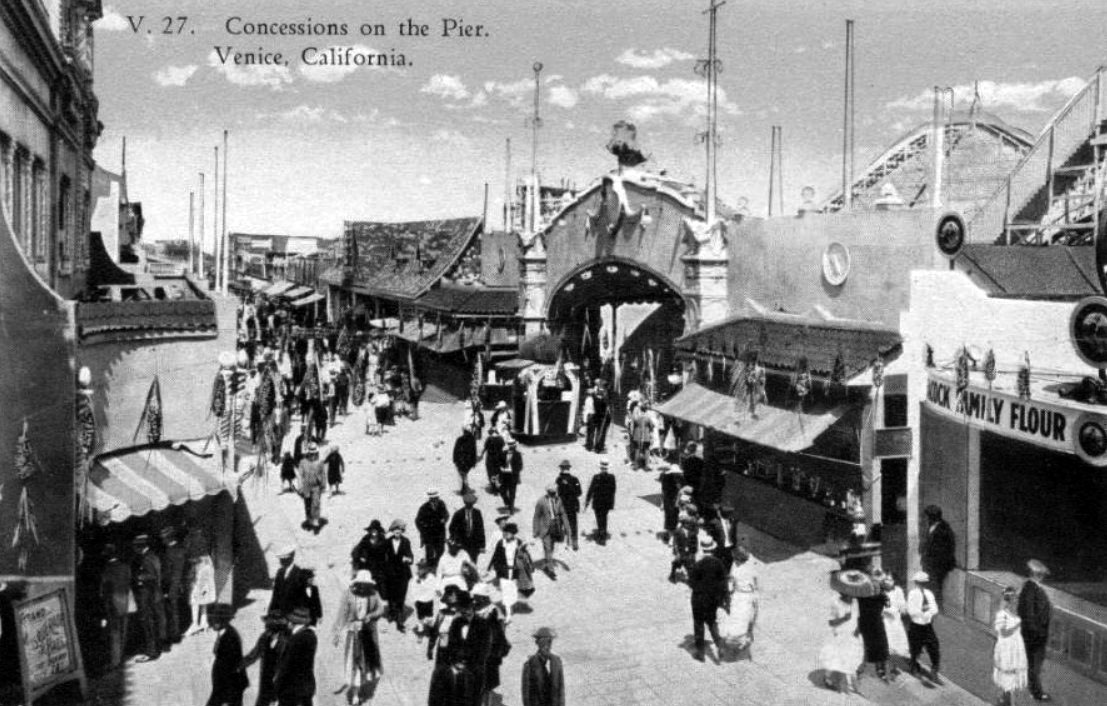 |
|
| (1922)^*## – Postcard view titled: Concessions on the Pier. Venice, California. |
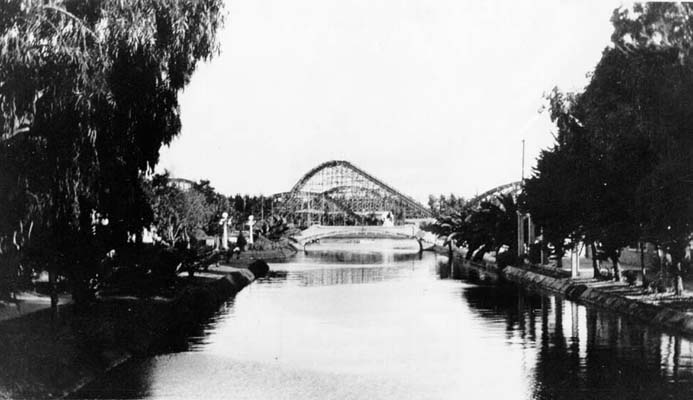 |
|
| (1921)* - Canal with roller coaster in view in the background. |
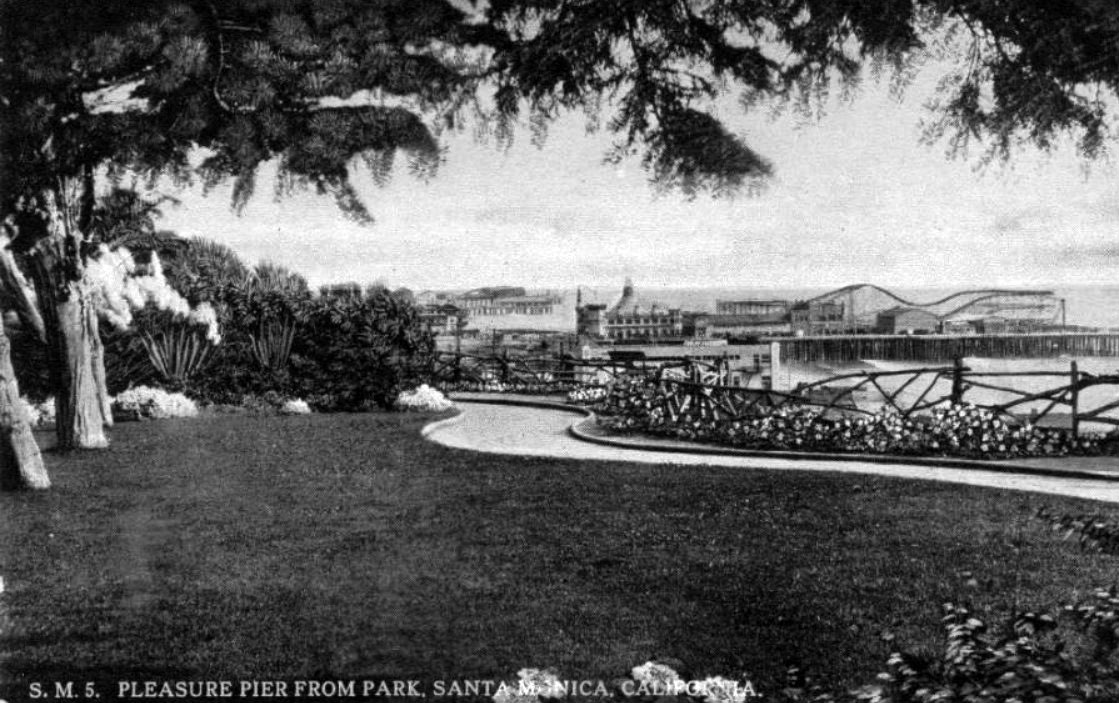 |
|
| (1922)^*## – Postcard view showing the Santa Monica Pleasure Pier from Palisades Park. Part of Ocean Park Pier can also be seen in the background. |
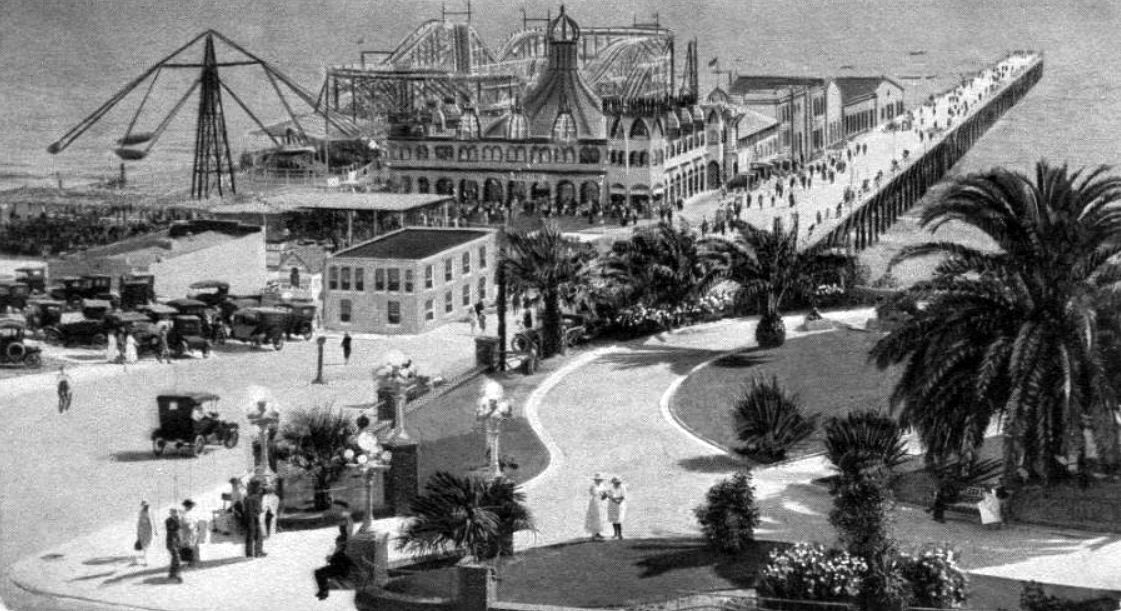 |
|
| (1922)^*## – Postcard view showing Pleasure Pier in Santa Monica. |
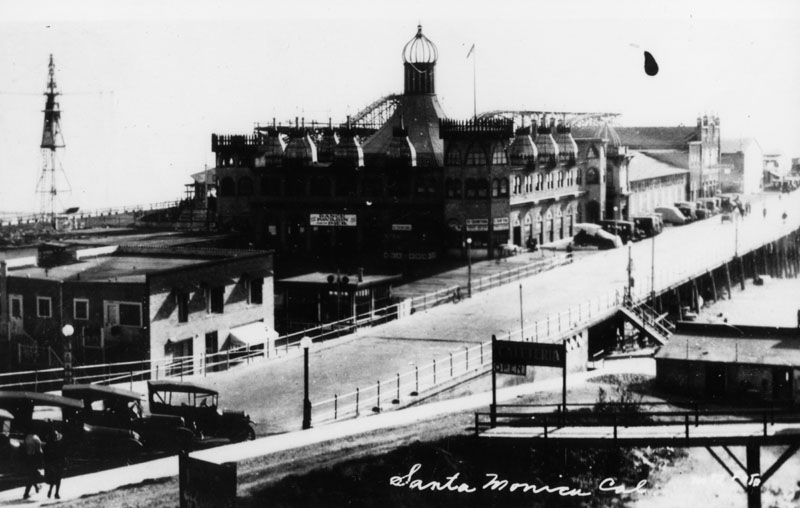 |
|
| (ca. 1922)* - View of the pier and carousel building in Santa Monica. |
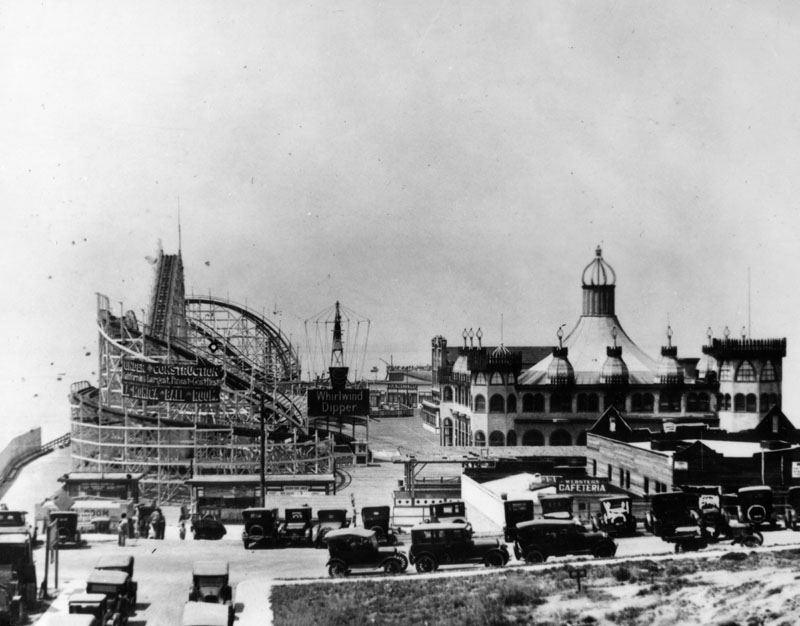 |
|
| (ca. 1924)* - View shows an Ocean Park, complete with wooden roller coaster, on the Santa Monica pier. |
Historical Notes In 1916, Charles I.D. Looff constructed a Moorish-Byzantine hippodrome, which housed a merry-go-round with 44 hand-crafted horses, a billiards and bowling hall, a two-track Blue Streak Racer wooden roller coaster along with The Whip and the Aeroscope thrill rides, a "What Is It?" maze, and several smaller rides. Looff's opening day, July 4, 1917, drew over 100,000 people; the biggest crowd in the city's history. In 1987, the Santa Monica Looff Hippodrome was added to the National Registry of Historic Places.* |
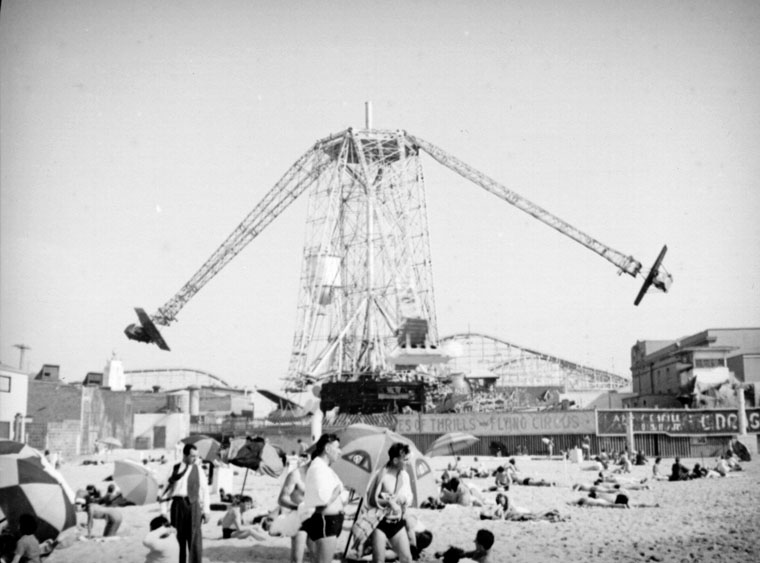 |
|
| (ca. 1925)* - Two airplanes rotating around the center tower on the Venice amusement park ride are visible. This ride, called the Flying Circus has 6 to 8 passenger cars circling the main tower 65 feet above the peer. Seen here from the sandy beach in the foreground. |
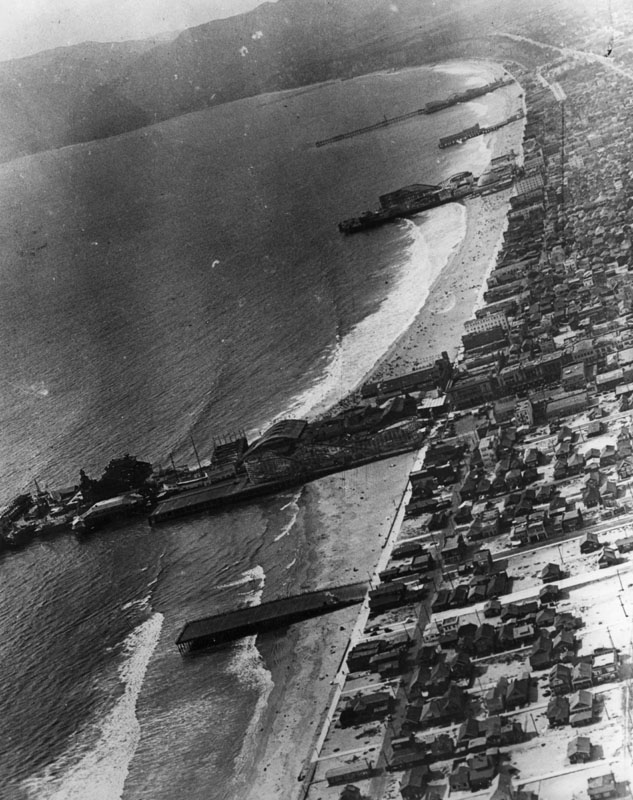 |
||
| (1920s)* - Aerial view looking north all along the coast of Venice and the whole Santa Monica Bay area. At least 6 or 7 piers can be seen extending out into the ocean. Venice Pier and amusement park can be seen in the foreground. Ocean Park Pier, with its own amusement park, is the next pier over. Beyond that, the long pier at the top of the photo, is the Santa Monica Pier. It also had an amusement park. |
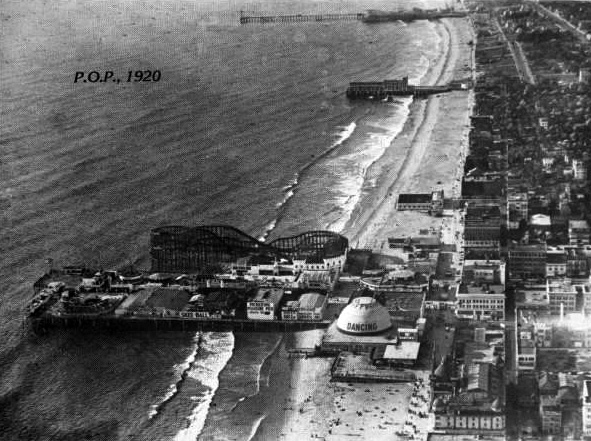 |
|
| (1920)*##* - Aerial view of Ocean Park Pier showing it's large roller coster. The long pier to the north (top of photo) is the Santa Monica Pier. It too had its own amusement park starting in 1916. |
Historical Notes The Venice, Ocean Park and Santa Monica amusement piers were within a mile and one half of each other and they competed directly with each other for the tourist's entertainment dollars. Fourteen coasters were built there from 1904 to 1925.^ |
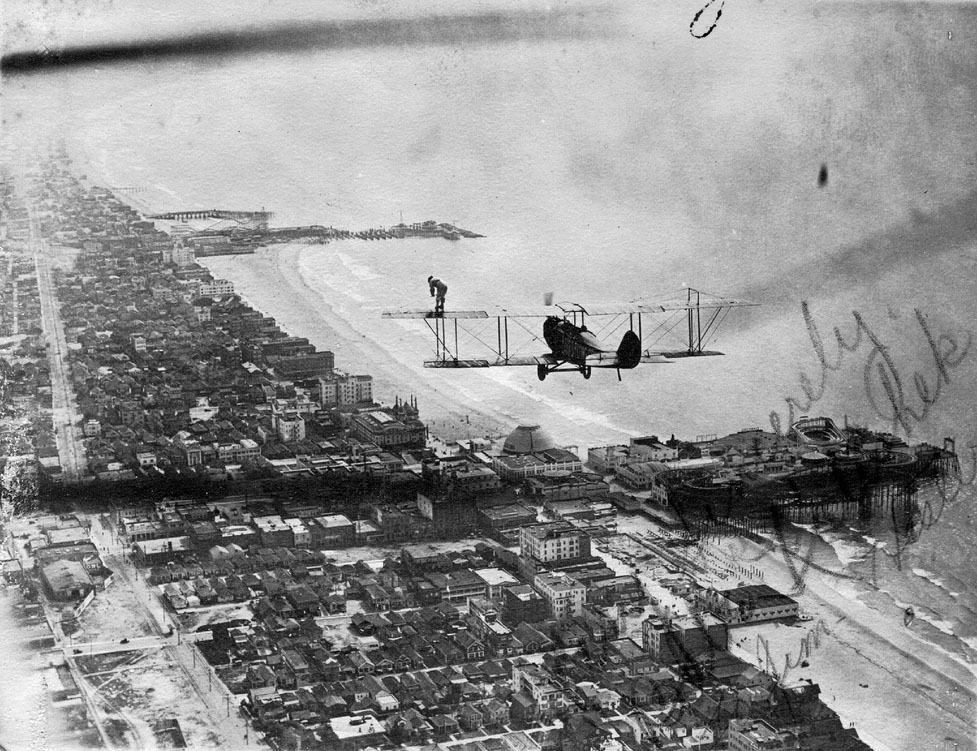 |
|
| (1918)*#^# - Walking over Santa Monica. Aerial view of a bi-plane flying over Santa Monica. A woman is standing on the wing looking down. Ocean Park Pier with its amusement park appears just below the plane and Venice Pier is seen in the distance. |
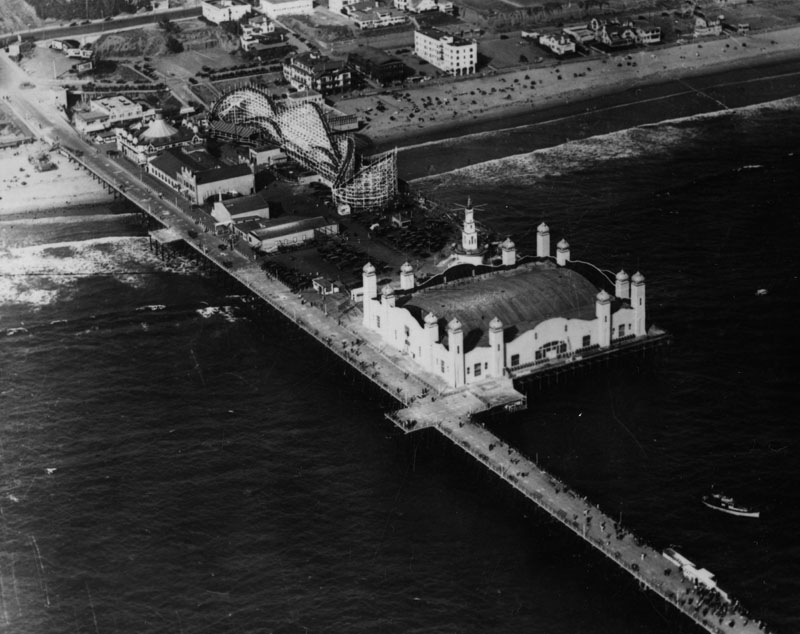 |
|
| (1924)* - The Santa Monica Pier, with the La Monica Ballroom and roller coaster, captured from above. |
Historical Notes The Spanish and French Renaissance style La Monica Ballroom was designed by T.H. Eslick; it opened in 1924 and was demolished in 1963.* More than 50,000 people attended the July 23, 1924 grand opening of the La Monica Ballroom, enough to cause the first traffic jam recorded in Santa Monica history. Its 15,000 square-foot hard maple floor and exquisite “submarine garden” interior made the La Monica the hottest ticket in town.^**^ |
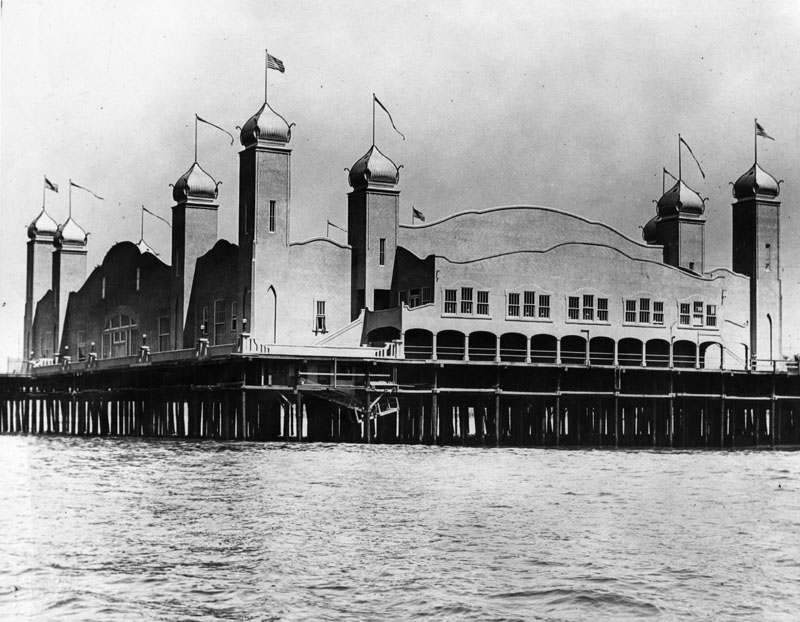 |
|
| (1924)* - Exterior view of the La Monica Ballroom on the pier in Santa Monica. |
Historical Notes The La Monica Ballroom was located at the end of the 1,600-foot long Santa Monica Pier. It was especially popular during the Big Band Era of the 1920s & 30s, up to 2,500 couples could kick up their heels in this grand ballroom located at the end of the Pier.*^*^ |
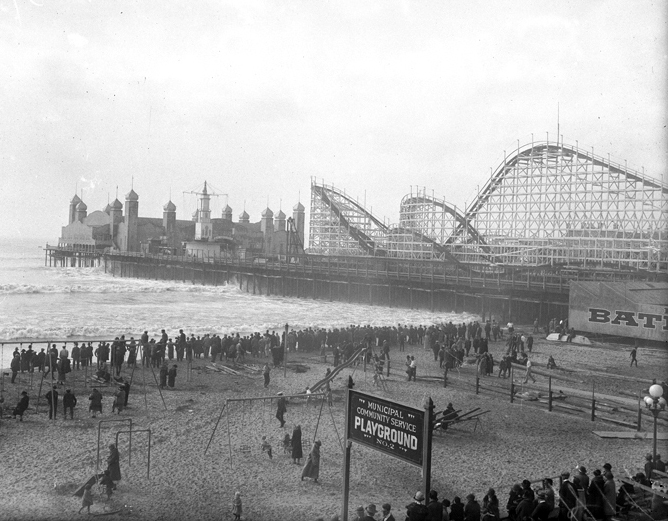 |
|
| (1924)^*^* - View looking northwest toward the Santa Monica Pier. In the foreground is the "Municipal Community Service Playground No. 2. Beyond that, crowds of people are seen looking out toward the surf. In the background stands the pier with its roller coaster and the newly constructed Lamonica Ballroom, built in 1924. |
Historical Notes The La Monica Ballroom's success was short-lived as the Great Depression effectively ended the dance hall days. By the mid-1930’s it became a convention center, lifeguard headquarters and, for a short interim period, the City Jail. The building stood until 1963 when it was demolished.^**^ |
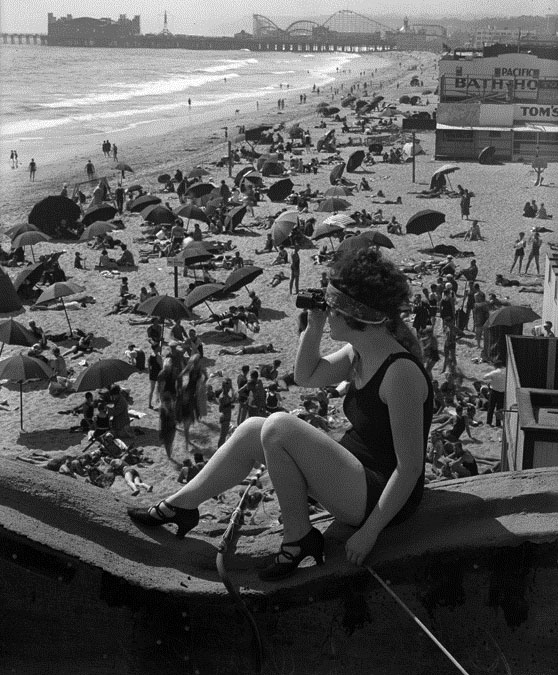 |
||
| (ca. 1924)*^^^ - Woman with spy glass looking out toward the ocean. The beach is full of sunbathers with the Santa Monica Pier and Amusement Park in the distance. |
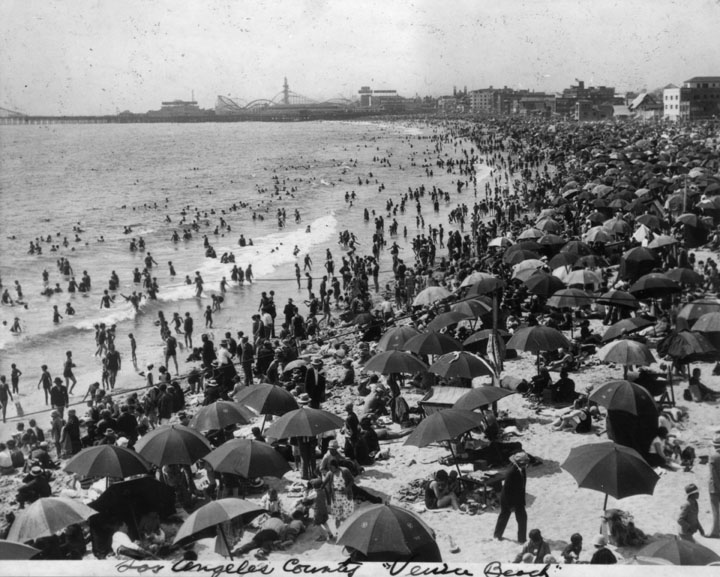 |
|
| (ca. 1925)* - The ocean water is filled with people swimming or playing, and the beach is likewise filled with people and umbrellas (to keep off the sun). The view is looking north towards Ocean Park. |
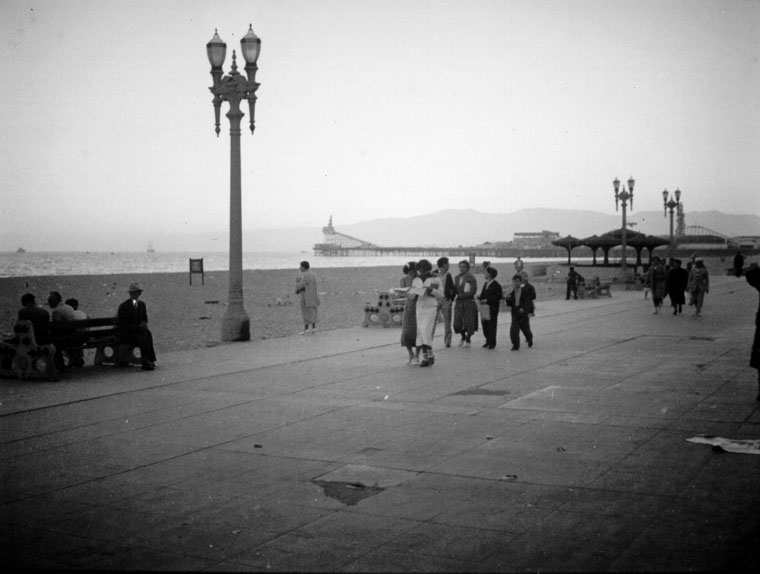 |
|
| (ca. 1926)* - A view across the strollers on the sidewalk and beach towards Lick Pier which was just over the Venice boundary line from Ocean Park. |
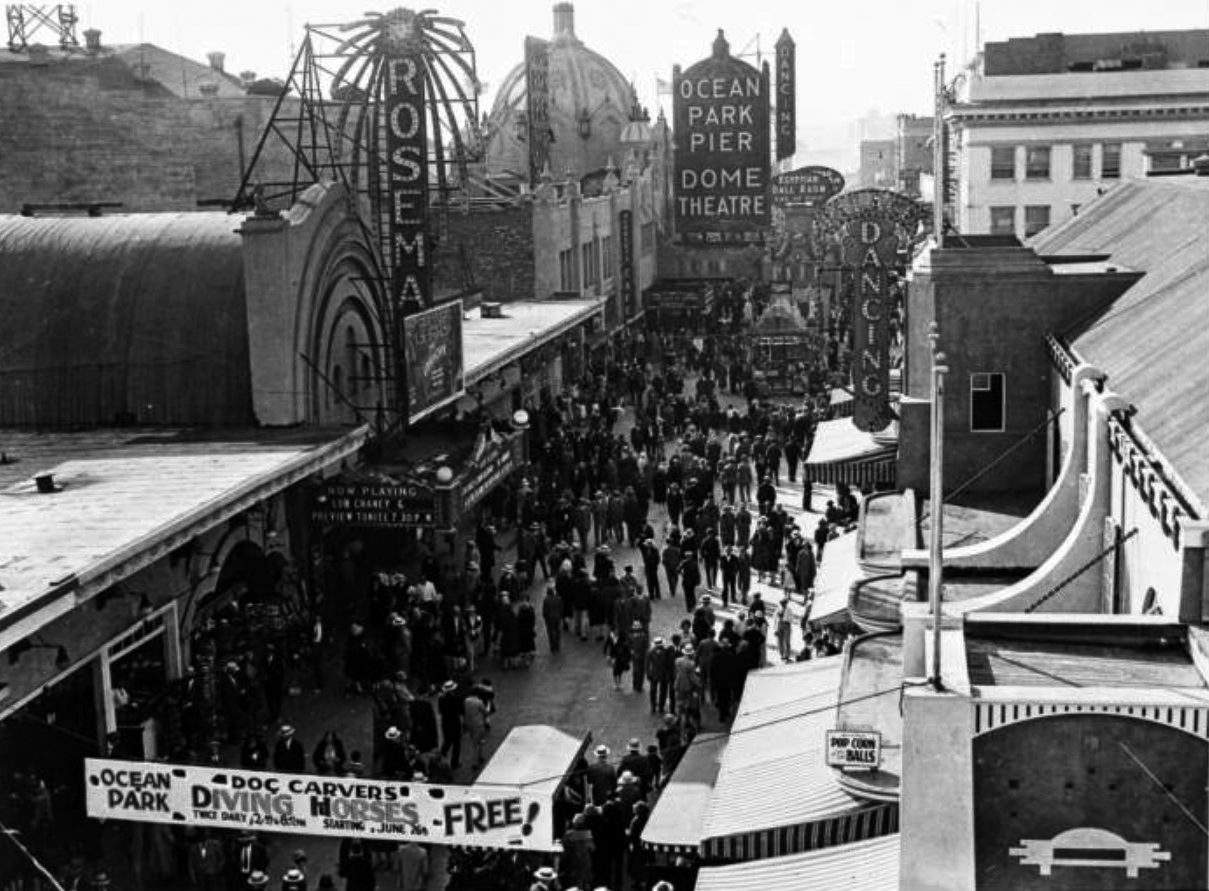 |
|
| (1927)#* - Image of a crowd of people on the Ocean Front Walk next to the Ocean Park Pier in Santa Monica, California. There is a banner in the foreground for "Ocean Park Doc Carvers Diving Horses- Free staritng June 26" and the marquee on the Rosemary Theater at left reads "Now playing Lon Chaney & Preview Tonite" with a poster for the movie "The Unknown." Additional signs include "Dancing", "Ocean Park Pier Dome Theatre", and "Egyptian Ball Room." |
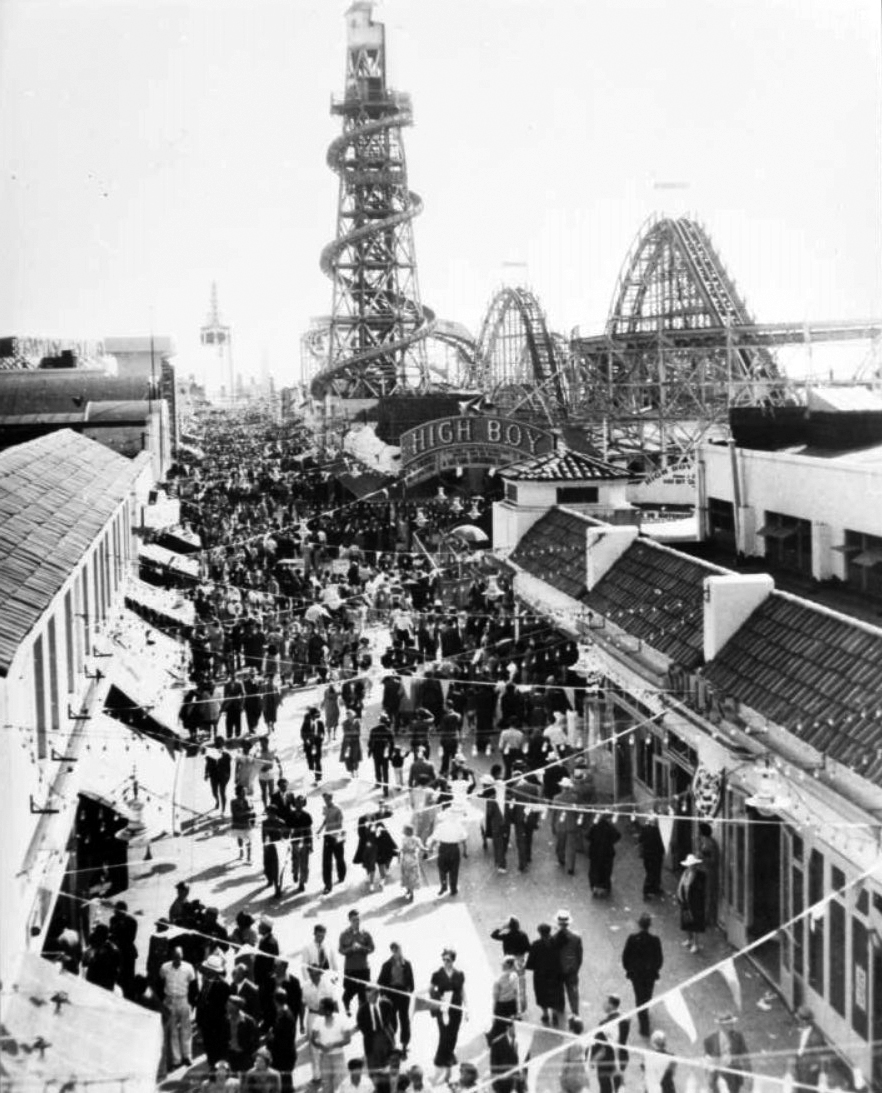 |
|
| (1929)#* – View showing the Lighthouse Slide, High Boy roller coaster and Chute the chutes ride on the Ocean Park Pier at Ocean Park in Santa Monica. |
 |
|
| (ca. 1928)* - A crowd has gathered to watch riders take the High Boy, a large wooden roller coaster at Ocean Park Pier. |
Historical Notes The High Boy (1926-1967) was a wooden out & back type roller coaster. It was renamed the Sea Serpent to fit in with the park's marine theme when Pacific Ocean Park opened in July 1958. After the park closed in 1967, it was sold at auction to Legend City in Phoenix, AZ. It was dismantled and stored for 15 years until the weather took its toll. |
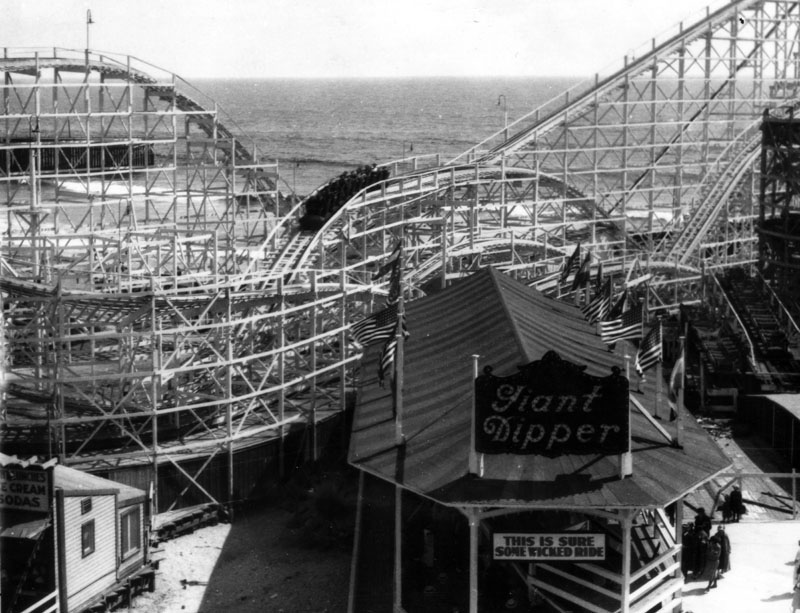 |
|
| (ca. 1920s)* - The sign below the roller coaster entrance reads "This is sure some wicked ride". From the tracks winding up and around behind (with at least one full car on the track), it certainly does not look tame. This ride replaced the Big Dipper coaster on the Venice Pier in 1924. |
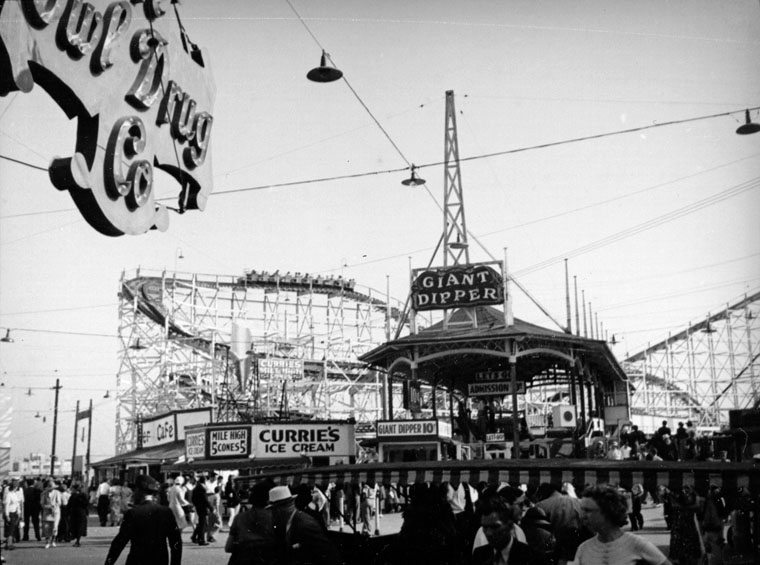 |
|
| (ca. 1928)* - The entrance and the roller coaster are seen from the Owl Drug Co. across the way. People are crowding the midway, and ice cream is for sale around the base of the coaster. This ride replaced the Big Dipper coaster on the Venice Pier in 1924. It only cost .10 cents to ride it. |
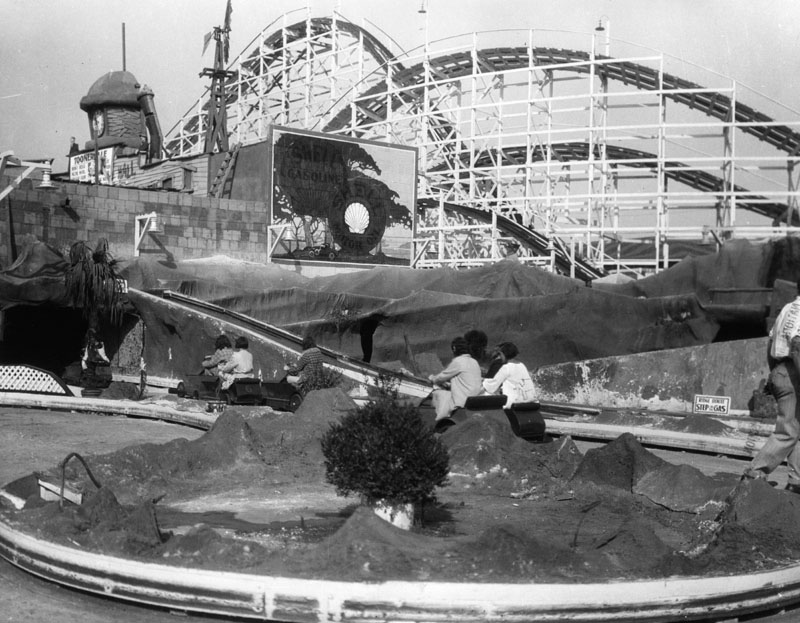 |
|
| (1928)* - View showing the Miniature Car Ride at Ocean Park. |
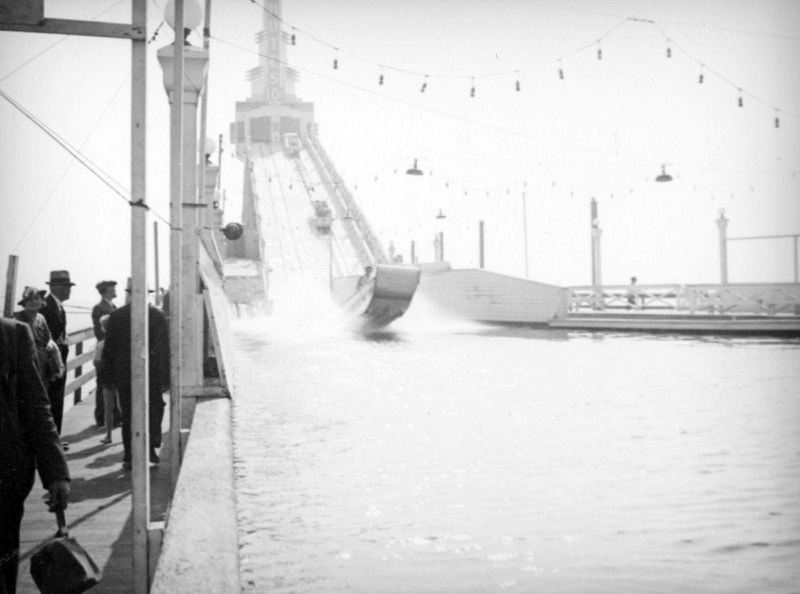 |
|
| (ca. 1937)* - People riding Chute the Chutes, a water slide at the seaward end of the pier at Ocean Park. |
Historical Notes The Ocean Park Pier was expanded for the final time during the summer of 1929. The length of the pier was extended 500 feet and five new buildings and attractions were added. Foremost was a $150,000 Shoot the Shoots ride; the highest amusement chute and the only one ever built on a pier. Its huge pool at the bottom contained 150,000 tons of water. Flat bottom boats made a thrilling decent down a 120 foot high 30 degree sloped water runway into a three foot deep pool.^# |
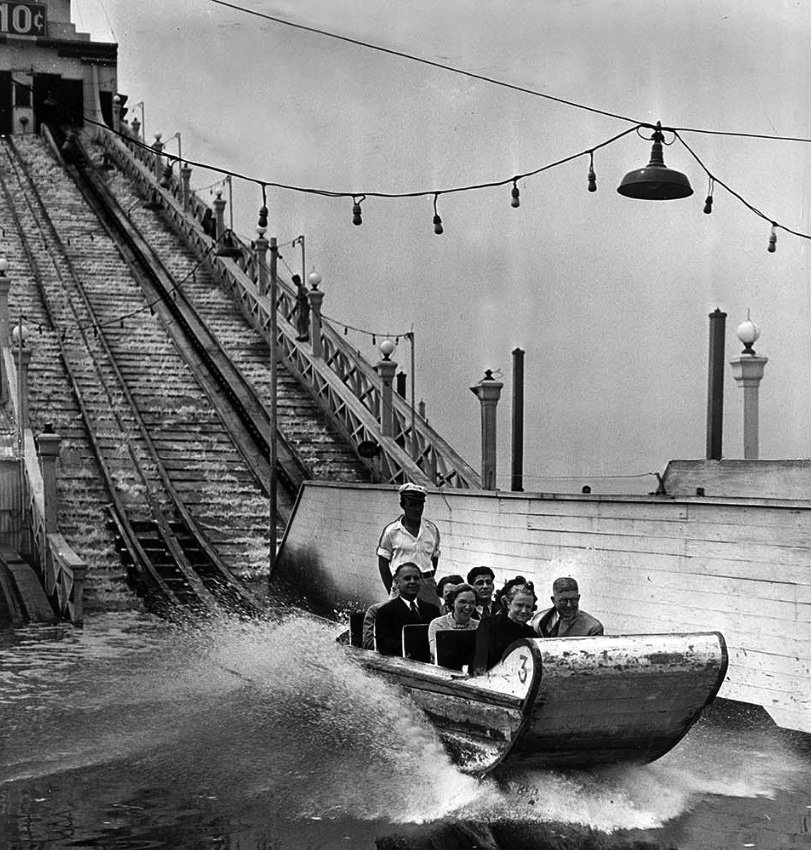 |
|
| (1938)*^# - People dressed up in their Sunday best take a ride on Ocean Park’s Chute-the-Chutes. |
Historical Notes The Chute the Chutes closed permanently in the mid-1940s when an accident claimed the life of a little boy. He stood up and fell out of the boat as it slid down the ramp. Four years later Harry Cooper's Kiddy Town opened at the bottom of the ramp where the pool stood. This enclosed area had a miniature roller coaster, an airplane ride and several small kiddie car rides.^# |
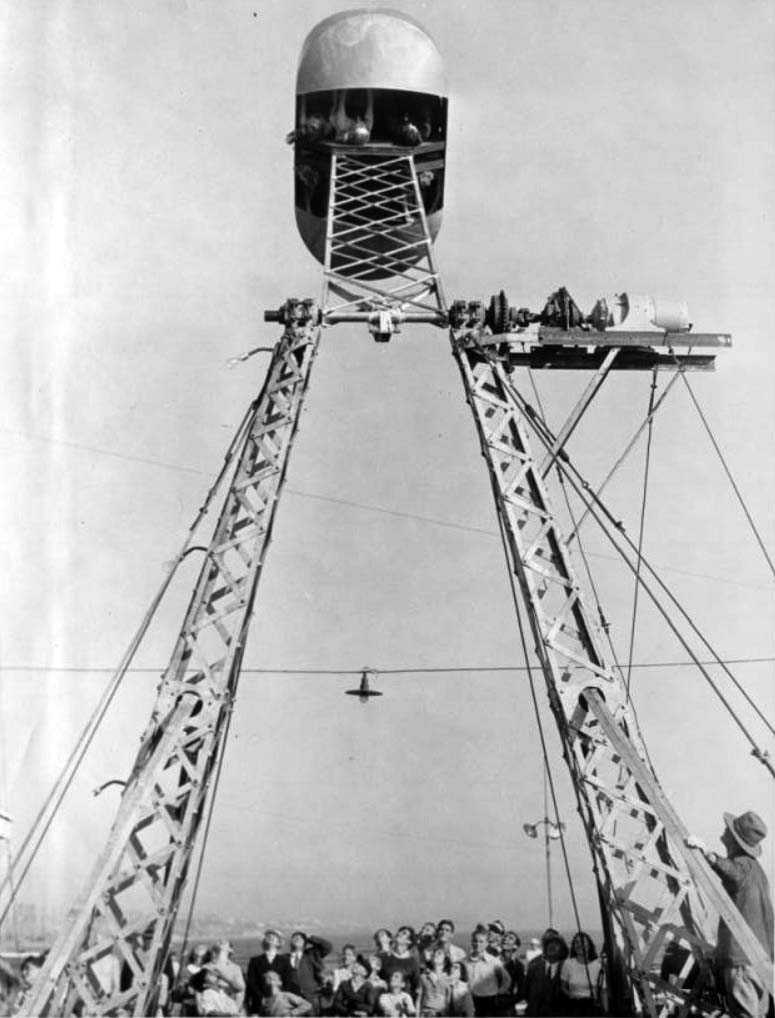 |
|
| (1934)^^ – A small crowd of people gape over their heads at the "Venice Gondola" ride in which a capsule of people is swung in a vertical circle. |
Historical Notes Typed note reads: Latest Beach Thriller: Designed and built by John Branson, this new pleasure gondola is constructed of 20 foot steel girders with a passenger gondola made of duraliuminum [sic] scating [sic] six passengers. The gondola is attached to a cross bar on top of the girders, the gondola swinging into the air at the height of 40 foot. The passengers are strapped in with airplane belts. It travels at a speed of 55 miles per hour. |
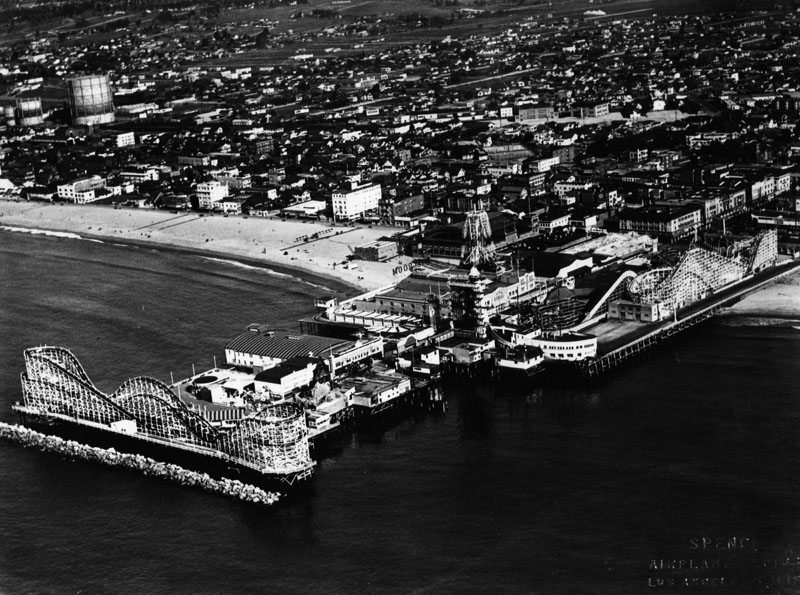 |
|
| (ca. 1930s)* - Aerial view of the amusement park at Venice beach with city in the background. |
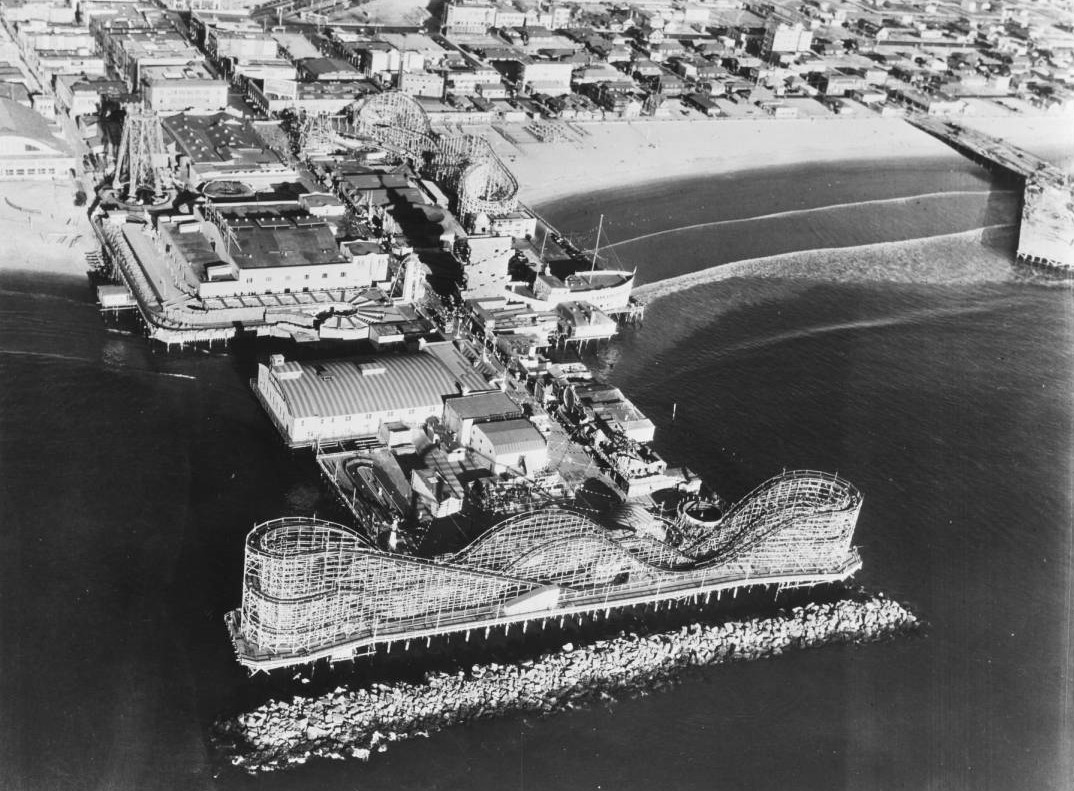 |
|
| (1933)^^ - Aerial view of the Venice Pier showing a breakwater jutting from the water, just behind which a large roller-coaster ends the pier. The pier continues backward, with a racetrack at left, along with shops and a second roller-coaster at right. |
* * * * * |
The Pike
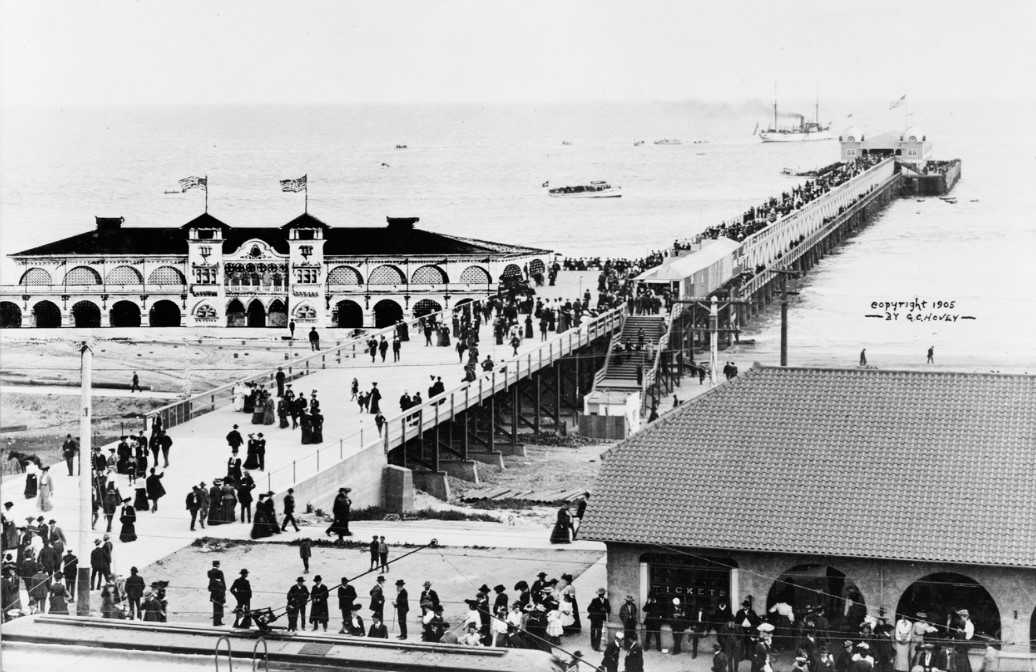 |
|
| (1905)^ - Panoramic view showing crowds of people on the Long Beach Pier and boardwalk. |
Historical Notes "Pike" was the name of the wooden boardwalk connecting the Pine St. incline of the Long Beach Pier west along the shoreline to The Plunge bath house. It gradually grew in length, was widened again and again and was later poured in concrete and illuminated with strings of electric bulbs as "The Walk of a Thousand Lights", the midway anchoring the widely dispersed attractions and "The Pike" changed context from the original wooden boardwalk to the entire amusement zone.^ |
 |
|
| (ca. 1905)^*** – View showing the Long Beach Pier. In the foreground can be seen young bathers, some which are using a rope to maintain balance in the water. |
Historical Notes Subsequently, the area became known as the Pike and was Long Beach’s entertainment center for both local residents and tourists. Visitors could rent swimming suits, change their clothes in the bath house and swim in the ocean or later in a heated, indoor, salt-water plunge. They could also ride a roller coaster or other rides, eat lunch or dinner, purchase specialty items, attend movies or vaudeville shows, dance in ballrooms or just sit and watch their fellow citizens. |
 |
|
| (ca. 1908)^*** – Panoramic view showing the Pike and Long Beach shoreline as seen from the end of the pier. The Long Beach Bath House can be seen at center-right. |
Historical Notes Stretching Pine Avenue south from Ocean Avenue into the Pacific Ocean, the Long Beach Municipal Pier had an upper and lower deck to a service building on the end. Sheltered at the mouth of the Los Angeles River, the public pier served a range of purposes, primarily for trade and commerce, servicing freight and passenger shipping, but also served anglers fishing as well as pedestrian strolling. A simple wooden boardwalk was laid directly atop the sand west along the shoreline connecting the pier to the new bathhouse.^ |
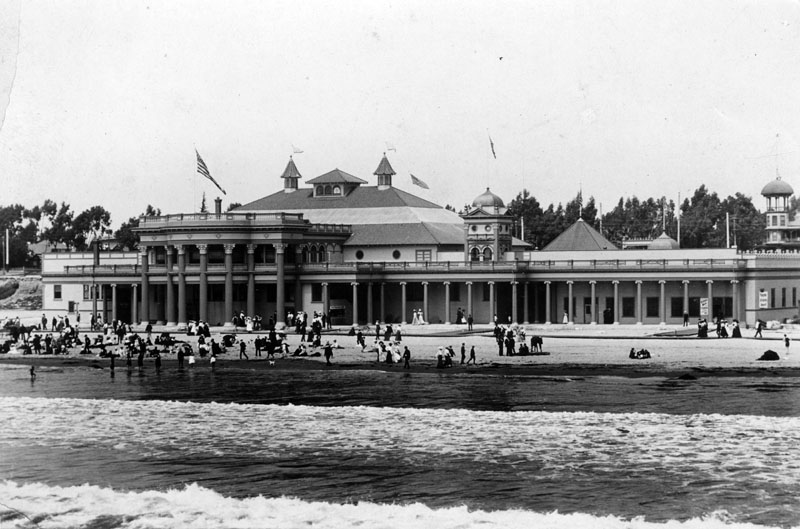 |
|
| (ca. 1905)* - Groups of people are sitting on the beach, swimming, or strolling in front of "The Plunge", the ornate bath house in Long Beach. An American flag flies over the portico on top of the columned entrance. A horse and buggy stands on the beach, left. |
Historical Notes Started in 1902, The Pike ran until 1979. When the Pacific Electric line to Long Beach was built, the Long Beach Bath House and Amusement Company built this bath house on the beach near the end of the street car line.* |
 |
|
| (ca. 1907)^ - Panoramic view showing the Long Beach Bath House and Board Walk. |
Historical Notes With the opening of the Bath House, Long Beach boasted the only institution of the kind within a radius of many miles. As this and other attractions were added, people from inland began to flock to Long Beach to pass the weekends at the beach city, and many who came thus to play remained as residents. The Long Beach Bath House and Amusement Company constructed a boardwalk 12 feet long along the beach and later a 15 foot walk replaced the smaller one until eventually the present 35 foot cement walk was constructed. |
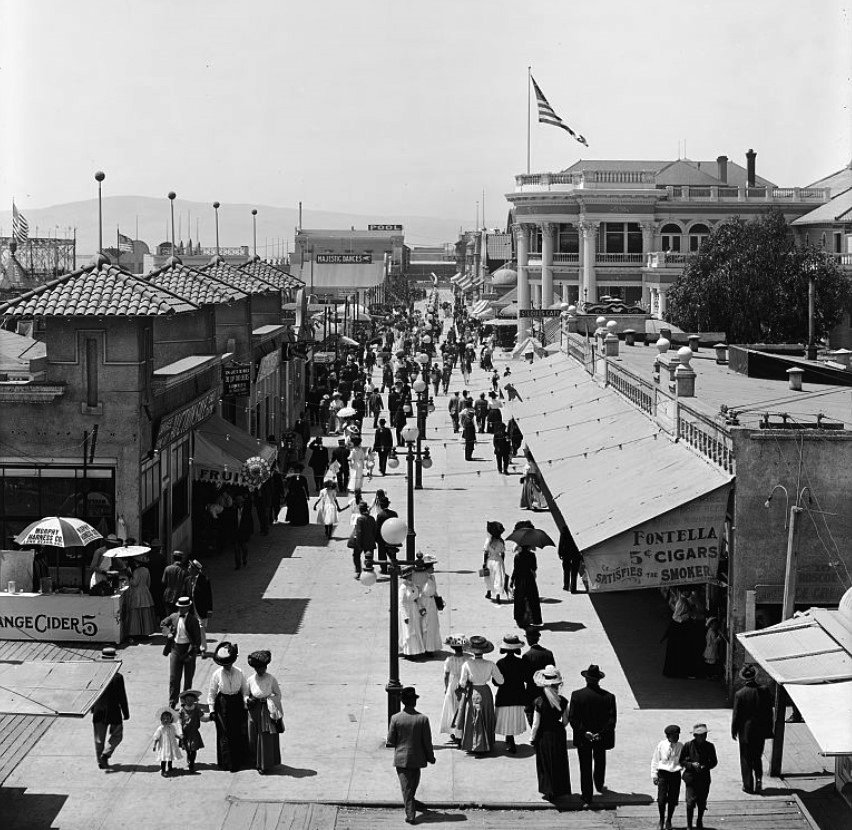 |
|
| (ca. 1910)* - View showing the Long Beach Pike. Well-dressed tourists stroll down the wooden planks of the boardwalk with the Plunge bathhouse seen in the background. Photo Source: Library of Congress |
Historical Notes As it grew from a simple beach access made of planks to a midway of concessions, it included The Plunge bathhouse, Sea Side Studio souvenir photography, the Looff carousel, McGruder salt water taffy, pitch and skill games, pony rides, goat carts, fortune teller, weight guesser and a variety of dark and thrill rides, amusements and attractions large and small. The Long Beach Pike was considered to be the West Coast's Coney Island. It featured some of the world’s most innovative rides and roller coasters. |
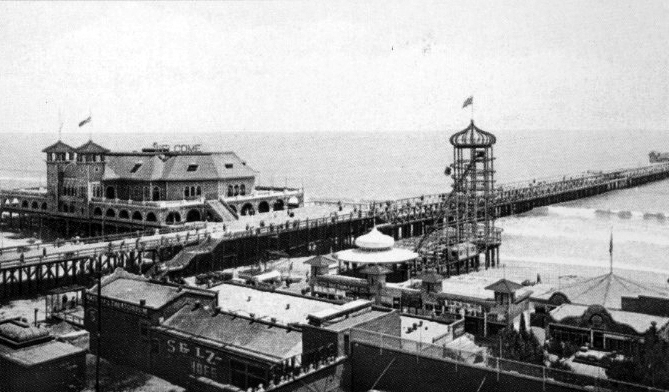 |
|
| (ca. 1915)^^** - Postcard view of the Long Beach Pike. The tall structure to the right of the pier is the thrill ride called Bisby's Spiral Airship. |
Historical Notes In June 1907, the first roller coaster on the Pike opened for business. A variety of other rides and amusements, including Ferris wheels and merry-go-rounds, would follow over the years as the Pike grew to include a bustling midway. |
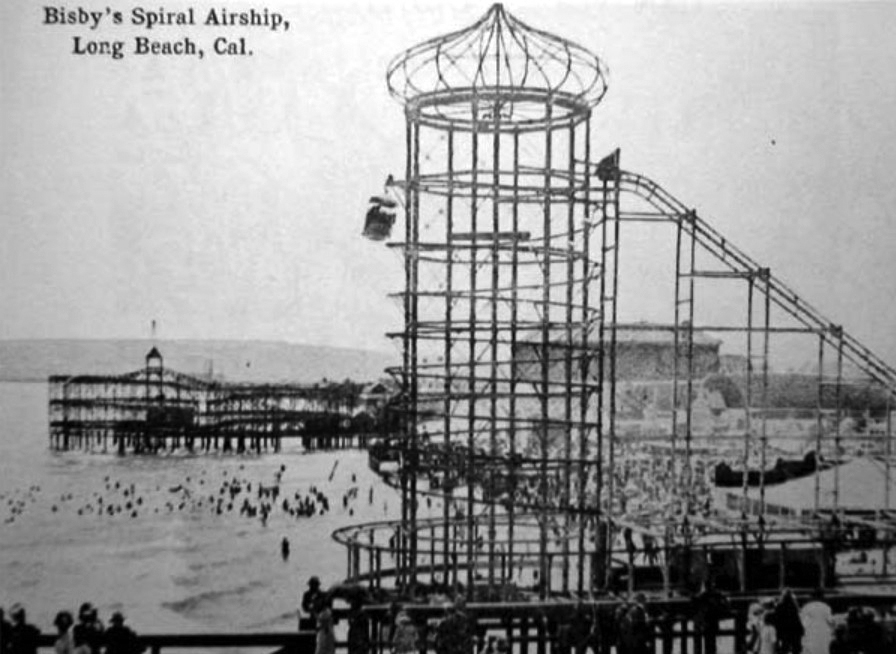 |
|
| (ca. 1910s) - Close-up view showing Bisby's Spiral Airship at the Long Beach Pike. |
Historical Notes One of the earliest suspended roller coasters was known as Bisby's Spiral Airship, built at the Long Beach Pike in the early 1900s. Riders on Bisby's Spiral Airship rode in square gondolas suspended from the track above, which were then carried via lift hill to the top of a tower. The gondolas then rolled down the track, which spiraled down the tower back to the loading platform. The attraction operated at least until the mid 1910s.^ |
 |
|
| (1918)* - Flying airplanes twirl around a pole by the entrance to the Jack Rabbit Racer roller coaster at The Pike amusement park south of Ocean Blvd. in Long Beach. The roller coaster is built on a pier and extends into the ocean. |
Historical Notes In 1915, the Jackrabbit Racer roller coaster opened for business, replacing smaller coaster taken down in 1914. An amusement pier, most often called Silver Spray Pier, was built next to the coaster at the foot of Cedar Avenue. |
.jpg) |
|
| (ca. 1918)# - Detailed view of the north and west sides of the Pike's Jack Rabbit Racer roller coaster, as well as other attractions. Among them are the "Kandy Box Revue" and "Baby Cecil." The end of Pine Avenue Pier is prominent in the background. |
Historical Notes Local urban legends suggest that Long Beach Poly High School's mascot, the jackrabbit, was named after this roller coaster. # The Jack Rabbit Racer roller coaster stayed in operation until 1930 when it was replaced by the Cyclone Racer.* |
 |
|
| (1918)* - Crowds mill down the midway in this view of The Pike amusement park south of Ocean Boulevard in Long Beach. Included in the enticements are Lipton, Jevne's, Seaside Studio, Parmonell and other various souvenir, candy, and gift shops. |
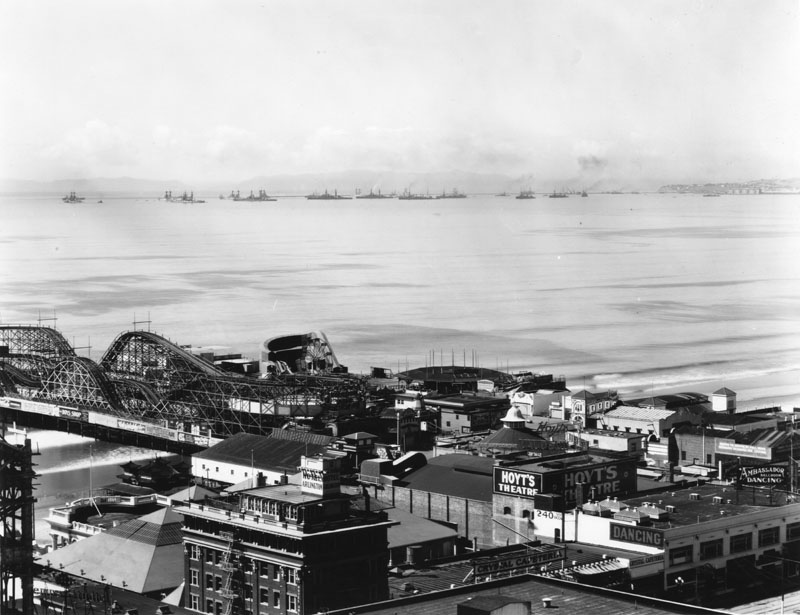 |
|
| (ca. 1920)* - A view of The Pike amusement park in Long Beach. The roller coaster extends down the pier; underneath it is the Long Beach bath house. The Hotel Arlington is bottom, left. Next to the hotel is the Crystal Cafeteria and next to the cafeteria is the Ambassador ballroom dancing establishment. Hoyt's Theatre abuts the Ambassador. On the horizon are several naval or Coast Guard ships. |
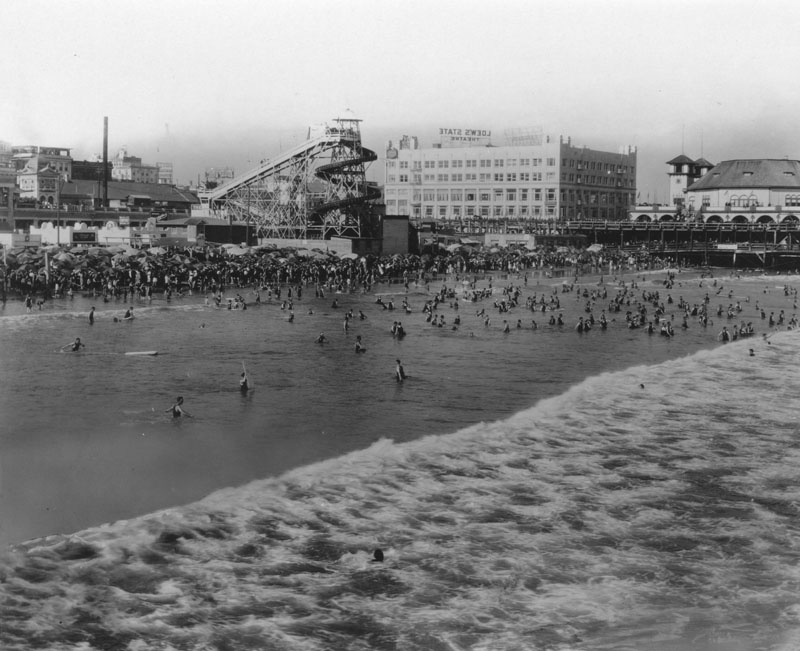 |
|
| (ca. 1920)* - Beach umbrellas and deck chairs cover the beach in front of The Pike as swimmers crowd the surf. On the left, the pier in front of the Municipal Auditorium extends into the ocean. Behind the auditorium is Loew's State Theatre. The 'Bamboo Slide' towers over The Pike's concession stands whose tops are visible behind the sea of beach umbrellas. Behind The Pike, commercial buildings cover every inch of real estate. |
.jpg) |
|
| (1920s)^^ - View showing the Bamboo Slide at the Pike in Long Beach. |
Historical Notes The Bamboo Slide consisted of a tall multi-level staircase leading to the top of a tower. Upon reaching the top you would slide down the circular slide on a burlap bag. The climb to the top was as much fun as the slide! |
 |
|
| (1920s)#**# – Postcard view showing an overcrowded beach full of people and umbrellas with the Bamboo Slide in the background. |
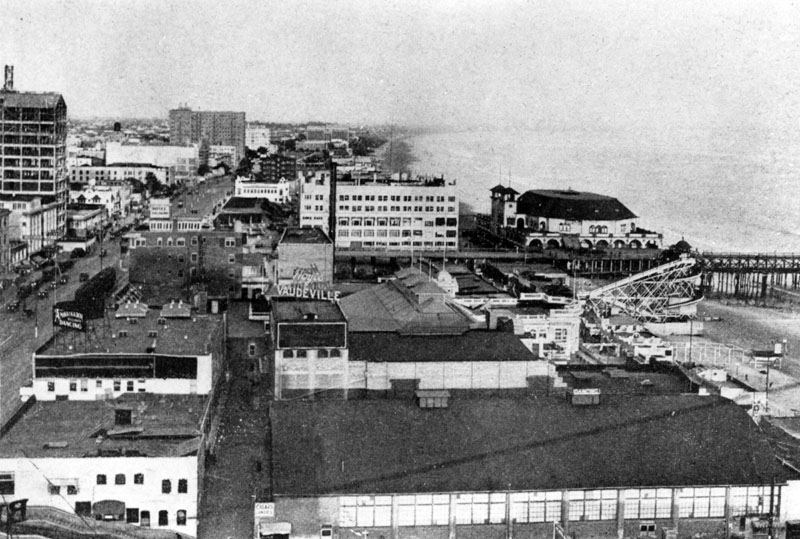 |
|
| (1924)* - Aerial view of The Pike, the Municipal Auditorium, right, and the pier in Long Beach. A sign, Hoyt's Vaudeville, identifies Hoyt's Theater directly behind The Pike's roller coaster. The twelve story Heartwell Building at 19 Pine Avenue, left, is under construction. The wide boulevard following the shore is Ocean Boulevard. |
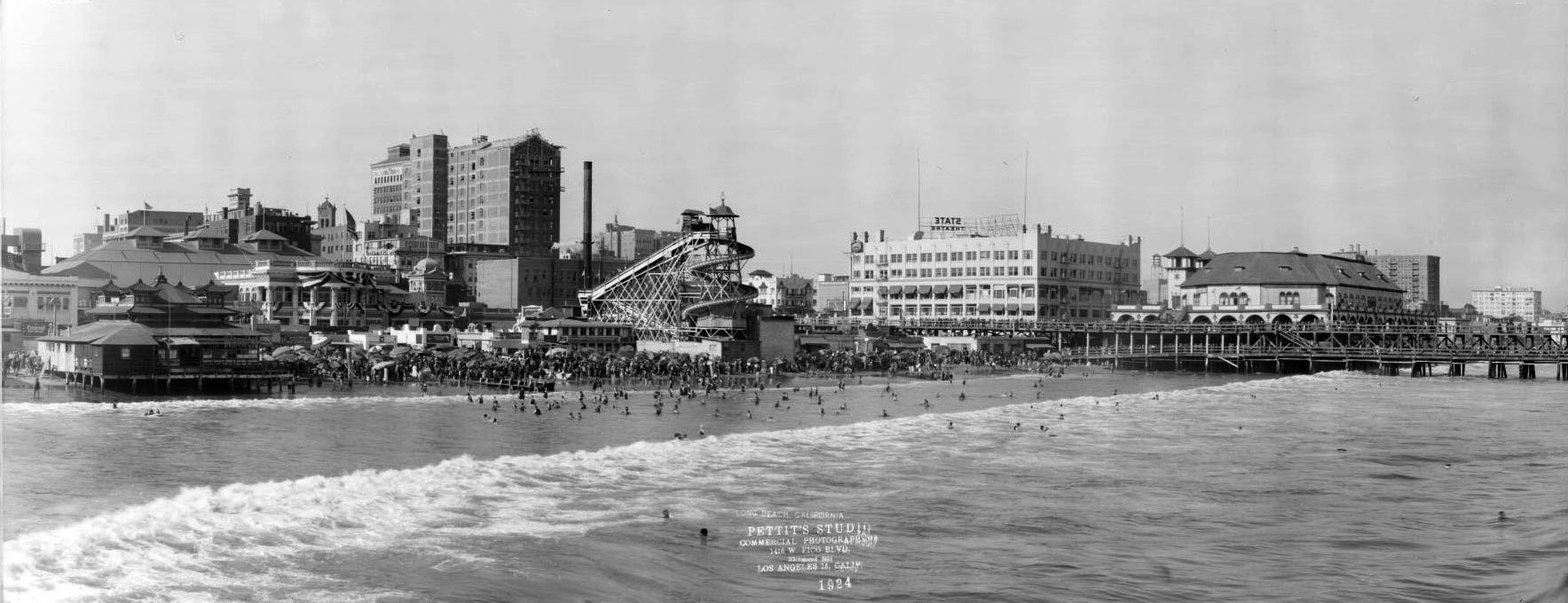 |
|
| (1924)#* - Panoramic view of the beach, Pike, and pier in Long Beach, taken from just south of the beach, facing northeast. The tallest structure in the background is the recently completed 12-story Heartwell Building. |
Historical Notes Photo was possibly taken from the pier that jutted into the water and supported a roller coaster, at that time the Jack Rabbit Racer. |
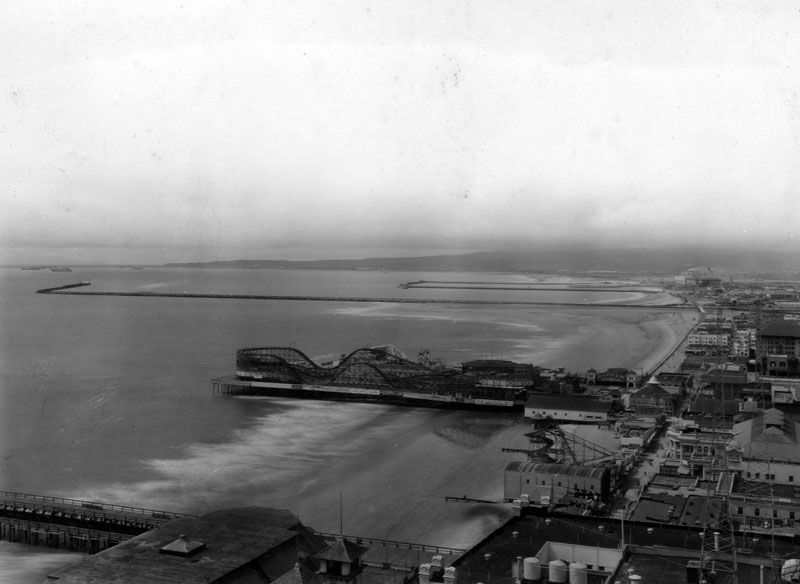 |
|
| (ca. 1928)* - The Pike and Pleasure Pier, center, jut out into the ocean from the shore. The ornate bathhouse with its portico sits in the midway. Advertisements for the various attractions at The Pike are on the side of the pier underneath the roller coaster. Portions of the Virginia Hotel and its tennis courts are just beyond The Pike and breakwaters and ocean vessels are on the horizon. |
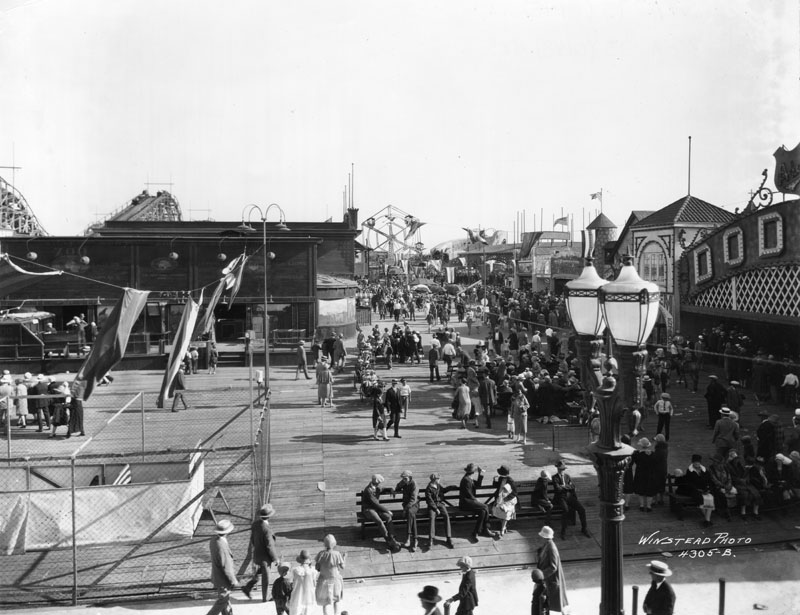 |
|
| (ca. 1929)* - People mill among the rides and concessions stands at The Pike amusement park south of Ocean Blvd. in Long Beach in this view looking southward. The Jack Rabbit Racer roller coaster is visible in the background, left. |
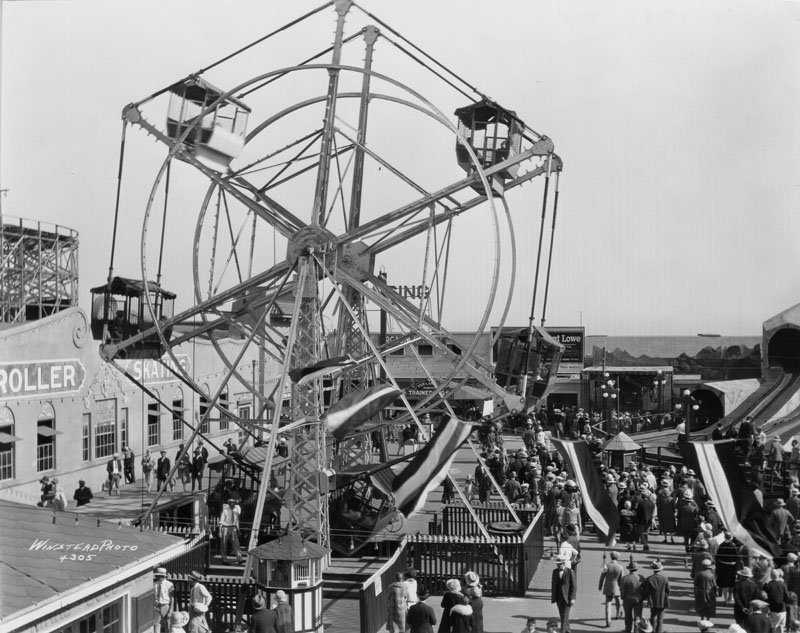 |
|
| (ca. 1930)* - People mill among the concessions and rides at The Pike amusement park south of Ocean Blvd. in Long Beach. A roller skating rink and a dog show are offered amusements. People are riding the ferris wheel whose carriages are completely enclosed with mesh. A glimpse of the roller coaster is on the left. |
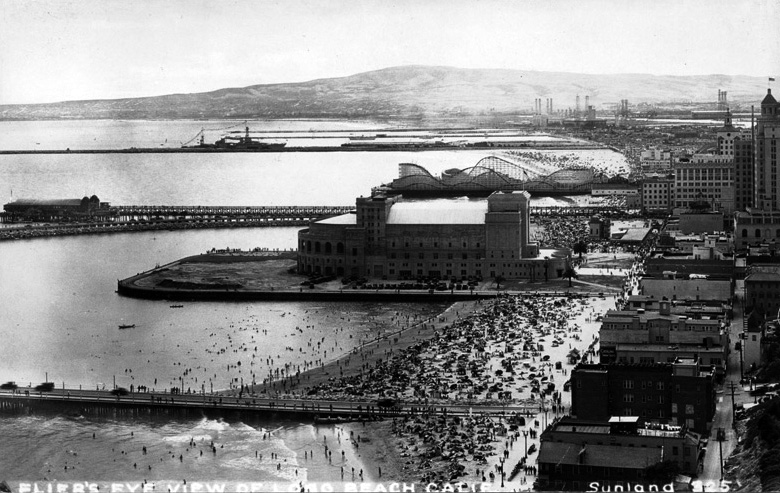 |
|
| (1930s)^^^ - Beachgoers swamp the coast of Long Beach. The Pike Amusement Park with its towering roller coaster is seen in the background. |
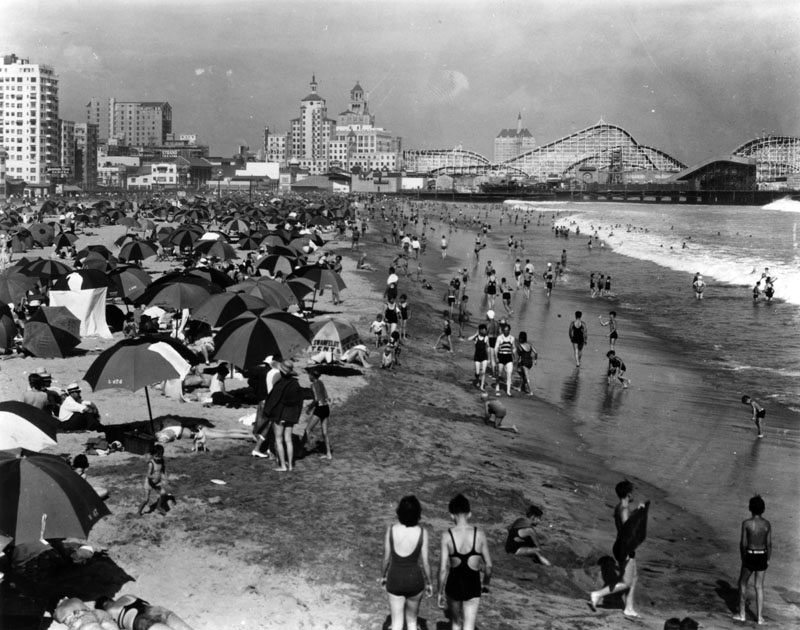 |
|
| (1930)* - A view of the beach at Long Beach looking south toward the Pike. The Villa Riviera Hotel is just visible behind the roller coaster. Umbrellas cover the beach and the surf is crowded with swimmers. |
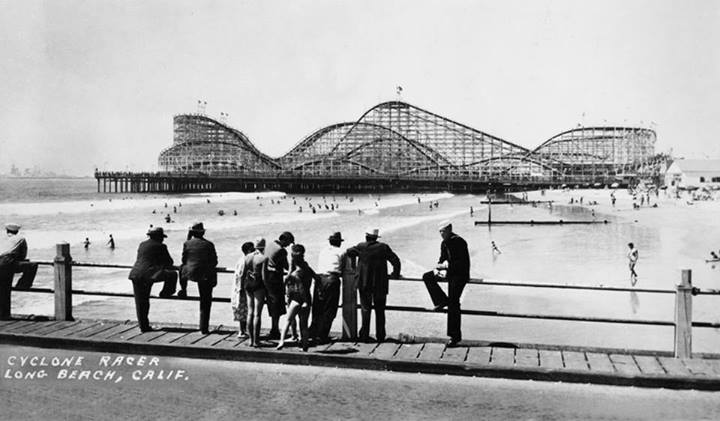 |
|
| (1930)*^^* - A group of people look acroos the beach toward the newly constructed Cyclone Racer. |
Historical Notes The Pike was most noted for the Cyclone Racer, a large wooden dual-track roller coaster, built out on pilings over the water. It was the largest and fastest coaster in the U.S. at the time. They called it 'racer' because there were two trains on two separate tracks that raced one another from start to finish.* |
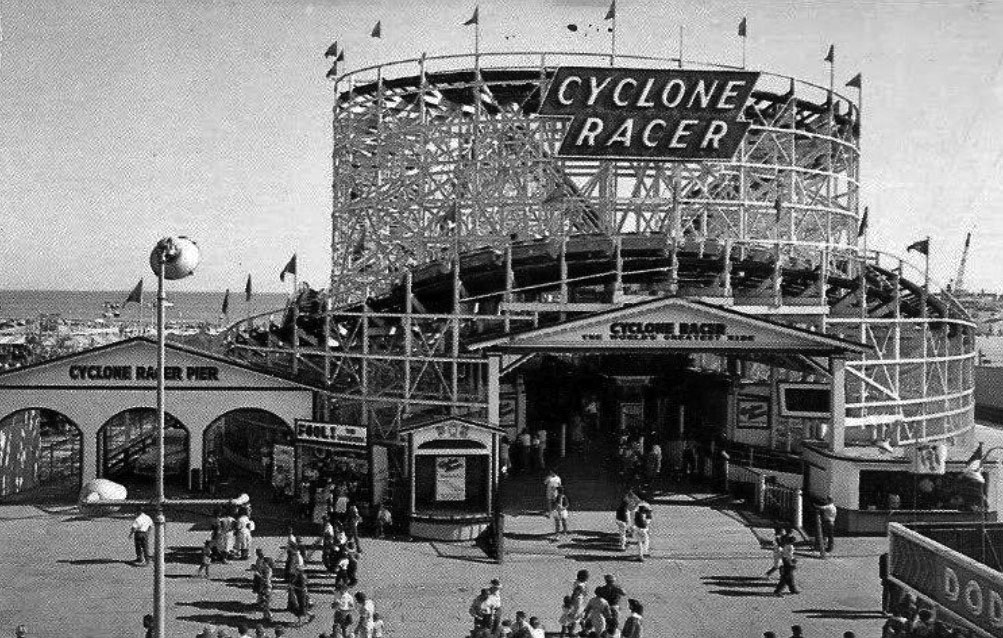 |
|
| (ca.1930s)*^*# – Postcard view showing the entrance to the CYCLONE RACER at the Pike Amusement Park. |
.jpg) |
|
| (1930)* - Close-up view of the newly built Cyclone Racer with its dual track. |
Historical Notes The Cyclone Racer was built in 1930 to replace the Jack Rabbit Racer. It had a dual-track (two trains could launch side-by-side at the same time), racing wooden roller coaster, the brain child of Fred Church and built by Harry Traver.^ |
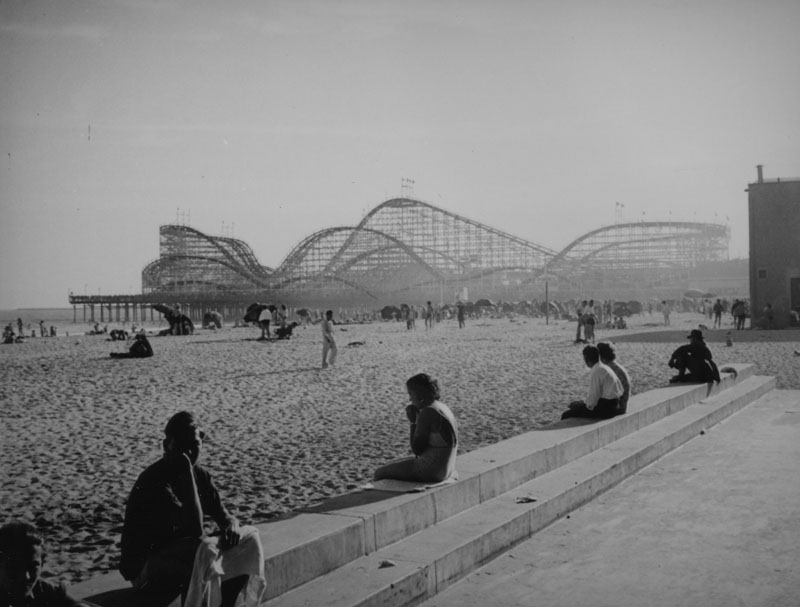 |
|
| (ca. 1940)* - People enjoy a day at the beach either in the water, strolling on the sand, sitting under umbrellas or visiting The Pike in this Long Beach scene. The Cyclone Racer roller coaster is seen in the background. |
Historical Notes To increase thrills, the Cyclone Racer was built on pilings over the ocean, several hundred feet beyond the shore. Eventually the entire pier stood over sandy beach, not water, because of the sand deposition due the slowing of water caused by the new harbor expansion and breakwater. Over 30 million riders rode on the Cyclone before it closed in 1968.^ |
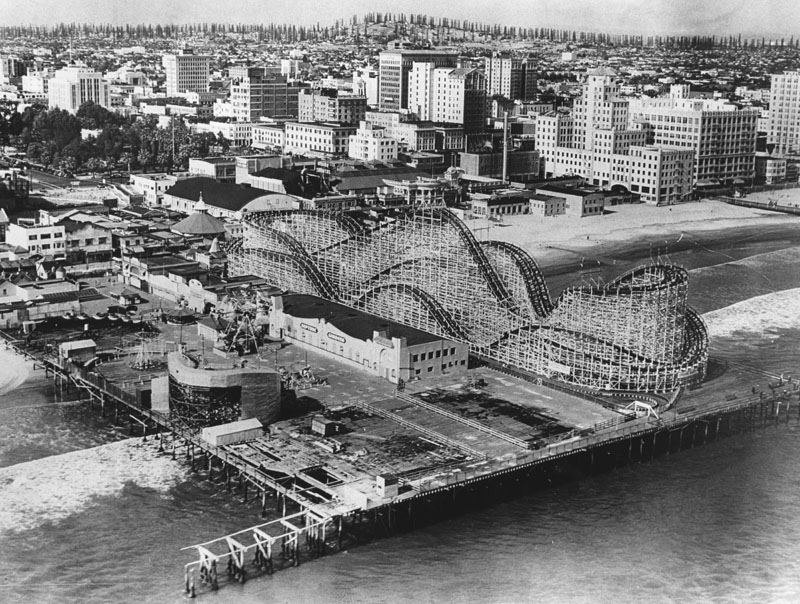 |
|
| (ca. 1940)* - Aerial view of a fairly deserted Pike amusement park and downtown Long Beach. The large roller coaster, the Cyclone Racer (center) is the largest attraction at the park. In the distance is Signal Hill covered with oil derricks. Because of its prickly appearance it became known as “Porcupine Hill”. |
.jpg) |
|
| (ca. 1940)* - Aerial view of fairly deserted Pike amusement park south of Ocean Blvd. in Long Beach and the surrounding streets. The Pike extends to the ocean's edge while beach flanks both sides of the amusement park. |
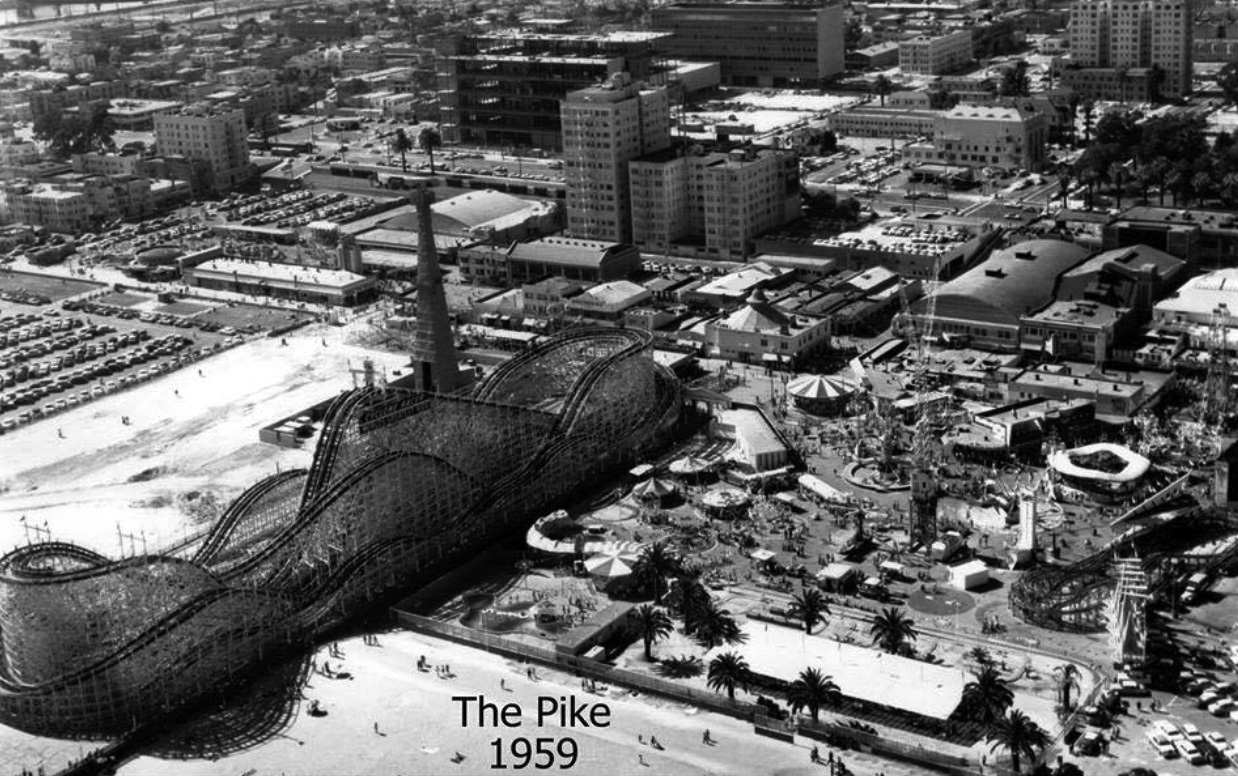 |
|
| (1959)^.^ – Aerial panoramic view showing the Pike with its large wooden dual-track roller coaster. |
Historical Notes The Pike operated under several names. The amusement zone surrounding the Pike, "Silver Spray Pier", was included along with additional parking in the post World War II expansion; it was all renamed Nu-Pike via a contest winner's submission in the late 1950s, then renamed Queens Pike in the late 1960s in homage to the arrival of the Queen Mary ocean liner in Long Beach.^ |
 |
|
| (1958)*^# – Aerial view of the Cyclone Racer at Nu-Pike, Long Beach. The Pike was renamed Nu-Pike in the late 1950s and Queens Pike in the late 1960s. |
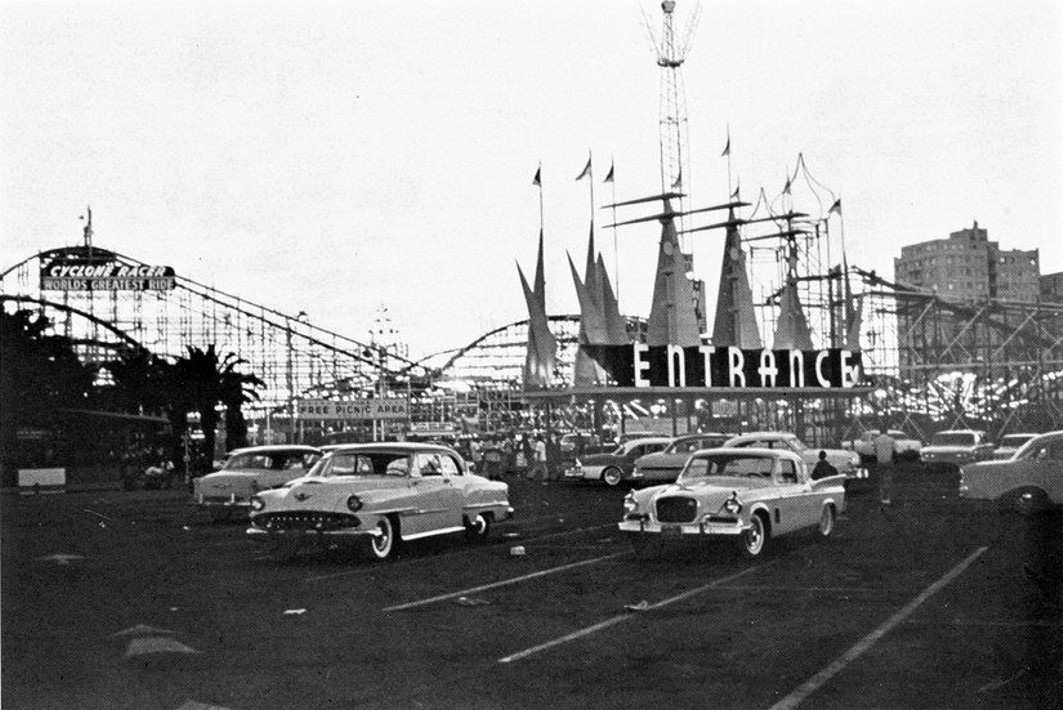 |
|
| (1960)*^ - Entrance to The Pike with the Cyclone Racer seen in the background. |
Historical Notes In 1969, the name changed to Queen's Park, to coincide with the public opening of the historical ocean liner RMS Queen Mary, which the city had purchased as a combination tourist attraction and hotel. The park retained this name until closing and demolition (1979–1980). Most locals continued calling it The Pike. |
 |
|
| (1970s)* - The Long Beach Pike in its declining years. |
Historical Notes In 1979 the Pike amusement zone was officially closed and demolished. By the time the lease with the city ended, The Pike had fallen into disrepair and most of the businesses had already left. The City of Long Beach then removed the remaining structures. Various plans for development of the area took form over the next twenty years. In 1999, the California Coastal Commission approved a plan for the construction of The Pike at Rainbow Harbor commercial and entertainment complex in the downtown shoreline area (not built until 2003). The name is only a nod in reference to the original amusement zone, bathing beach and boardwalk — the outdoor shopping mall bears no resemblance whatsoever to its historic predecessor.^ |
* * * * * |
More Historical Early Views
Newest Additions
Early LA Buildings and City Views
History of Water and Electricity in Los Angeles
* * * * * |
References and Credits
* LA Public Library Image Archive
# Long Beach Public Library Digital Archive
** flickr: Magic Mountain Rollercoaster
^# Westland.net: POP; Ocean Park Pier
#* Huntington Digital Library Archive: Arcadia Roller Coaster; Arcadia Roller Coaster 2
#**Los Angeles Westerners Corral: Venice Miniature Railway
#^^Santa Monica Public Library Image Archive
^**Oviatt Library Digital Archives
*^*Paradise Leased: Arcadia Hotel
***Los Angeles Historic - Cultural Monuments Listing
^#*Facebook.com - City of Angels: Alligator Farm
+#+Silentlocations.wordpress.com: Venice Minitiare Railroad
*^#LA Times Framework: Midway Plaisance at Venice; Chute-the-Chutes
^*#California State Library Image Archive
***^Theme Park Insider: L.A.Thompson, The Father of the Themed Roller Coaster
^^**Flickr.com - Floyd B. Bariscale Photostream: Lincoln Park Carousel
*^*^Santa Monica Beach Stories
^*^#Facebook.com - Bizarre Los Angeles
^*##Calisphere: University of California Image Archive
*##*AkamaIdivers.com: Pacific Ocean Pier
^##^LincolnHeightsLa.com: Selig Zoo
*#*#Venice Miniature Railroad - Jeffrey Stanton
*#^#Flickr.com: Walking Over Santa Monica
^#*#Venice History: Roller Coasters and Carousels; Venice Timeline
#^#*Denver Public Library Image Archive
^#^Forum.Skyscraperpage.com: Mt. Lowe Railway Profile; Venice Miniature RR; Chutes Theater; Chutes Park; Selig Zoo; Chutes Water Slide; Chutes Postcard
^ Wikipedia: Venice; The Pike; Pacific Ocean Park; Busch Gardens; Marineland; Knott's Berry Farm; Universal Studios; Magic Mountain; Disneyland; Frederick Ingersoll; Chutes Park; Mt. Lowe Railway; Selig Polyscope Company; History of Santa Monica; Los Angeles Alligator Farm; Venice Canal HIstoric District
< Back
Menu
- Home
- Mission
- Museum
- Major Efforts
- Recent Newsletters
- Historical Op Ed Pieces
- Board Officers and Directors
- Mulholland/McCarthy Service Awards
- Positions on Owens Valley and the City of Los Angeles Issues
- Legislative Positions on
Water Issues
- Legislative Positions on
Energy Issues
- Membership
- Contact Us
- Search Index